

The 13 Best Places to Visit in the Outback & Travel Itineraries
- Pinterest 196
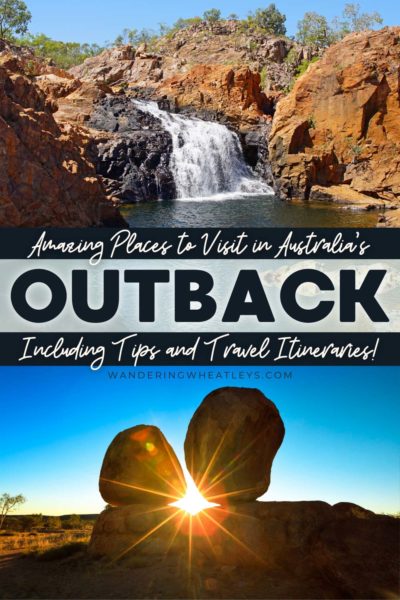
The Red Centre of Australia is a fun place to explore – the amazing landscapes make this one of our favorite spots in Australia. With barren deserts and long drives, a road trip in the Outback has many amazing places we did not expect to see. The scenery is unique with mountain ranges, massive canyons, and gorges with permanent watering holes.
While the Outback may not be as “sexy” as a trip to the Great Ocean Road , Sydney beaches, or tropical Queensland , something about the Outback’s raw beauty and spiritual history makes it hard to beat.
The Outback is a perfect place for a 7-14 day road trip. We cover all the highlights in the Outback, a survival guide, and various itineraries for those short on time or looking for a week-long road trip through the Red Centre.
Check out our list of the 13 best places to see in the Outback below!
Content and photographs provided by Yana Kogan and Timon .
Disclaimer: This post may contain affiliate links. If you make a purchase or booking through one of our links we may earn a small commission (don’t worry, it’s at no extra cost to you).
The Outback Travel Guide
Best time to visit the outback.
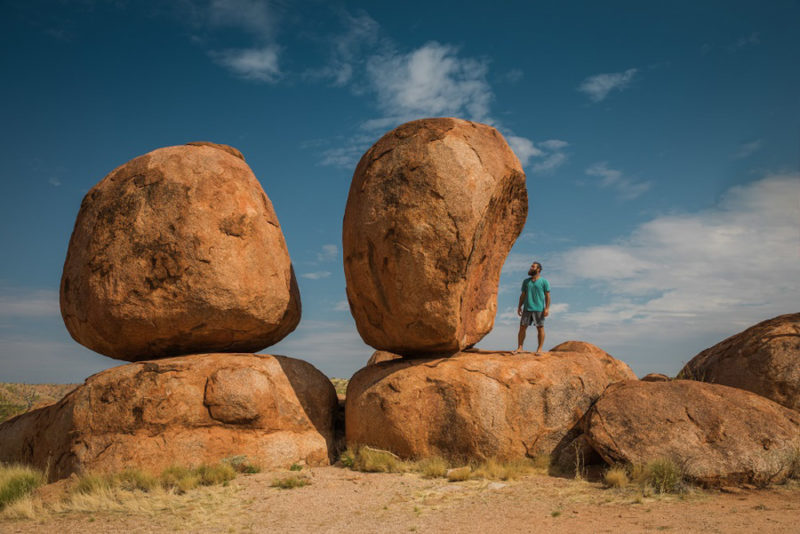
The best time to visit is during the winter months (June – September) when the days are hot but manageable. The temperature drops significantly during the night, so having layers and a light jacket would be a good idea.
Visiting the Darwin region in the summer (wet season) should be avoided at all costs. Not only are temperatures extremely high, but it is also monsoon season and roads are commonly flooded.
How to Get to The Outback
The cheapest flights are with TigerAir. Flights from Brisbane start from $150 to Darwin or $270 to Alice Springs. From Sydney, flights start from $160 to Darwin or $240 to Alice Springs. Flights from Melbourne start from $180 to Darwin or $200 to Alice Springs.
Check Flight Prices on Skyscanner
Thrifty AU has locations in Darwin and Alice Springs, among other major cities in Australia. They have very competitive rates. Make sure to check and understand the agreement terms for unsealed roads. Most small vehicles do not allow for use off-road, and penalties are excessive.
Rentals in the Outback typically come with 100 kilometers (62 miles) per day with overage charges of around $0.30 per km. Although 100 km per day may seem like a lot, driving distances in the Outback can easily exceed that.
Routes to The Outback
Driving from queensland.
Townsville is the main gateway into the Outback from Queensland. The Flinders Highway (A6) originates in Townsville and connects with Mount Isa and on to the Stuart Highway (87). It is 1,600 kilometers, or two full days driving without stops, to get from Townsville to the Stuart Highway.
The road is sealed with speed limits of 100 km/h in Queensland and 140 km/h in the Northern Territory.
4WD Route From Cairns
If Darwin is your first destination in the Outback and you have time to spare, the Savannah Way (Highway 1) is an excellent 4WD adventure. The beginning stretch from Cairns to Normanton is a sealed road, although there are creek crossings on this route so it is not advised for 2WD.
The real journey begins after Normanton on the stretch between Burketown and Borroloola, a remote area that requires experienced drivers with high clearance 4WD vehicles. Check conditions before going. This road can be flooded and impassable, especially during the summer.
The Savannah Way is a great resource for itineraries and road conditions, and it has contact numbers for emergencies.
Driving from South Australia
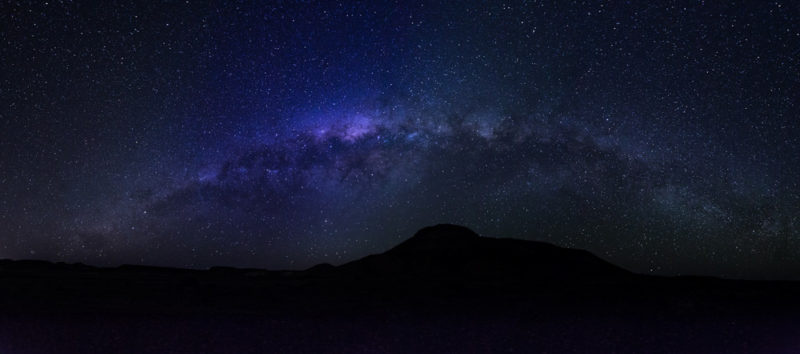
Adelaide is the gateway to the Outback from South Australia. The Stuart Highway originates in Port Augusta, three hours north of Adelaide. From Adelaide to Alice Springs, it is 1,500 kilometers in distance (930 miles), or two very long driving days.
The 13 Best Highlights of the Australian Outback
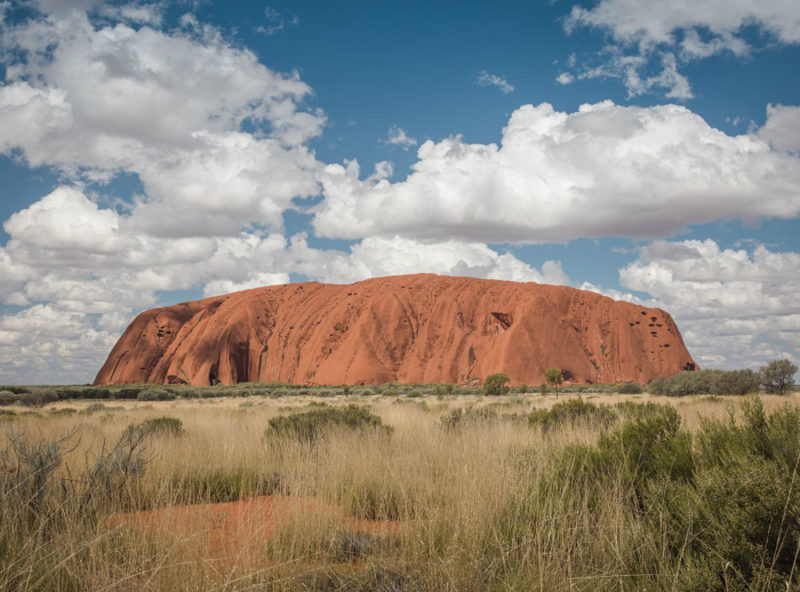
Also known as Ayers Rock, Uluru is the most recognizable landmark in the Outback and one of the top reasons to visit the Land Down Under. Pictures simply cannot do this massive sandstone rock justice. There is something so spiritual being in its presence.
This was one of our favorite places in Australia. We stayed for three days to explore the park and watch the rock glow red at sunrise and sunset. Take advantage of the three-day pass and stay awhile.
Hiking at Uluru
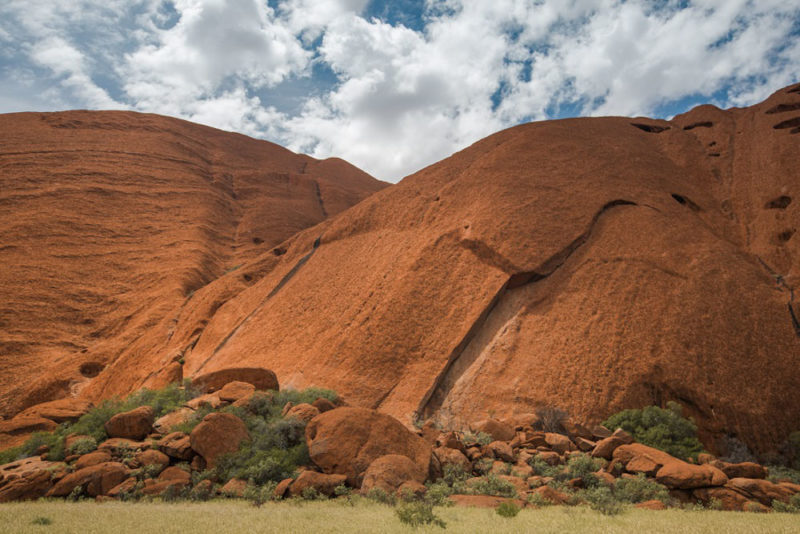
Currently, hiking to the top of Uluru is closed . The local aboriginal Aṉangu tribe does not climb it for spiritual reasons. They also ask that visitors do not climb it out of respect for their traditions.
A good way to explore Uluru is to hike around the base of the entire rock. It is a 10 km (6.2 miles) walk and takes around three hours. The hike begins from the Mutitjulu carpark or Mala carpark. There are several sections along the walk where photography is not allowed as these sites are considered sacred.
Best Sunrise Locations at Uluru
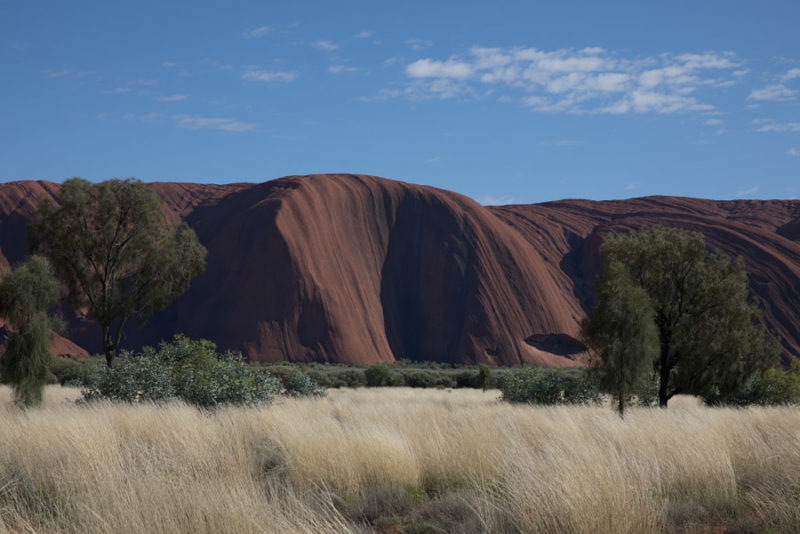
My favorite spot for sunrise is at the end of the sunset car park. There are usually only a few people there. Views are unobstructed with the sun rising behind Uluru.
Although extremely busy, my second favorite spot is at the Uluru sunrise platform. If using a tripod, be sure to show up early for a good spot. This view has the sun rising from behind, which helps capture the glowing red rock.
There are also some nice spots while driving on the road that circumnavigates Uluru.
Best Sunset Locations at Uluru
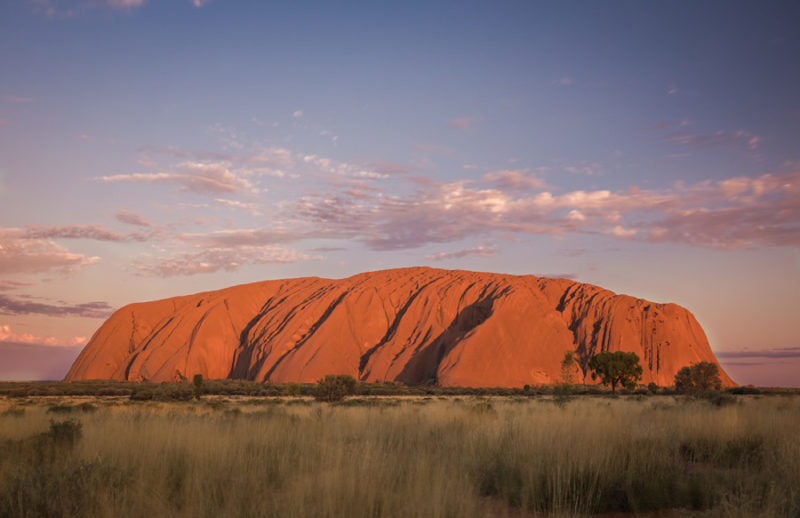
The sunset car park is best for sunset. The crowds will be here watching alongside you, so it is best to arrive one to two hours beforehand. My favorite location is at the very right, after the last few parking spots.
All of the accommodation and shops are located outside the park in the town of Yulara. There is a small IGA supermarket to stock up on supplies. There are several restaurants in the small center of the town. It is a 10-minute drive to the park entry gates.
Entrance Fee for Uluru
The entrance fee to Uluru-Kata Tjuta National Park is $38, valid for multiple entries for up to three days.
The Ayer’s Rock Campground charges per vehicle. The closest free campsite is a 15-minute drive from Yulara at a rest stop along the highway.
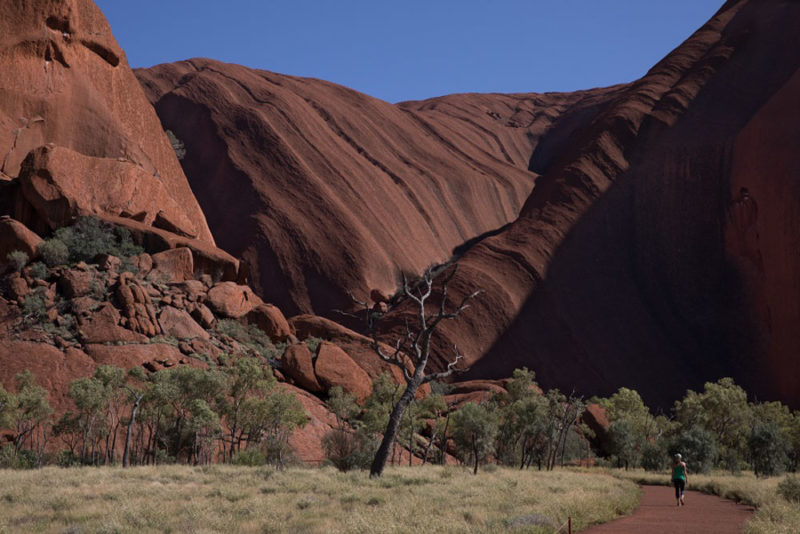
2. Kata Tjuta
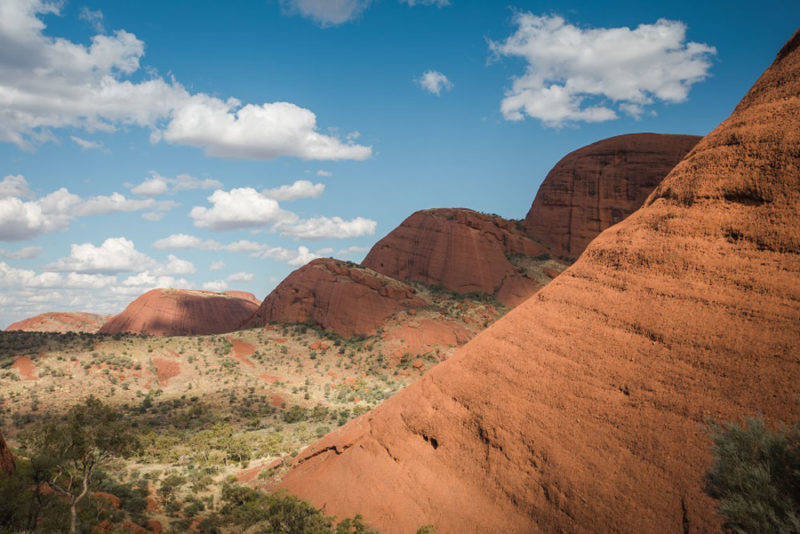
Uluru-Kata Tjuta National Park is not only home to Uluru. Kata Tjuta, also known as the Olgas, is an incredible site in its own right. It is located 45 km (28 miles) east of Uluru, or a one-hour drive.
There are two viewing areas for Kata Tjuta – the one off the main road has panoramic views of all 36 domes but is quite far away. The other is close to the base of Kata Tjuta, but it is somewhat obstructed by trees. My favorite viewing location for photography, including sunrise or sunset, is on the side of the Valley of the Winds access road.
Make sure to explore Kata Tjuta for one day and watch one sunset while visiting the park.
The Valley of the Winds is a 3-hour hike that should not be missed. The hike winds through the rock formations next to Mount Olga and through a very scenic valley. This is my favorite hike in the park.
Entrance Fee
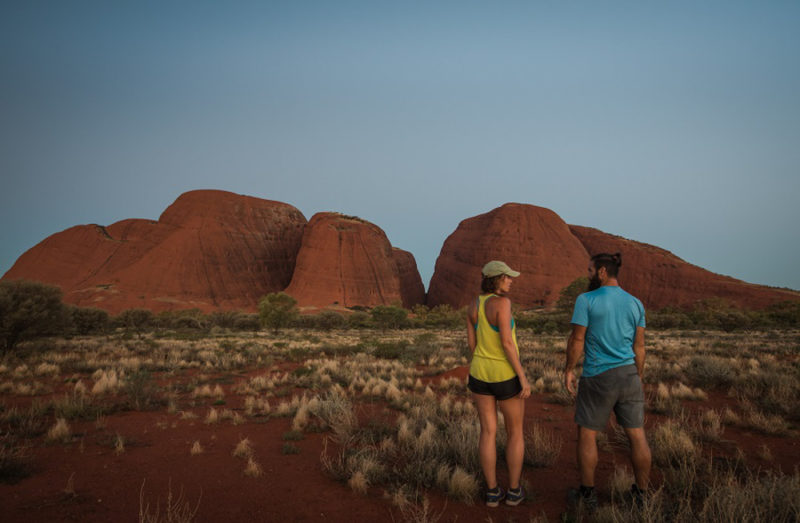
3. Kings Canyon
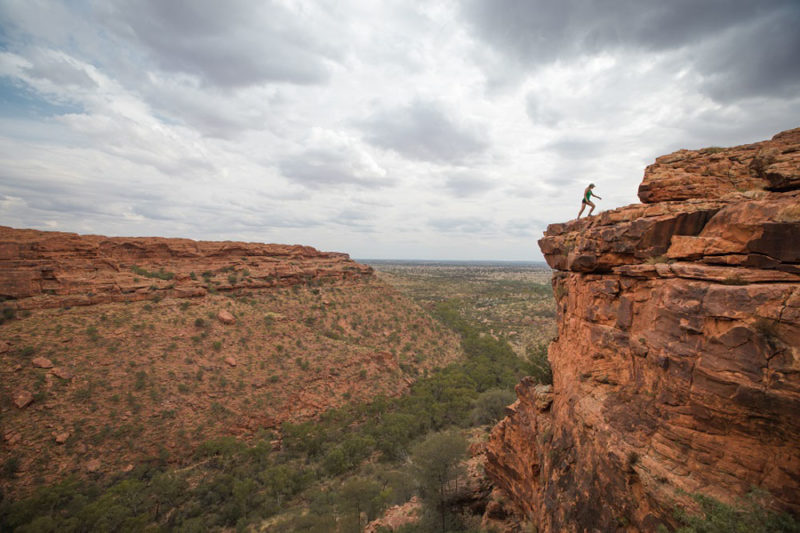
We were pleasantly surprised by this beautiful and massive canyon. The 100-meter (328-foot) cliff walls are sure to make you feel a bit uneasy. It is located four hours north of Uluru, and worth the detour.
There are a couple of walks in the area – the Kings Creek trail is an easy 2 km (1.2 mile) walk that follows the canyon floor.
The best views are on the 6 km (3.7 mile) Kings Canyon Rim Walk. This loop trail has a steep ascent in the beginning and follows the canyon rim allowing for incredible views. There is a short detour that descends down to the Garden of Eden, a permanent waterhole. The entire hike takes about three hours to complete.
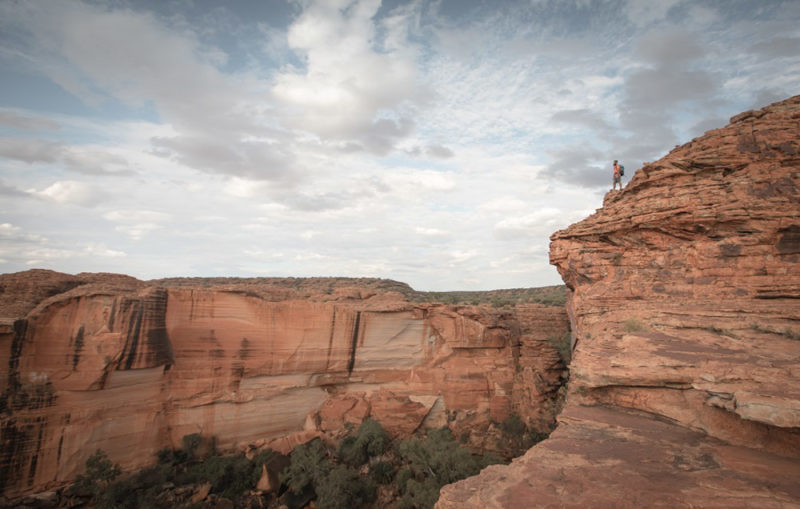
The Kings Canyon Campground has unpowered sites. The first free campground is a rest stop 30 minutes drive toward Uluru.
4. Kakadu National Park
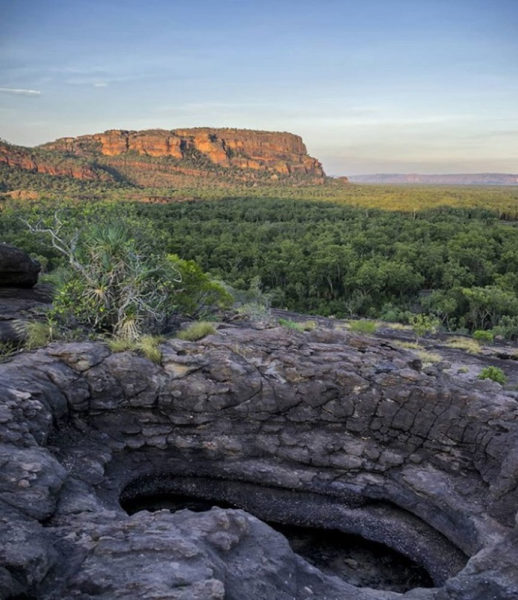
Kakadu National Park, located three hours southeast of Darwin, is the largest national park in Australia. Several different types of landforms define the park, including cliff walls, gorges, and floodplains. The park is known for its waterfalls – Jim Jim Falls, Gunlom Falls, and Twin Falls.
There are many walks throughout the park, the best ones are the Koolpin Gorge Track, the Nawurlandja Lookout, the Barrk Marlam Walk (June – October), and the Twin Falls Plateau Walk. Other activities in the park include boating, fishing, wildlife, and crocodile spotting.
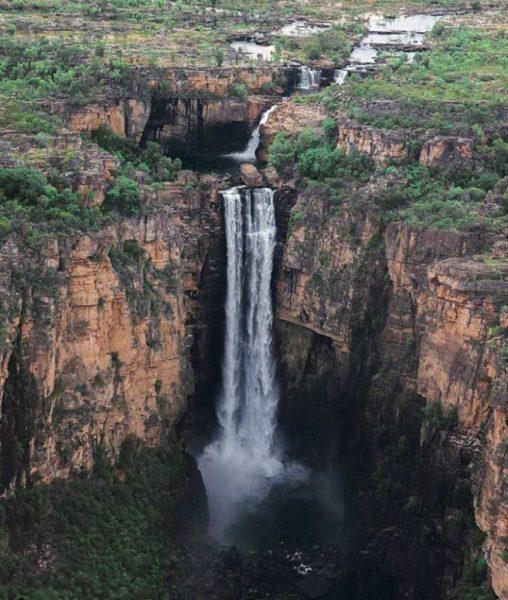
A park pass is $25 during the wet season and $40 during the dry season (May – October) which is valid for up to seven consecutive days.
Kakadu offers free camping and bush camping (walk-in) sites throughout the park. Check the park website for all accommodation options, including campsites.
5. Nitmiluk National Park
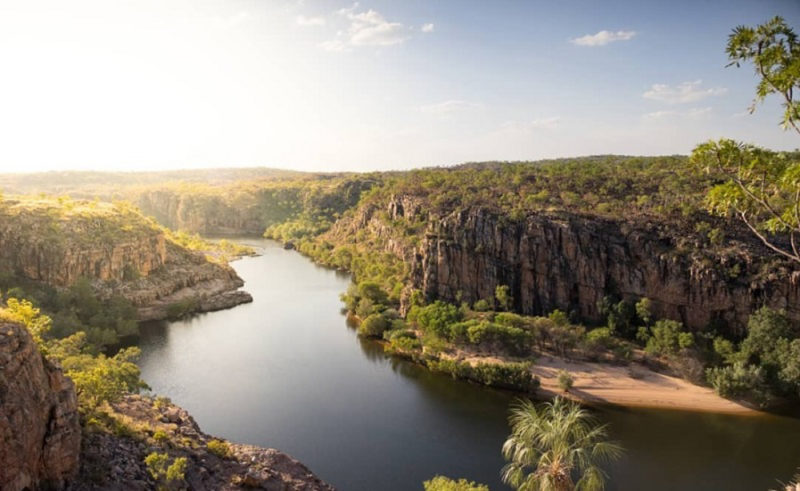
Nitmiluk, formerly known as Katherine Gorge National Park, is located south of Kakadu. The two major highlights at Nitmiluk are the Katherine Gorge and Edith Falls. Several hikes in the park range from two hours to 3-day treks.
Canoeing is also a great way to explore the gorges on the Katherine River. For overnight hiking and canoe trips, camping is available at Dunlop Swamp, Smitt Rock, and Eighth Gorge.
For the ultimate hike, grab a permit and set off on the Jatbula Trail . This is a 4 or 5-night hike starting from Nitmiluk Gorge and ending at Edith Falls.
Bush campsites at the Gorge Caravan Park are abundant, but require a permit from the park office.
6. Litchfield National Park
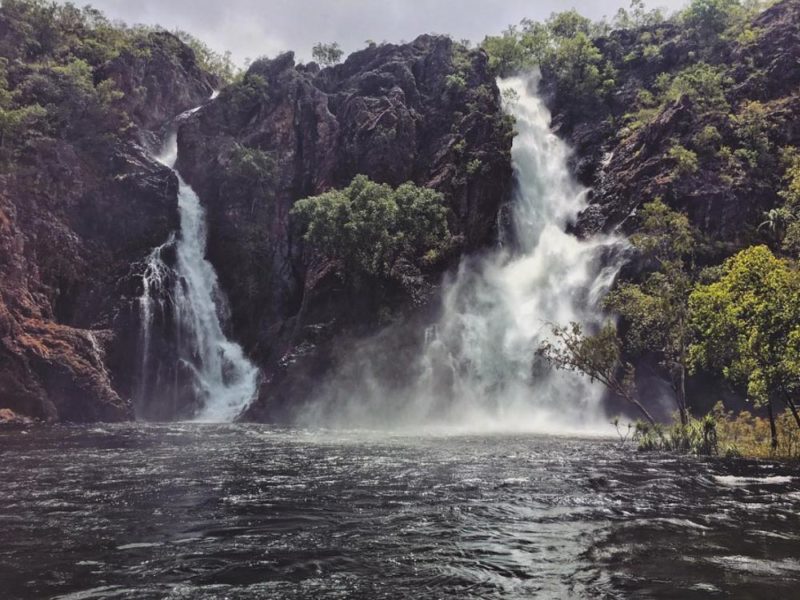
Located two hours south of Darwin, the Litchfield National Park is loaded with single-drop and cascading waterfalls. Popular attractions are Wangi Falls, Tolmer Falls, Florence Falls, and the Buley Rockhole.
The Lost City has impressive sandstone pillars and is an interesting place to visit, but it is only accessible by 4WD. The are several short walks as well as the 3 to 5-day Tabletop Track .
Camping is available at the Wangi and Florence Falls campsites.
7. Karlu Karlu / Devils Marbles Conservation
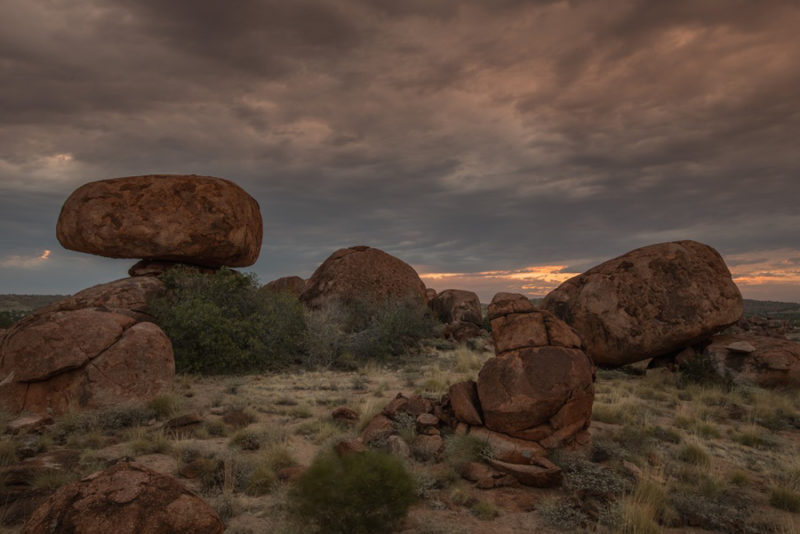
The Devil’s Marbles Conservation area is a bizarre and beautiful place to visit. It is full of round rock formations that precariously sit atop of one another. The natural process of erosion and weathering has changed the shapes of the granite stone to resemble round marbles, hence the name of the conservation.
Access is directly off the Stuart Highway. There are several short trails that take two to three hours to visit. This is a great location for sunrise and sunset photography, as well as astrophotography if the conditions are right.
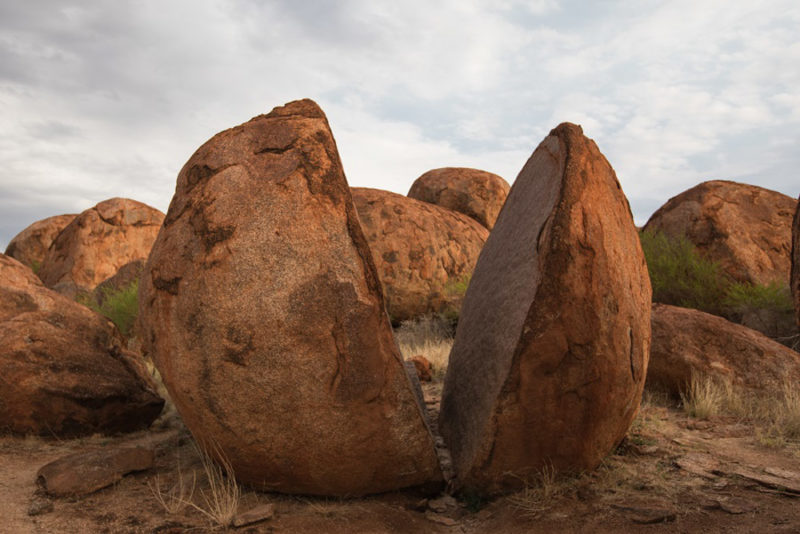
There is a basic campground (toilet, no other facilities) with fire pits at Devil’s Marbles. The closest places with facilities are Tennant Creek Caravan Park (100 km north) and Barrow Creek Motel (130 km south).
8. West McDonald Range
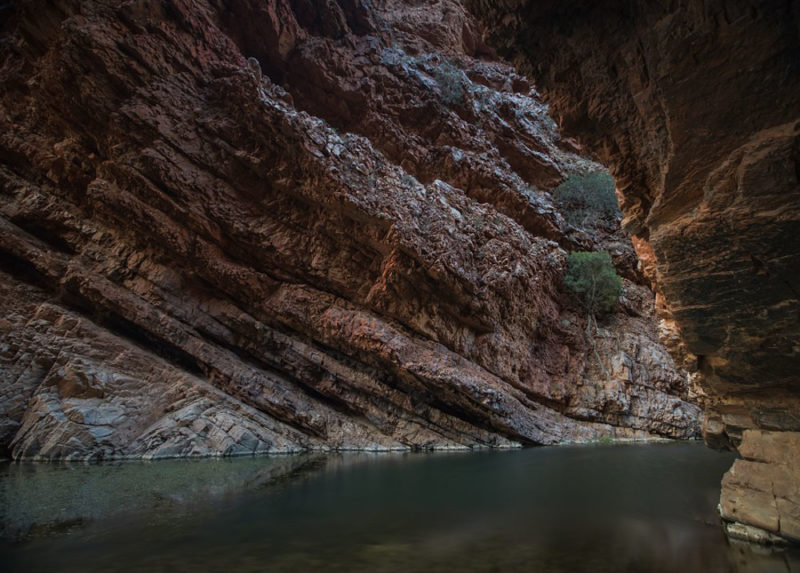
The West McDonald Range is only a short drive from Alice Springs and is a great place to explore. Who would have thought that the Outback has pristine swimming holes and beautiful gorges? Not us!
The best places to stop are the Simpsons Gap, the Standley Chasm, Ellery Creek, Serpentine Gorge, Ochre Pits, Ormiston Gorge, and Redbank Gorge. Each gorge is a 10 to 30-minute walk from the highway. Ellery Creek and Redbank Gorge were our favorites as both had a watering hole, perfect for an afternoon dip.
Our favorite hike was the Counts Point return which is a 13 km (8 miles) loop hike from the Serpentine Gorge. If you are up for a challenge, the 223km (138 miles) Larapinta Trail should be on the list. This hike traverses the range in 13-16 days. It should only be attempted during the winter months.
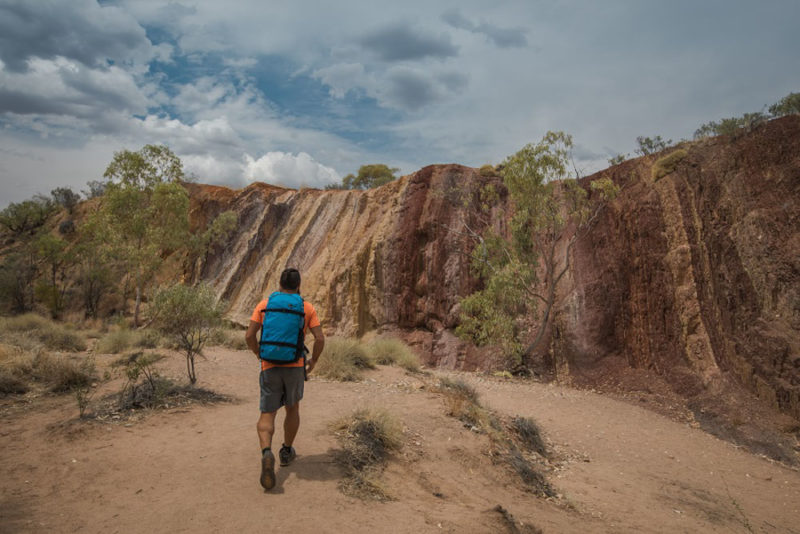
All gorges and sites are free except for the Standley Chasm which costs $12 per adult entrance, or $18.50 for overnight camping which includes the entry.
There are several free campsites along the West McDonald Range on Larapinta Drive. All of the gorges listed above have campsites which range in cost depending on the facilities.
9. Mereenie Loop Road
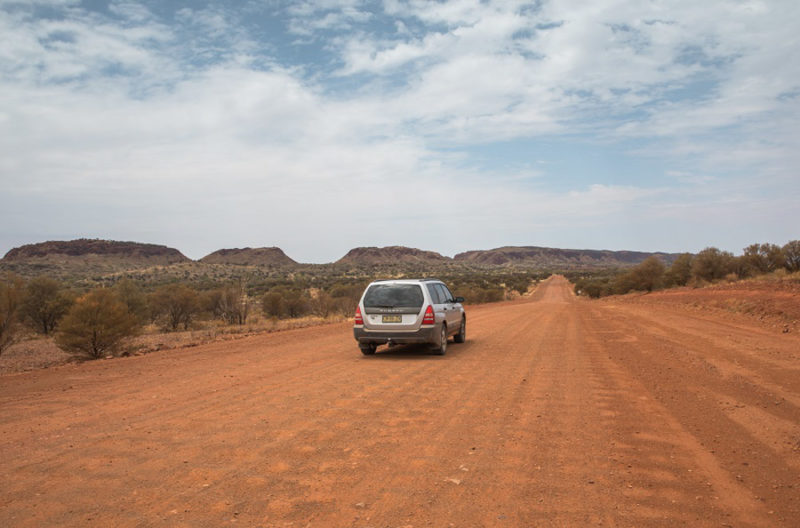
Mereenie Loop Road is an awesome way to get the Outback drive experience; no 4WD required (mostly). This road links the West McDonald Range and Kings Canyon so you don’t have to backtrack through Alice Springs.
The private road cuts through aboriginal land and is officially considered a 4WD-only road. However, with a bit of confidence, the road is an easy drive unless it has recently rained. We did it in our AWD Subaru Forester.
There are sections that are heavily corrugated and get quite bumpy, so you should drive slow but most of the drive is quite easy and smooth. There is absolutely nothing on this road and very few cars pass by, so make sure to have enough petrol. Also, bring extra water just in case. This is a 2-3 hour drive.
Note: Before attempting this drive make sure to check conditions at Glen Helen Lodge or Kings Canyon Resort. The Alice Spring Visitor Center directed us there for the latest road conditions. One night of rain can make this road impassable.
A permit fee is payable at the Alice Springs Visitor Center, the Kings Canyon Resort, or the Glen Helen Lodge. We never had our permit checked but I would get one anyway.
There is no accommodation or camping allowed on this drive. There are campsites and accommodation at both ends in Glen Helen or near Kings Canyon.
10. Oodnadatta Track
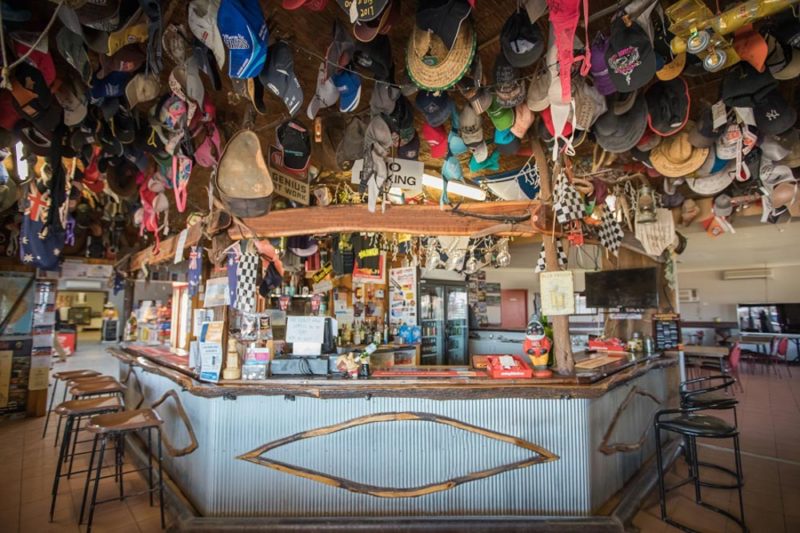
This 620 km (384 miles) multi-day drive is a true Outback adventure. The journey is possible on 2WD vehicles during the dry season. The track follows the abandoned Ghan rail line with several stops, including abandoned ruins, salt lakes, and natural springs. Some of the main stops are Lake Eyre, Wabma Kadarbu Mound Springs, Coward Springs, the Hergott Springs, and the William Creek Hotel (the only pub on the drive).
The drive is between Marree and Marla, with fuel stops at Marree, William Creek, Oodnadatta, and Marla.
Note: Before attempting check with the Pink Roadhouse for the latest track information.
There are basic campgrounds at Coward Springs.
11. Breakaways Conservation Park
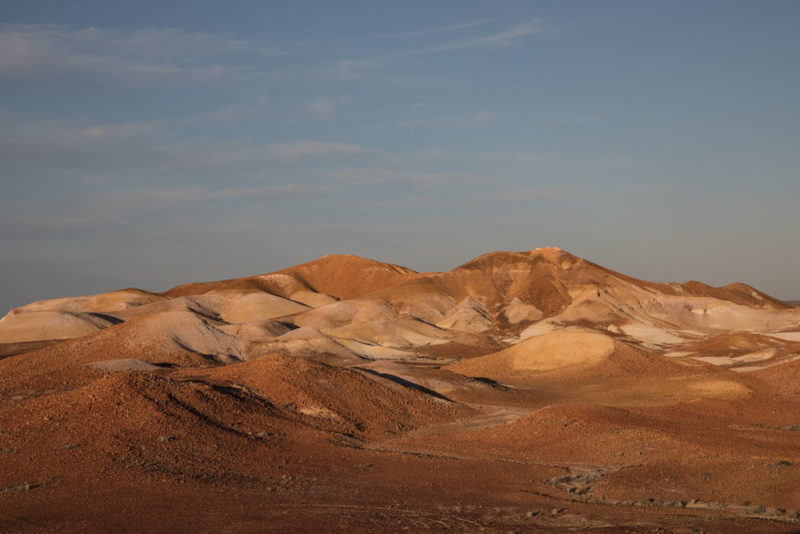
The Breakaways Conservation Park has low hills with incredible colors from centuries of erosion. Several gravel roads lead to different views of the park. The overlooks are a great spot to watch the sunset.
These rock formations are located 30 km (18 miles) north of Coober Pedy. From the Stuart Highway, there is a well-conditioned 16 km (10 miles) gravel road to the park.
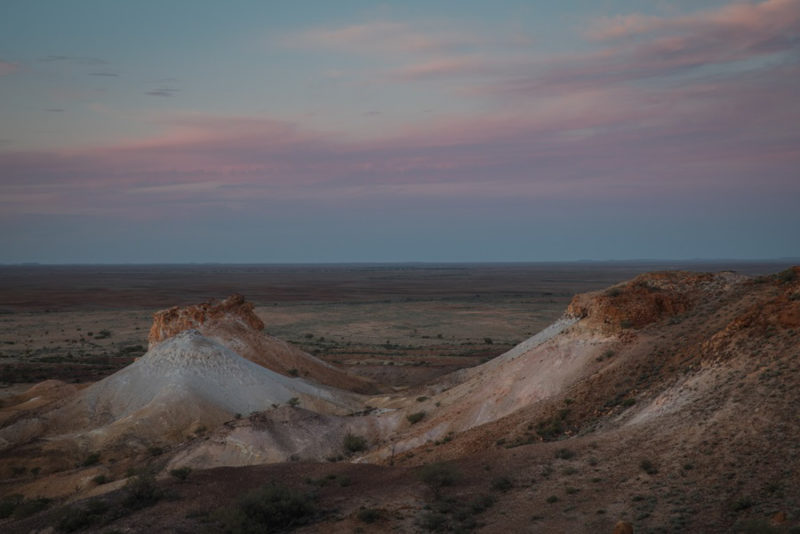
There is no accommodation or camping allowed in the conversation area. The closest option for accommodation is Coober Pedy which has free campgrounds and several hotels.
12. Lake Hart
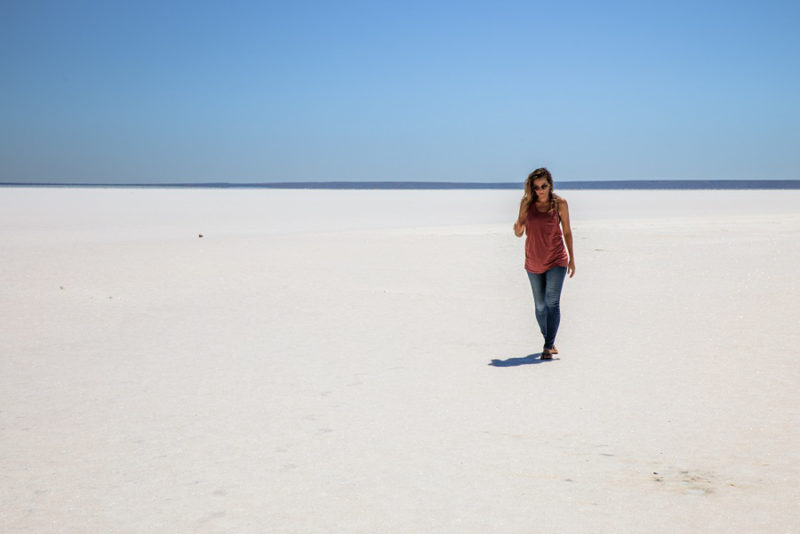
This large salt lake is something out of the ordinary and worth a short stop on the way to or from Adelaide. It is located 40 km (25 miles) north of Pimba and 327 km (200 miles) south of Coober Pedy. The lake is only a 5-minute walk from the highway.
There is a free Lake Hart Rest Area with no facilities.
13. Flinders Ranges
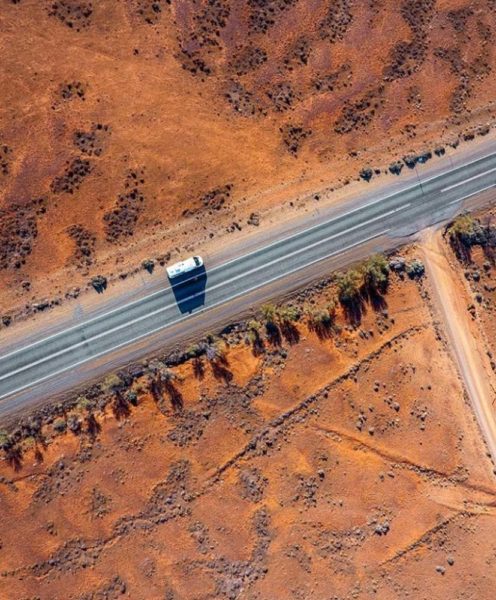
The largest mountain range in South Australia is 450 km (280 miles) north of Adelaide. The best section of the Flinders Ranges is within the Ikara-Flinders Ranges National Park. This is the southernmost part of the Outback.
The park is known for outstanding wildlife and great hiking opportunities. The Bunyeroo Gorge is a nice scenic drive. For those not intending to hike overnight, Razorback Lookout is a great sunset location.
The Wilpena Pound also has several great hikes. The St Mary Peak loop is a 21.5 km (13 miles) overnight hike and the Wangara Lookout is a nice 7-8 km (5 miles) day walk with panoramic views.
$12 per vehicle
Several campsites are available in the Flinders Ranges, which you can book online. The Wilpena Pound Resort campgrounds are a bit more pricey.
A 3-Day Uluru Itinerary
If you are really squeezed for time, three days is enough to check Uluru off your bucket list. Book flights in and out of Alice Springs.
- Day 1: Wake early and drive from Alice Springs to Yulara, a five and half hour drive. Stop at the overlook for Mt. Connor, also known as Fool-uru. Immediately, head to the national park and spend the next three hours hiking around the base of Uluru, starting from the Mutitjulu watering hole. If short on time, it’s still worth it to walk around the base for 30 or so minutes. Stay for sunset.
- Day 2: Head to Uluru for sunrise from the sunrise car park. Afterward, head back to Yulara for breakfast. After lunch, drive out to Kata Tjuta for the afternoon. Hike the Valley of the Winds walk and stay for sunset. Make sure to drive back before the gates close.
- Day 3: Watch the sunrise from the sunset viewing in the car park and enjoy a picnic breakfast at the visitor center. After soaking it all in at Uluru, head back to Alice Springs for your departure flight.
Note : Alice Springs is the central hub of the Outback. However, there is little reason to stay in Alice Springs other than to restock and gather free maps and information from the visitor center.
The 7-Day Outback Itinerary
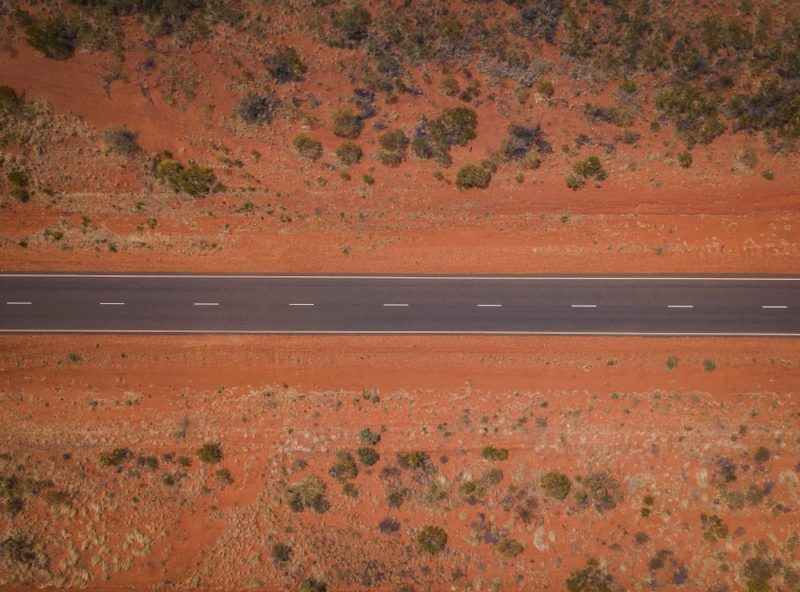
To hit all the highlights of the Outback, seven days is a perfect way to explore the region. To maximize your time, fly to Darwin or Alice Springs and rent a car. This suggested itinerary can be done in either direction.
- Day 1: Stock up in Alice Springs and hit the road to explore the waterholes and hikes in the West McDonald Range. Camp at one of the campsites.
- Day 2: Drive the Mereenie Loop Road to Kings Canyon and hike the rim walk. Stay for sunset and camp near Kings Canyon Resort.
- Day 3-4: Explore Uluru and Kata Tjuta with two sunrises and sunsets. Stay in Yulara.
- Day 5: A long driving day with a sunset stop at Devils Boulders. Camp at the Devils Boulders campground.
- Day 6: Sunrise at Devils Boulders and a long driving day to Katherine.
- Day 7: Hike or canoe in the Katherine River Gorge and drive up to Darwin to finish the 7-day road trip.
Ultimate 14-Day Road Trip in the Outback
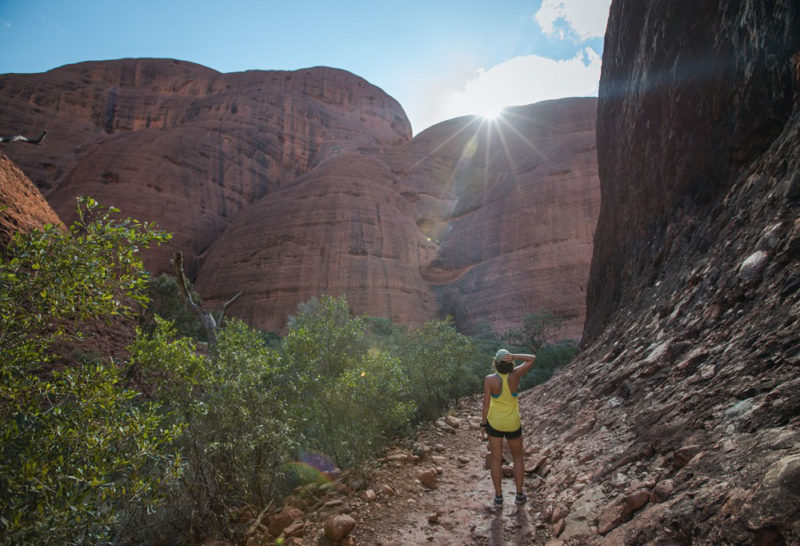
Be mentally prepared for several long driving days with no stops. Two weeks in the Outback is a perfect amount of time to soak in all the highlights. Whether you drive in from South Australia, Queensland, or fly into Darwin, two weeks allows for at least one full day at all the best spots.
- Day 1-3: Hike in Flinders Ranges or drive the Oodnadatta Track to Marla. Head towards Uluru.
- Day 3-5: Explore Uluru and Kata Tjuta for two days seeing all the sunrises and sunsets.
- Day 6: Drive four hours to Kings Canyon. Hike the rim walk.
- Day 7-8: Drive the Mereenie Loop Road and explore the watering holes in the West McDonald Ranges. Head towards Darwin.
- Day 9-10: Marvel at the Devils Boulders on the way to Katherine.
- Day 11: Canoe or Hike in the Katherine River Gorge.
- Day 12-13: Hike and explore the Kakadu National Park.
- Day 14: Check out all the waterfalls and watering holes in Litchfield National Park. Head to Darwin.
What to Bring to the Outback
Food – We expected prices to be much higher in Alice Springs, which they were not, so try not to bring too much. Stock up on a few essentials such as canned goods and non-perishable items that will last while in a hot car. Alice Springs has full-size supermarkets and Uluru has a normal size IGA. It is a good idea to have 3-4 days of food.
Alcohol – NT has some strange laws on alcohol, so definitely stock up on it for the duration of your trip. Alice Springs is the only place with proper liquor stores but the prices were higher than in the rest of Australia. The law prohibits sales during certain hours and regulates the quantity of liquor sold (especially when purchasing cask wines or goon).
Fuel – If you’re going on a 4WD adventure, carry a 10L or 20L can of extra petrol.
Apps for Australia
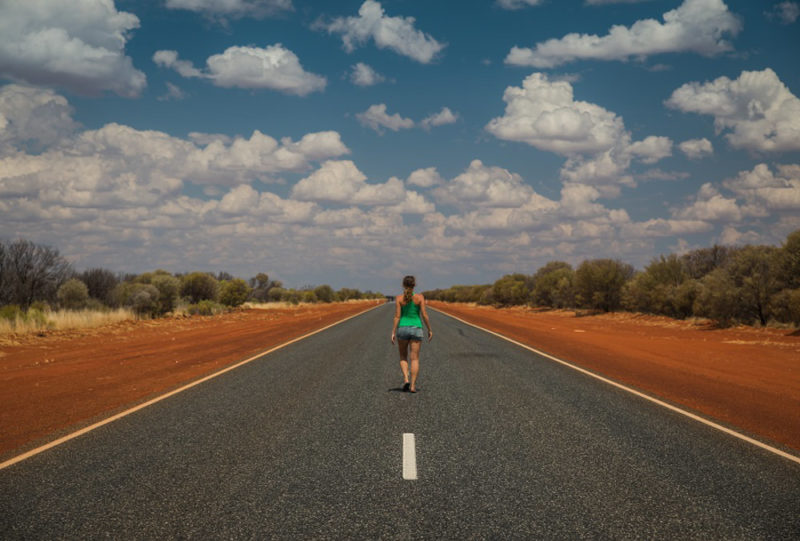
There are two apps to download before heading to Australia. Campermate is a free app that provides information on campsites, things to see, petrol, and lots more.
WikiCamps Australia is a paid app that has tons of information and user comments. The comments can be downloaded ahead so the entire app is available offline. WikiCamps is great for its extensive list of campsites and comments to help provide information and suggestions.
Important Things to Know About The Outback
Fuel – petrol is more widely available than expected in the Outback. With that said, it is normal to have a 200 km (125 miles) stretch between petrol stations. Most roadhouses have petrol. My rule of thumb was no matter what the price, fill up at every possible place.
Roadhouses – Roadhouses are few and far between, usually with nowhere else to stop. Roadhouses have petrol and sometimes a small general store. They always have camping options, food, and beer available.
Driving at Night – Unless you have to, do not drive at night. It simply is not safe. It gets very dark in the Outback, there are no road lights, and there is an abundance of wildlife. If you plan on staying for sunsets, make sure to drive very slow on the way back to your accommodation.
Lock Car Doors – We heard on a few occasions, especially at Uluru, of things getting stolen. It almost always occurred with unlocked car doors. And it typically happened in the middle of the night, even with people sleeping in the car. Make sure to always lock your doors. As a rule of thumb, do not stay at a rest stop or campsite unless there is another car there.
That’s it – we hope you have an amazing time exploring these spots to see in the Outback!
Planning a trip to Australia? Check out our favorite books and travel guides!
SHARE THIS ON PINTEREST
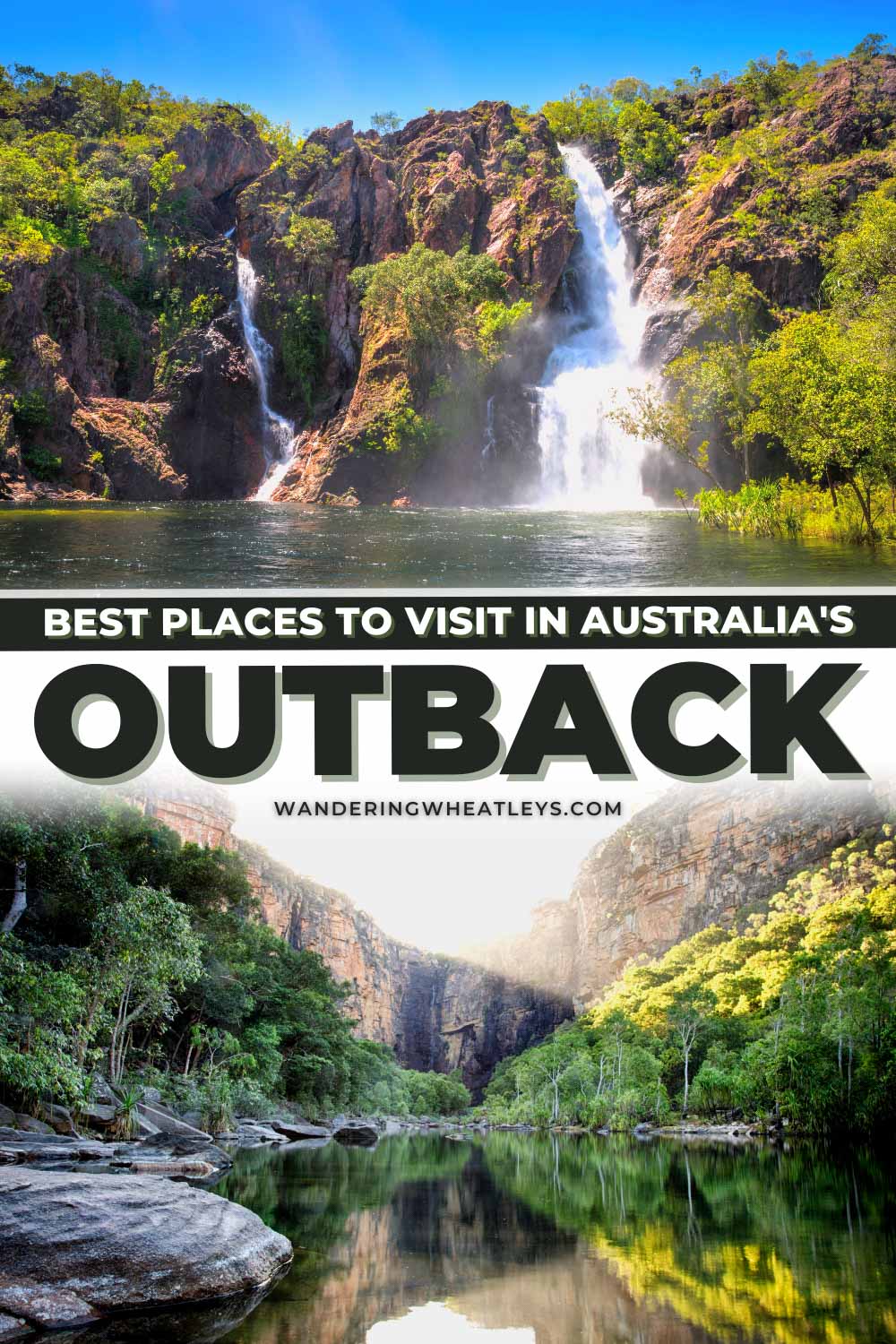
Yana & Timon met at college in Boston, Massachusetts. After graduating, they started their professional careers. They moved to San Francisco in 2010, a city they loved living in for nearly six years. After working and saving up money for several years, they quit their jobs and set off on an adventure of a lifetime. They started living a nomadic lifestyle in December 2015 and have not looked back since.
Related Posts
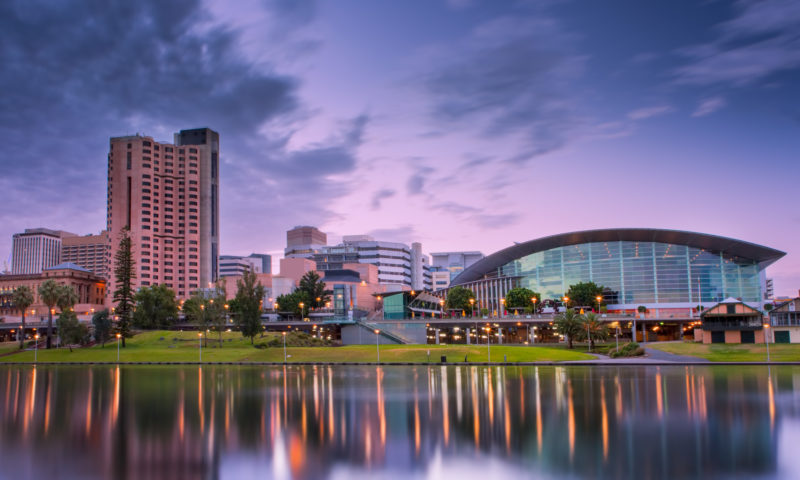
The 12 Coolest Boutique Hotels in Adelaide
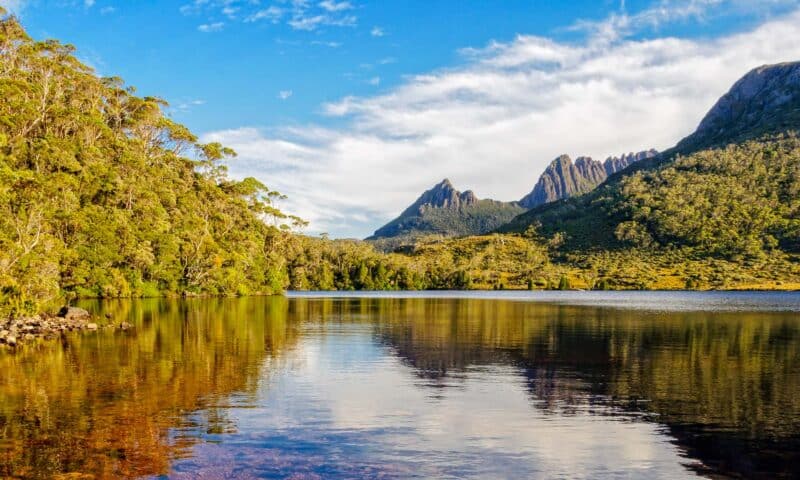
The 11 Best National Parks in Australia
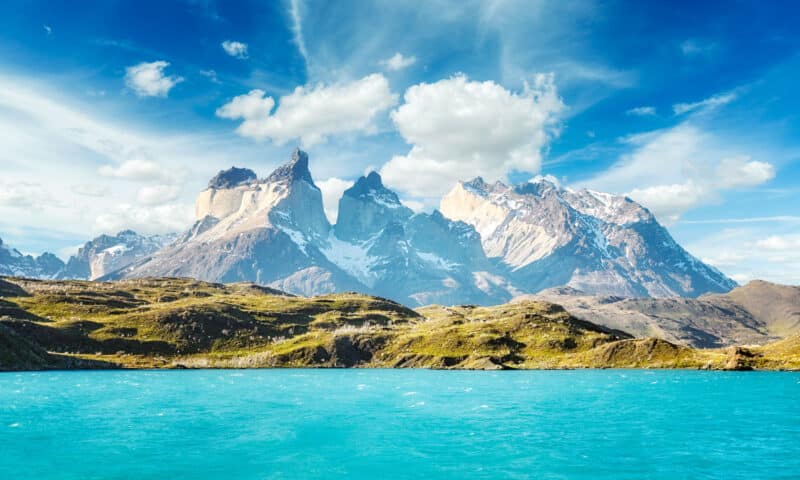
The 15 Best Vacation Destinations in December (2024)
Leave a comment cancel reply.
Your email address will not be published. Required fields are marked *

How To Explore The Australian Outback
The Australian Outback embodies the essence of all Australia landmarks . It covers roughly 6.5 million square km and has so many attractions for the adventurous traveller. The Outback Destinations are full of gorgeous open spaces, dazzling colours, challenging 4WD locations, rugged mountains, waterfalls, and plenty more.
You will never run out of things to do, and there is something for everyone. Due to its vast size, it is home to several climate zones which is why planning your Australian Outback Travel well is of the utmost importance. So take a trip here and immerse yourself in the heart and soul of Australia .
TABLE OF CONTENTS
Central Australia
- Northern Australia
- North-East Australia
Western Australia
- Getting Around
- Red Centre Australia
- Top End Australia
- North-West Australia
- Flinders Ranges S.A.
- Best Outback Towns
- Outback Animals
Australian Outback Map and Facts
The Australian Outback Destinations are spectacular and marvellous places to visit. There are just so many attractions to choose from that it can become hard to fit all into one trip. Usually, people associate the Red Centre of Australia with the Top Outback destination. But there are many more places really worth visiting. Before you start planning your itinerary, why not look at the following Australian locations that make up the entire Outback experience. From this map, you can see that most of Outback Australia cover the majority of the territory. The light yellow characterizes inhabited areas, whereas the deep yellow regions are mostly desert zones scarcely populated.
This region consists of the Red Centre with vast red desert plains where you can view Ayers Rock. When driving from Sydney, you can make a stop at Alice Springs. Alice Springs is known as the Capital of the Outback, and it sits in the middle of the Australian continent. It is well connected to Uluru , and you can take a fun drive to visit it. To see all the Central Outback Destinations’ amazing sights, you can take a self-driving trip from Alice Springs to Ayers Rock. From there you can proceed to Kings Canyon and even loop back to Alice Springs.
Northern Australia Outback Destinations
The northern part of the Outback regions has rugged ranges, spectacular gorges, and astounding waterfalls. You can reach the Top End of Australia from any of the airports. Once there, catch the Ghan train to Darwin. Though it is a small town, you need at least three days to enjoy Darwin’s uniqueness fully. The ocean surrounds it on three sides which gives it a lovely tropical atmosphere.
The best way to get to the Kakadu is to hire a car and drive to enjoy the sights from Darwin. Along with the Kakadu National Park, the Litchfield National Park is also an amazing place to see. Visiting this location during May-June is the best since the crowds have thinned and you can enjoy the beautiful atmosphere without any restrictions.
Top North-East Australia
Queensland Australia is a place that travellers flock to for an exotic Australian experience. There are a lot of things to do here, including visiting the World Heritage-listed Fossil fields. Many tours can be taken from the city of Cairns in Queensland. These tour packages will allow you to explore the Outback and see the epic Gulf Savannah region of North Queensland .
There are also guided 4WD tours to Daintree National Park, Cooktown and farther north. You can reach Queensland by flight or take a bus from one of the many bus services available between cities and towns throughout Australia. It is also easily reached by train from Sydney .
The Kimberley of Australia is one of the prominent Outback destinations of the West. Here you can visit Broome and watch the sunset on the back of a camel, drive along the Gibb River Road, cruise by Lake Argyle, and explore the beehive structures of the Bungle Bungles range in Purnululu National Park. To get to the Kimberley, you can travel by the Stuart Highway from Darwin.
How to get around in the Outback
The Australian Outback is rich with sights and experiences to relish. There are several ways that you can explore the Outback Destinations. Here are some of them.
Self-driving
Driving by a 2WD or a 4WD is the best way for any Outback travel. Renting a car is the most convenient way to go wherever you want. It can get quite expensive to hire a 4WD, and there are many places where an ordinary 2WD will be quite sufficient. If you are looking to visit places that require you to use unsealed roads, then investing in a 4WD for your trip will be the best and safest option.
It will also require a certain level of expertise to operate a 4WD which is important on your journey. Here are some more tips that you can use while driving through the Australian Outback .
Find the latest 4WD and Campervan Deals for the Outback
By Campervan
These are a convenient and interesting means of transport for getting around the Outback. They can house around 2-6 people and serve as a home on wheels so that you can camp anywhere. There are also 4WD campervan models which are one of the best ways to see the Australian Outback.
On a flight
The Australian Outback has many airports situated at some major cities, including Kununurra, Broome, Alice Springs, Ayers Rock, and more. There are many direct flights to most of the towns of the Outback. You will not have a problem since most of the areas are well connected.
Find all Flight Deals to the Outback Australia
Outback bus travel is really comfortable and in most cases quite cheap. They have many stops on the way so that travellers can have a meal and stretch their legs. Many buses ply between Adelaide, Alice Springs, and Darwin. The major bus network is Greyhound, but there are some local bus companies too.
On a train journey
The famous Ghan train is the most fun way to get around the Australian Outback. It departs from Adelaide for Alice Springs on Sundays and Wednesdays and then goes to Darwin. It is a luxurious mode of transport and is well equipped with many facilities.
Australian Outback Destinations And Tours
Outback Australia is full of wonderful tourist attractions for you to visit. So before you begin planning your trip, check out some of the wonderful things to do in the Outback and best places to visit.
The Red Centre
The Australian Red Centre consists of the famous town of Alice Springs and the gorgeous monolith of Ayers Rock. To explore it you can take one of the 2-day or 4-day Outback tours from Alice Springs. On a four day tour, you will get to spend a day in Alice Springs, where there are many amazing Aboriginal art galleries to visit. After an overnight stay, you will visit the West MacDonnell Ranges, which is also an extraordinary landscape to be discovered.
It has rocky gorges, and waterholes for you to cool down, and picturesque areas to explore. Don’t miss out on the amazing collection of Indigenous paintings at the Uluṟu-Kata Tjuṯa Cultural Centre. The late afternoon is the best time to see the sky change colour at Uluṟu while sipping sparkling wine. On your last day, you will be transported back to Alice Springs.
For self-guided trips and more information check out this guide on the Australia Red Centre.
Top End of Australia
The Northern Territory of Australia is huge and has so many places that you could explore and visit. You can take a 1-day tour to the Litchfield National Park and see the gorgeous natural landscape that has been formed by water. It has abundant waterfalls, a huge monsoon rainforest, multiple bushwalking tracks, swimming holes, and the well-known magnetic termite mounds.
For other travellers with more time to spend in the Top End, there are also adventurous 3-day 4WD tours to be taken! These kinds of adventurous trips offer value for money Top End Experience where you can visit Kakadu , including Twin Falls, Jim Jim Falls, and the Litchfield National Park.
North Western Australia
One of the ancient landscapes of North-Western Australian is the Kimberley region . It spans hundreds of thousands of square kilometres and is one of the world’s most precious wilderness regions. It is a gateway to the outback beach town of Broome and Kununurra on its eastern side. Learn more about the spectacular Kimberley Region here.
Flinders Ranges
The Flinders Ranges in Australia is located about 380 kilometres north of Adelaide. Here you will find dusty red roads bordered by towering ancient cliffs and deep craters. Visit the Wilpena Pound, which is a large amphitheatre created naturally through erosion. It also has some good Aboriginal rock art sites you can marvel at. Since there is so much to do here, you can take a Tour to the Outback Flinders Ranges to see the most attractions at once.
Queensland Australia Outback Destinations
The Central West is also known as the heart of Outback Queensland. Here you can see the amazing Stockman’s hall of fame that pays tribute to the Outback people. The live ‘Outback Stockman’s Show’ is a must-see event there. Another fascinating thing is the world’s largest collection of Australia dinosaur fossils at the Australian Age of Dinosaurs Museum in Winton.
The North West is the rugged portion of Queensland. It has the gorgeous Mount Isa which has several heritage-listed sites. Take a trip through history at the Underground Hospital built during WWII. You can also have a fun time at the Porcupine Gorge National Park in this part of Queensland.
In the south-west is Brisbane which a good place for finding beautiful birds like the wedge-tailed eagles. Indulge in some self-care by bathing in mineral-rich mud at the Eulo Mud Baths. Pay a visit to the Charleville Cosmos Centre , where you will get a chance at an evening stargazing session and visit some astronomy exhibits. The town of Cunnumulla has situated just 200km from Charleville, and you can enjoy fishing, kayaking, and swimming there.
Queensland’s far west is the best place for adventures by 4WD. Drive down to see the dazzling beauty of the Big Red at sunset. Don’t forget to go bird watching in the wetlands of the Diamantina National Park.
Best Australian Outback Towns worth visiting
Here are some of the wonderful towns of the Outback. You can spend a night or make a pit stop at some of these places during your Australian Outback Travel.
Relate article : Top things to do in Darwin .
Alice Springs
Coober pedy, broken hill and silverton.
Mildura Arts Centre is a place to visit to indulge your senses and enjoy the creative talent from all around. Lastly, you have to experience what it feels like to travel on a houseboat along the Murray River.
The Outback town of Broome is situated in the Kimberley region of Western Australia. It is a remote place with red dust banks, white sand beaches, and dazzling turquoise waters. You can go to the famous Cable Beach of Broome and have a picnic there. Broome is also a great place for bird lovers, and it houses the magnificent Broome Bird Observatory. Broome is the Tropical Pearl of West Australia.
This remote small town on the south Thargomindah is an archetypal Aussie Outback town in the far south-western Queensland. If you plan a road trip across Queensland’s Outback, make sure you visit it.
Australian Outback Animals
The Outback of Australia is vast and abounding in amazing wildlife. There are so many Australian wild native animals that you will come across during your trip. Here are some that you should keep an eye out for.
When thinking of Outback Australian Animals Kangaroos come to mind first. These are the most iconic animals you can see hopping all over Australia. The red kangaroo is the largest kind that you will find while the grey kangaroo is the one you are likely to see most often. You can see Kangaroos in all Outback regions but and you have to pay attention at night, and not driving at night in the Outback it really something you should avoid.
The Australian dingo is a friendly canine that is an integral part of the Australian Outback. This sandy, a coloured dog can be quite inquisitive and intelligent. They can easily be seen on Fraser Island, but certain rules ensure that they are safe from harm since they are endangered. You can spot them in North-Western Australia. You can see them in the Red Centre area too.
If there is one Outback animal that you should be wary of, that is the Australian saltwater crocodile . The saltwater crocodiles’ home is in the North of Australia, the Top End, and the Tropical North Queensland. Crocodile attacks have taken place in several parts of the Outback. That is why you should always be on the lookout for crocodile warning signs wherever you go. It is also best to stay out of muddy or deep waters. You can ask the locals about certain areas and get good information at the tourist information centres.
Australian crocodiles are most aggressive during the breeding season, September to May, so be sure to watch out and steer clear of dangerous animals.
Camels are widespread in most of the Outback Destinations. Although camels are not native to Australia, there is a huge wild camel population since they are suited for the Outback and in some places, you can even take a fun camel safari. There are many camel ride tours at Uluru, Broome and Broken Hill.
Wallabies are in fact kangaroos but much smaller, and they too are widespread in the Outback. There are many different kinds of wallabies you will see, and they also have different habitats. The rock wallabies can be found in areas with rugged terrain, rocky hills, or caves. Some species prefer grassy plains, or rainforests instead. The yellow-footed rock wallaby is one of the rare species that you can find in the Outback. You can spot them moving about in the Flinders Ranges. They are shy animals, so do approach them slowly.
Share it on Pinterest.
More detailed travel guides
If you plan extended trips in the Australian Outback you can check out our travel guides about:
The Top End Northern Territory Australia
The Kimberley North West Australia
All Destinations of Australia
Back to Rocky Travel Guide
First published in 2010, last updated in June 202 3
If you find this article helpful for your trip, I’d appreciate it if you could support Rocky Travel and book your tours, accommodation, rental car, or purchase my book using the links in the box below. Thank you!
BOOK YOUR TRIP WITH THESE RESOURCES
Get Travel Insurance For Your Trip
Travel with peace of mind: 👉 Compare and Buy Travel Insurance .
Book Accommodation WorldWide
Find the best deals for hotel, homes, villas with 👉 booking.com .
Join Small Group Tours Of Italy For Over 50
Explore Italy with our 👉 Small Group Tours Of Italy .
Find The Best Tours Deals For Australia
Scout for the best guided trips and tours with our 👉 Australian Tours Guide .
Plan & Book Your Australian Adventure
Create the perfect Australia Trip Itinerary with 👉 Your Australia Itinerary eBook and/or Book A Trip Planning Call .
Plan Any Trip With These Resources
Check out our 👉 Travel Planning Bible .
Privacy Overview
- Skip to primary navigation
- Skip to main content
- Skip to primary sidebar
- Skip to footer
TravelAwaits
Our mission is to serve the 50+ traveler who's ready to cross a few items off their bucket list.
How To Visit Australia’s Outback

pisaphotography / Shutterstock
- Activities and Interests
- Australia and South Pacific
- Australia and South Pacific National Parks
- Destinations
- National Parks
- The Outback
- Uluru-Kata Tjuta
Vast open spaces. Vibrant red dirt. Awe-inspiring landscapes.
Australia’s Outback may appear empty, but it’s teaming with life. Plants and flowers bloom from the dust, secret swimming holes beckon passerby, and kangaroos thrive in the dry heat. These are just a few things you’ll discover as you explore the Outback.
Once on the ground, it’s easy to understand why the aboriginal Australians’ ancestors settled in this stark environment some 50,000 years ago. Although it’s out of the way, a visit to the heart — both spiritually and geographically — of Australia is a must. The magic of Australia’s Outback truly leaves an imprint on anyone who visits.
While the Outback technically covers more than 70 percent of Australia , here we explore how to visit Central Australia’s Outback and some of its most iconic attractions.
Where Is Australia’s Outback?
Due to the size and scale of the Outback, it can be hard to pinpoint where it starts and ends.
Australians commonly use the term “the bush” to allude to natural areas outside of cities, yet the Outback is even more isolated. The general term Outback is defined as “the remote and usually uninhabited inland region of Australia.”
Australia is made up of six states and two territories, each with its own Outback. However, when people refer to the Outback, they are usually thinking of Central Australia — the red center and heart of the country and continent. The Outback is also home to the country’s iconic monolith: Uluru (Ayers Rock).
How To Get To The Outback
Central Australia’s Outback is in the heart of the Australian continent and features two main hubs: Alice Springs and Uluru. Australian’s sometimes joke that Alice Springs is the closest city to every beach in Australia. What they really mean is that Alice Springs is in the center of Australia, making it equidistant from all the coasts!
Although Uluru looks close to Alice Springs, it’s about a five-hour drive between the two places.
Getting To The Outback By Plane
Flying is the easiest and most time-efficient way to get to the Outback. Qantas, Virgin Australia, and Jetstar are the main airlines servicing Central Australia.
Direct flights from major cities like Sydney and Melbourne are available to both Alice Springs and the Uluru (Ayers Rock) airport. The flight from Sydney to Central Australia takes about three and a half hours. Flights from smaller cities like Perth, Adelaide, and Brisbane usually have at least one connecting flight.

Marc Witte / Shutterstock
If the Uluru (Ayers Rock) airport is your destination, the airport provides a complimentary shuttle for the 10-minute drive to Ayers Rock Resort. If you’re flying into Alice Spring Airport, you’ll have to arrange your own transportation.
Getting To The Outback By Car
Since there are great lengths between Outback points of interest, renting a car on the coast and driving it to the Outback is a great option if you have ample time and want to see as much as possible. The drive itself requires two to three full days.
Sydney to Uluru takes about 30 hours of driving along National Highway A87. However, from Adelaide or Darwin, it’s about a 16-hour drive to Alice Springs along paved Stuart Highway. If you’re not in a rush, this is a great way to see the stunning, unique landscape of the Outback. Having a car once you arrive in Central Australia also affords you more control over your daily itinerary. It can also be less expensive and more convenient than booking tour buses when you arrive.
When driving in the Outback be careful during dawn and dusk. During these times, kangaroos come out to feed. It’s normal to see them dart in front of cars, much like deer do in North America.
Getting To The Outback By Train
In the 1900s, travelers, provisions, and materials were transported between the coasts and the Outback by camel trains . In 1929, a steam train, The Ghan , substituted Afghan camel trains. The train now travels 54 hours between Adelaide and Darwin with a stop in Alice Springs.
The Ghan leaves Adelaide every Sunday on a two-day journey to Alice Springs. A luxurious experience, the journey is all inclusive with meals and drinks. Although expensive, this is a stunning way to enjoy the landscape without having to drive yourself.
Getting To The Outback By Bus
If you have time to get to Central Australia, but don’t want to drive yourself, book a seat on a Greyhound bus .
Busses leave from Darwin and Adelaide to travel to Alice Springs. The ride takes about 20 hours, but the seats are comfortable and there is a bathroom onboard. Since the journey includes a night, the price of the ticket ($200 to $300 AUD) saves you one night of accommodation.
Once you arrive in Central Australia you can rent a car or purchase a bus transfer to travel between Alice Springs, Kings Canyon, and Uluru.
When Is The Best Time To Visit Australia’s Outback Region?
Since Australia’s Outback is arid and dry, most people expect hot weather year-round.
It’s true that during the summer months (from October to March) outdoor activities are not advised after 10 a.m. Extreme heat is not always the case though. During winter (June to August), temperatures can dip as low as 14 degrees Fahrenheit.
Summertime is also when the Outback receives the bulk of its rainfall. Although less than 12 inches of rain per year fall in the Outback, downpours do occur. Seeing the rain run through the landscape, creating waterfalls and filling up crevices, is an incredible experience.

wargunner / Shutterstock
To avoid the worst of the heat or cold though, the best time to visit is in fall or spring . From March to May and September to November, temperatures stay between 68 and 86 degrees Fahrenheit.
Because these are the most popular times to visit, consider checking Australian school holidays to avoid peak family travel times.
What Is There To Do In The Outback?
Although the Outback may be sparsely populated, there is an incredible diversity of landscapes, cultures, and history waiting to be explored. Whether you want to escape from the hustle of urban life or learn about the land’s aboriginal caretakers, the Arrernte people, here are the best ways to experience the magic of the Outback for yourself.
Alice Springs
While there are small towns around Alice Springs, the closest major city, Adelaide, is a whopping 825 miles away. With a population of 29,000 , Alice Springs is the second largest city in Northern Territory and the only city in the center of the Outback.
Originally a telegraph station, Alice Springs was founded in 1871 to connect communication between Adelaide and Darwin. The telegraph station still stands and is open to visitors. Once gold was found in the area, the city boomed.
However, Alice Springs is not a dreary mining town. Its red dirt landscape attracts visitors for its hiking trails, swimming holes, and natural rock formations. Take in its full beauty from above with a hot air balloon tour or explore on the ground by walking the 139-mile Larapinta Trail .
Make sure to visit Kangaroo Sanctuary , a rescue center that provides care for orphaned kangaroos.
Uluru-Kata Tjuta National Park
Uluru, also known as Ayers Rock, is a monolith in the middle of the Outback. Higher than the Eiffel tower , it’s a rock formation in the middle of Australia’s Outback that attracts over 300,000 people each year.
It might look tempting to climb Uluru, but it’s disrespectful to the local Anangu people. Not only is it frowned upon, but it’s also dangerous. Starting on October 26, 2019, the climb to the top will be permanently closed . Standing on top of the monolith prevents you from experiencing its beauty anyway! The best way to experience Uluru is to walk the 6.2 miles around its base.
While Uluru is best viewed at sunset, Kata Tjuta shines during sunrise. Kata Tjuta, also known as the Olgas, is a cluster of 30 rock formations that are just as stunning to explore. A 45-minute drive from each other, both formations have designated platforms that provide optimal viewing spots . Consider spending the first half of the day, including sunrise, hiking through Walpa Gorge and the Valley of the Winds at Kata Tjuta. Then, finish off the second half of the day with sunset at Uluru’s viewing platform.
A three-day park pass to enter both Uluru and Kata Tjuta is $25 AUD for adults.
Kings Canyon
Made popular by the movie Priscilla Queen of the Desert , Kings Canyon is about halfway between Uluru and Alice Springs.
Nestled in Watarrka National Park, Kings Canyon is a hiker’s paradise. Enjoy beautiful outlooks onto the landscape from the 3.7 mile Kings Canyon Rim Walk . For a more immersive experience, consider walking the 13 miles from Kings Canyon to Kathleen Springs.
Regardless of the hikes, make sure to wake up before dawn to watch the golden light wash over the canyon’s sandstone walls.
Cultural Experiences
The aboriginal Australians’ ancestors arrived in Australia 50,000 years ago . To put this number into context, Australia has only been a country for 118 years .
As the aboriginal people have lived on this arid land, they’ve cultivated a wealth of knowledge, traditions, and culture. There were once 250 languages and 600 dialects spoken by indigenous communities in Australia. Currently, there are only 145 languages left and 110 are considered endangered.

Maruku Arts
Both Uluru and Alice Springs offer aboriginal cultural activities. Experiencing a dot-painting class , attending a hunting weapon talk, or learning about Dreamtime is incredibly illuminating. These are some of the only places visitors can experience aboriginal culture in this way.
Other Things To Know About The Outback
Even when temperatures are mild, most Outback landscapes provide little shade. It’s important to stay sun conscious to avoid sunburn and heat stroke. Pack light, long sleeve shirts, plenty of sunscreen, SPF lip balm, and a hat.
In dry environments, it’s also good to keep in mind that water evaporates in subtler ways. Heavy sweating is less common, so don’t forget to drink plenty of water to avoid dehydration.
With warm temperatures, there is also an increase in flies. Consider investing a few dollars in a fly net hat to wear while you hike. For evenings or early mornings, insect repellant for mosquitos and other bugs is highly recommended.
Photo Credit: pisaphotography / Shutterstock

Hailing from California, Vita travels the world, finding meaning and purpose in each destination, activity, and interaction, while inspiring others to do the same! When she’s not dreaming about the next destination, chasing golden hour, or dancing West Coast Swing, she’s most likely to be found documenting her travels and time spent living abroad in Australia on her blog, My Walk in the World .
- Skip to primary navigation
- Skip to main content
- Skip to primary sidebar
- Skip to footer

The Opinionated Travelogue of a Photo Maniac
- Middle East
- North America
- South America
- Pacific Islands
- FOOD & WINE
- TRAVEL GUIDES
- TRAVEL RESOURCES
- Rants & Raves
- Travel Blogger Interviews
- Contact Form
- Privacy Policy
- Featured Elsewhere
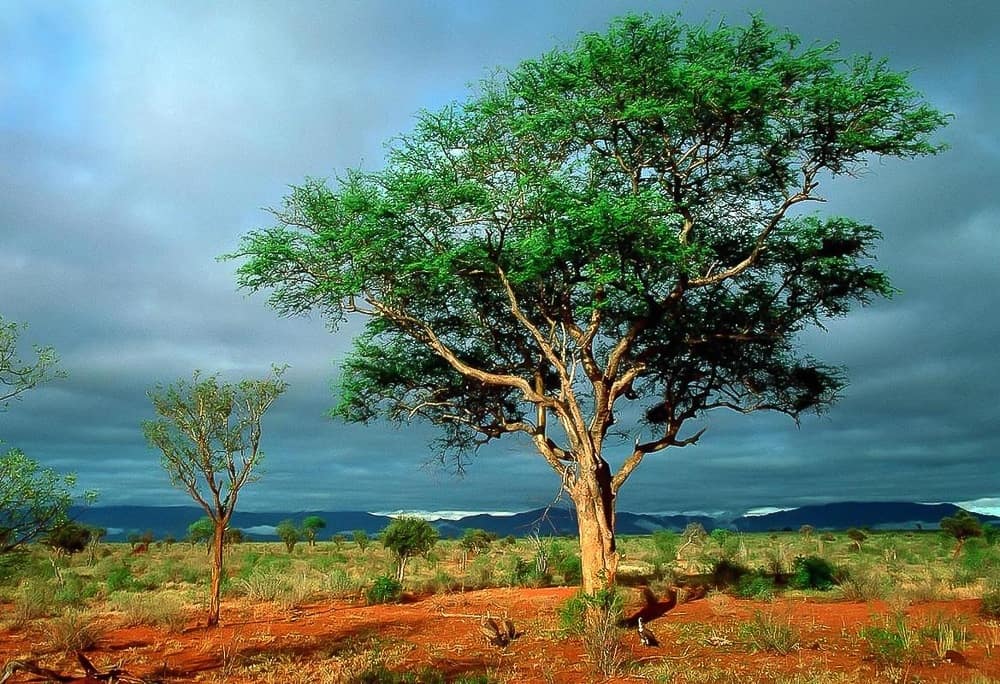
How To Explore the Australian Outback: Red Centre Way Itinerary
Last Modified: August 23, 2023 // by Anda // 17 Comments
The great thing about Australia is that although most of its regions have been highly urbanized, you can always visit the Australian Outback to take a breather. When you feel like you want to get away and explore the wilderness for a little while, you can always count on the open spaces and the picturesque natural locations of the Outback.
Table of Contents
How to Explore the Australian Outback
Alice springs, finke gorge national park, uluru and kata tjuta, kings canyon, tips on traveling the australian outback.
One of the most recommended road trips in Australia is the the Australian Outback in the Red Centre Way. It is all about mountain ranges, desert plains, and Aboriginal sacred sites. In this article, we will talk about some of unmissable locations and experiences at the Red Centre.

The best way to explore the Australian Outback is no doubt on a road trip. You can either do it by car, rent a camper van , or if you feel more adventurous, do it on a motorcycle . There is nothing like feeling the wind in your hair when riding a Harley!
Australian Outback Destinations
The first stop on the Red Centre Way itinerary is Alice Springs, a place that should be on any Australia bucket list . You can visit the Araluen Arts Centre to look at a collection of Aboriginal art or check out Aboriginal rock art at the Emily and Jessie Gaps Nature Park. Then you can choose to drive around, or simply hike or bike to the Simpsons Gap where a sacred waterhole is located.
You can also see Australian evergreen trees called Ghost Gums around the Simpson’s Gap, take a scenic walk to Standley Chasm, or get a cool view of the Serpentine Gorge from above the cliffs.
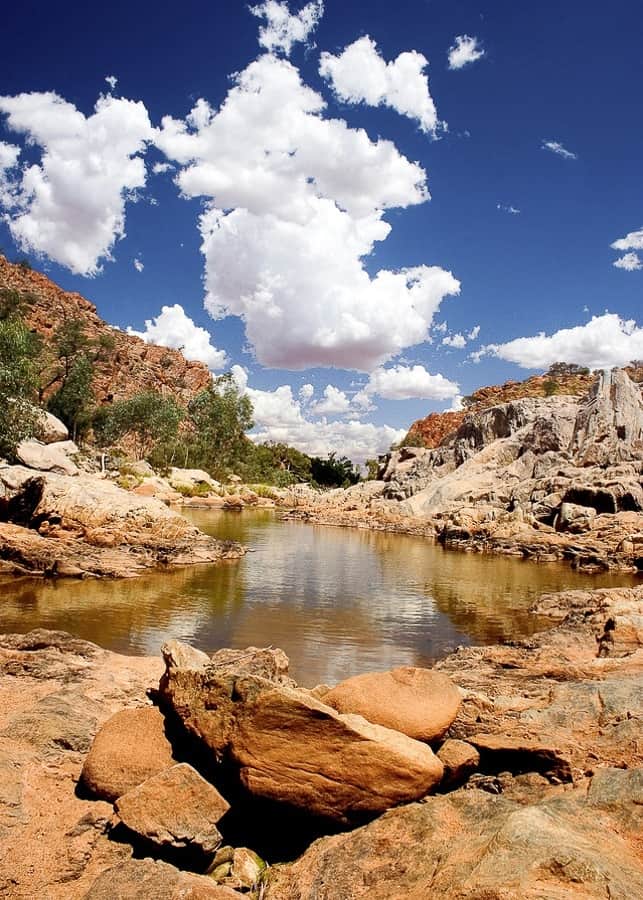
Afterwards, you can make your way to the West MacDonnell Ranges where you can visit the swimming holes of Ormiston Gorge, Ellery Creek Big Hole, Redbank Gorge, and Glen Helen Gorge. If you want, you can pitch a tent by any of these swimming holes and spend a star-filled night before going to your next location.
You can also visit the Fink Gorge National Park, which is home to 458 kilometers of rare plant species that can only be found in the park. Be sure to check out the Fink River, towering sandstone cliffs, salt pans and beautiful mountain ranges.
Here, you can also see the remarkable desert oasis of Palm Valley. This is the only place in the world where you get to see the very rare Red Cabbage Palms, a tree that was a remnant from the time when Australian Outback was wetter.
Uluru is one of the Australian landmarks . Also known as the Ayers Rock, Uluru is a sandstone monolith in the Red Centre. It is considered sacred to the Aboriginals and is thought to have formed 550 million years ago. The reason why you should not miss Uluru is that it changes colors at sunrise or sunset, glowing hot red in the Northern Territory. No wonder it gained the name of Australia’s most natural icon .
During your visit, you can also swim in the tropical pools of Garden of Eden and check out the rock domes of the Lost City . The flora and fauna is also something that will amaze you. Aboriginals would often inform you about the rare plants endemic to the area. The ambiance of the place makes you feel like you are in a different world.
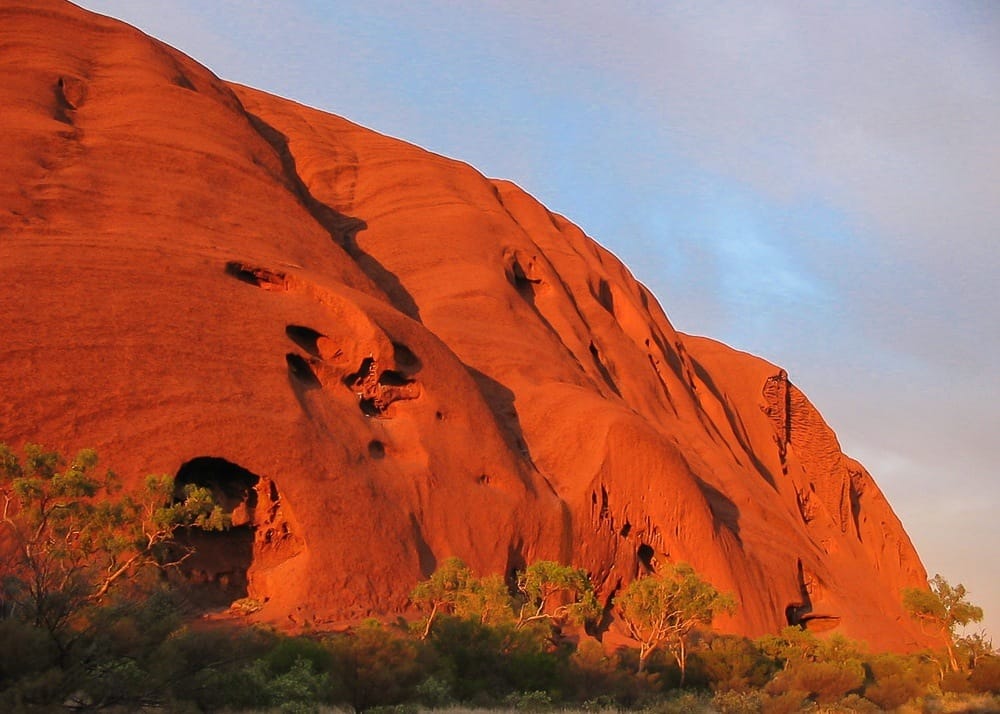
Within the Uluru-Kata Tjuta National Park, you can also visit the 36 red-rock domes of Kata Tjuta, also known as Olgas. There are bushwalking trails you can follow if you want to spend a couple of hours hiking the area.
Take one last trek to the rim of Kings Canyon where you can see amazing views of the gorges of Watarrka National Park. You can also check out the cattle or camel station at the Kings Canyon Wilderness Lodge on Kings Creek Station. Don’t forget to visit Tnorala, a 20 kilometer wide comet crater that is special to Aboriginal people. It is believed to be 140 million years old.
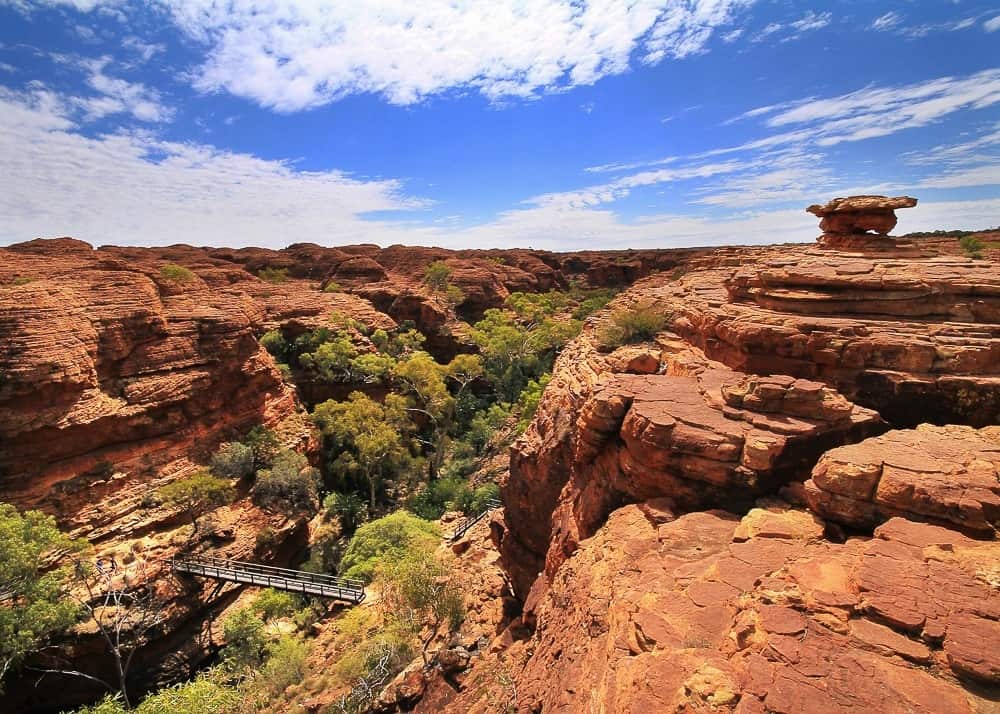
Afterwards, you can cap off a long Red Centre Way tour by relaxing and enjoying gourmet meals at the Kings Canyon Resort. These red rock formations me a lot about the scenery of Sedona, Arizona , There are activities such as helicopter flights or quad bike rides if you want one last look of the rugged bluffs in Kings Canyon.
When you decide to go forward with this trip, remember to research the areas first. The whole trip might take 4 or 5 days, so you might want to look for accommodation in each of the locations or prepare camping equipment. If you are going camping, pack light but make sure you have the following with you:
- Non Perishable food (for when you have cravings and there is no restaurant near you)
- Extra clothes (pack more than what you will need)
- Extra money (for food and other purchases you want to make)
And make sure to drive a vehicle that can take the changing terrains like a caravan, a 2WD, or a 4WD. The Australian Outback is not an easy place to visit, despite driving your own caravan or 4WD to roam around the vast land, the travel can be long and winding.
You need to have the right equipment , enough food and survival gears to be sure that you’ll enjoy your visit. The Outback in the Red Centre Way can be challenging but it is one of the experiences that you will forever be thankful for doing.
Anda is an award winning travel writer, avid globetrotter and passionate photographer. She is the voice behind "Travel Notes & Beyond," a collection of stories and travel impressions from her wanderings around the world. When she is not busy writing, traveling, or editing photographs, you can find her hiking in the foothills behind her house together with her husband and their dog.

Reader Interactions
September 6, 2021 at 9:30 am
As an Aussie, I have not yet visited ‘The Dead Center’ yet. It is on my bucket list. Nature is my thing, I did 1. Great Barrier Reef. dived there, beyond belief . 2. Canarvon Gorge in Qld. (the Aboriginal paintings are exquisit). 3. Tasmania , very good. lots of history & friendly people. 4. Nullarbore Plain, S A.big bugger, not much there. A sign says “if you are crook (sick) come to Cook ( very small town) trying to save it’s Hospital.
Maria Mitchell
November 21, 2018 at 11:12 pm
Amazing places and beautiful photos, I hope to see these places soon when I visit Australia.
August 5, 2018 at 7:43 pm
I am planning on visiting the wonderful country of Australia this year, and I am really looking forward to it after seeing these beautiful photos you shared with us.
Agness of eTramping
August 26, 2017 at 9:38 am
Wow! These places are simply breathtaking and amazing destinations. Which ones would you choose as a great place for hiking?
Michelle | michwanderlust
August 25, 2017 at 8:49 pm
Loved this post and stunning photos as usual! As I travel more / get older (not sure which of these is to blame), I find myself being drawn more to the countryside and away from the cities. Australian cities aren’t very high on my priority list, but I’d definitely visit the outback just to see that amazing scenery you’ve outlined!
Ruth | Tanama Tales
August 25, 2017 at 8:04 pm
There are so many gorgeous places in Australia’s Outback. Not sure if I am going to make it there one day but I can dream about it. I think I will have to conform with the red tones of our Southwest (I can not complain about that).
Anda Galffy
August 27, 2017 at 2:17 am
Yea, I hear you Ruth. I believe our Southwest areas are equally beautiful.
Lydia C. Lee
August 25, 2017 at 7:06 pm
Really want to visit – not been yet, can you believe?!
Mary {The World Is A Book}
August 25, 2017 at 5:24 pm
What a beautiful area! We’ve been to Sydney, Melbourne and the Great Barrier Reef area but have missed this unique area. Uluru has been on the wish list for some time.
August 25, 2017 at 1:55 pm
We love caravan road trips! We drove 3 weeks from Sydney to Cairns and the part we enjoyed the most was the less inhabited places. We would love to go on a trip to the red centre, just the 24hours flight hold us back
August 30, 2017 at 1:19 am
I agree, There. A 24-hour flight would scare me too, especially with two small children.
August 25, 2017 at 1:32 pm
I can’t agree more! I loved travelling through the red centre of Australia, such stunning scenery. For us Dutchies it was so spectacular as we were never that far removed from the sea before!
August 30, 2017 at 1:24 am
Hahaha, I hear you, Esther. Thanks for dropping by this weekend.
August 25, 2017 at 1:01 pm
I’ve not been to Australia but whoa – fantastic photos! And it’s on my list, isn’t it on everyone’s? Looks wonderful!
Lyn aka The Travelling Lindfields
August 25, 2017 at 5:00 am
Uluru is also known as ‘Ayers Rock’ not Avery Rocks. It is a stunning natural sight and not just because it appears to change colour with the changing light. One thing you haven’t mentioned is that it is extremely hot in the centre of Australia in summer so it is sensible to go in winter.
August 30, 2017 at 1:46 am
Hahaha, I wrote ‘Ayers Rock’ but the computer turned it into ‘Avery Rock’ without me noticing it. Thanks for pointing that out, Lyn.
Rhonda Albom
August 24, 2017 at 7:38 pm
I have visited quite a few of the major cities and some of the coastal areas of Australia but have not gone too far inland. It is a vast wilderness and your photos make it enticing.
Leave a Reply Cancel reply
Your email address will not be published. Required fields are marked *
Save my name, email, and website in this browser for the next time I comment.
COPYRIGHT NOTICE
All rights reserved © Travel Notes & Beyond. The material on this website is protected by copyright law. Republishing the content on this blog (including text, photography, etc.) is strictly prohibited.

AFFILIATE PROGRAM DISCLOSURE
Some of the pages and posts of this blog contain links to products and services that may be useful for my readers. When clicking on these links you will have the option to purchase or register for a service at no extra cost to you, but doing so can help me offset the costs associated with running this blog. Thank you for your support!

- +61 3 9125 3630
- Hi, {{firstName}}!
- Shortlist sign-up
- Shortlist log in
- My Shortlist
- Change password
- Travel agent? Log in here
Your browser 'Internet Explorer' is out of date. Update your browser for more security, comfort and the best experience on this site.
Outback Yarns Blog
- Agent Portal
- Live Chat Live Chat (Offline)

- Australian Outback Tours & Travel
Last-minute Sale - Up to 20% OFF
Red centre, western australia, kimberley & top end, northern territory, the australian outback is steeped in aboriginal history, the landscape part of the myth and legend known as the dreaming.
From seemingly endless red desert to cooling pools, towering rock formations to night skies that burst with stars, there’s a whole new world to discover on our Australian Outback adventures. Experience the grandeur of Uluru , hear tales of the First Nations Peoples , take in the scenery from a 4WD, explore a natural amphitheatre at Kings Canyon , walk among a carpet of wildflowers in the Flinders Ranges , noodle for opal in Coober Pedy , indulge in gourmet bush tucker or go on a ‘goat muster’ at a working cattle station. ATA Australian Outback tours are packed with adventure and authentic Aussie experiences.
Our Australian Outback tours
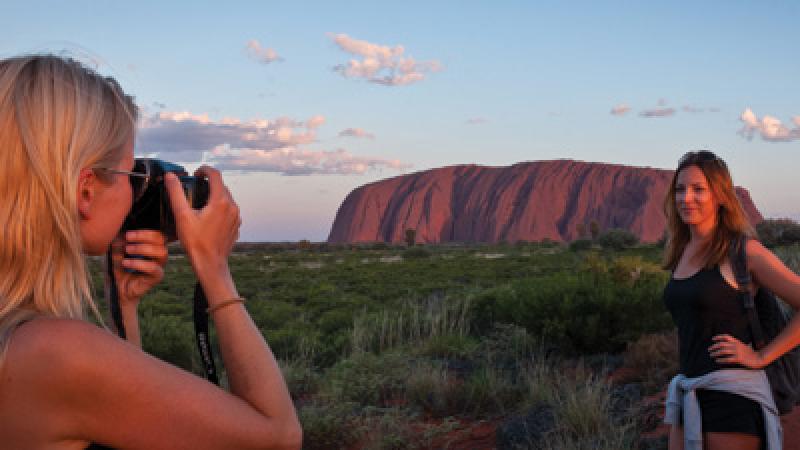
2 Night MacDonnell Ranges Adventure (Alice Springs to Alice Springs)
2 days from $545.
Arguably the best kept secrets of the Red Centre, the West and…
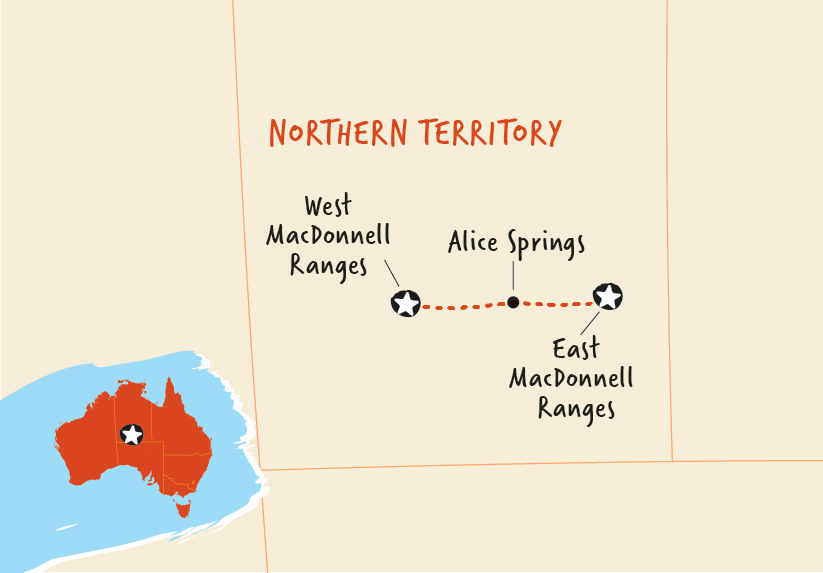
Overnight Uluru Adventure (Yulara to Yulara)
2 days from $595.
Journey into outback Australia and experience Uluru, the Olgas and the intriguing…
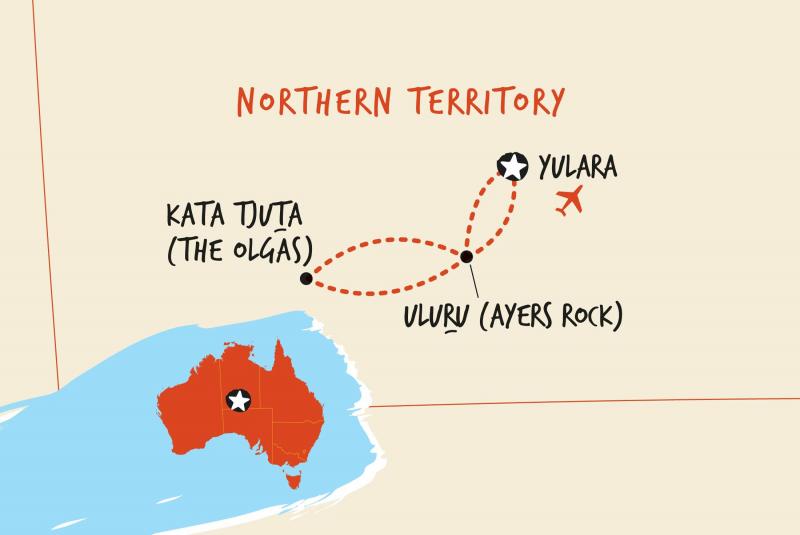
Rock the Centre (Yulara to Alice Springs)
3 days from $695.
See the Outback’s best-known attractions in just three days on this camping…

Rock the Centre (Alice Springs to Alice Springs)
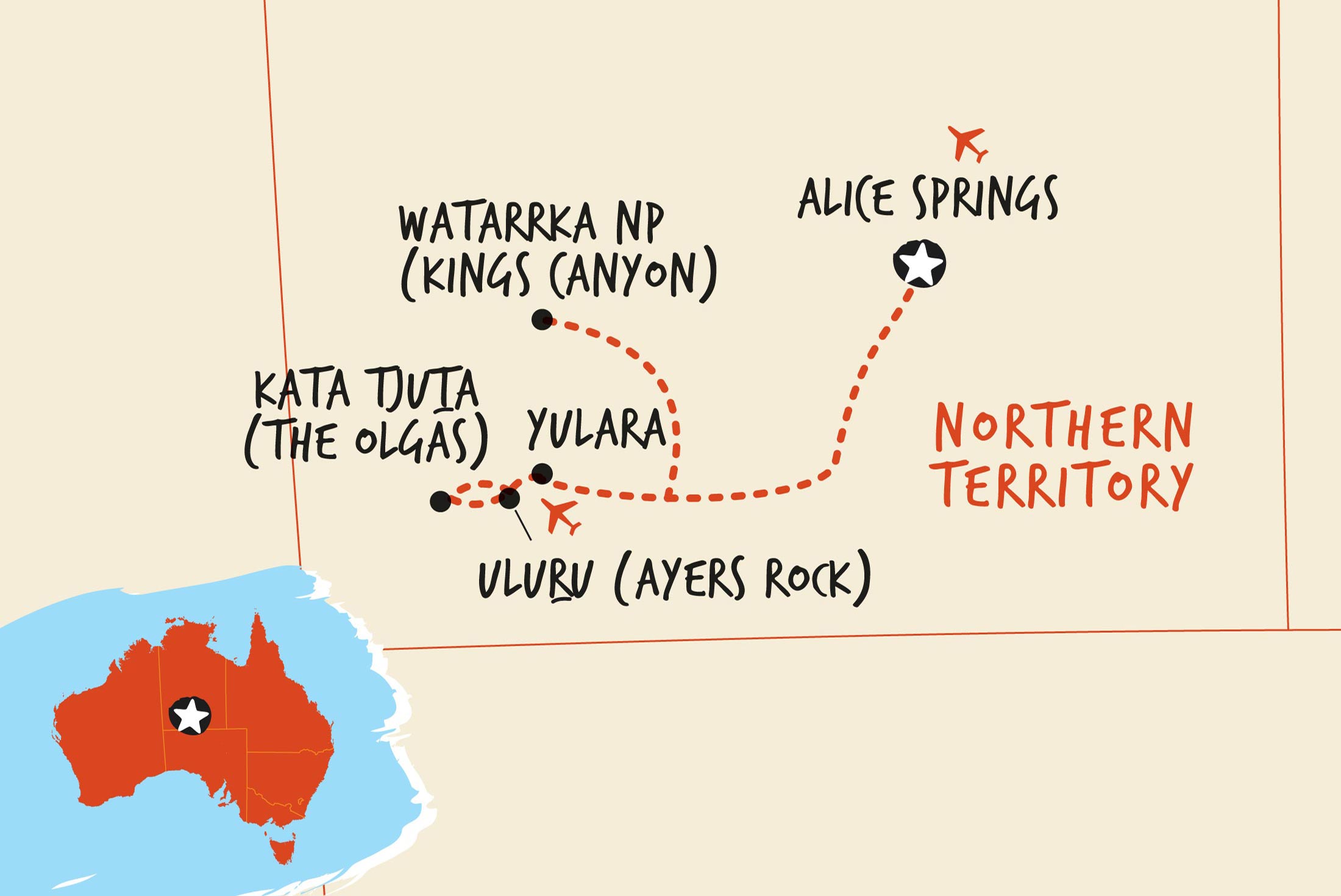
3 Night Rock the Centre (Yulara to Yulara)
4 days from $745.
Pushed for time? Strapped for cash? This trip starts and finishes at…

3 Night Rock the Centre (Alice Springs to Yulara)
Strapped for cash? This trip starts at Alice Springs and finishes at…
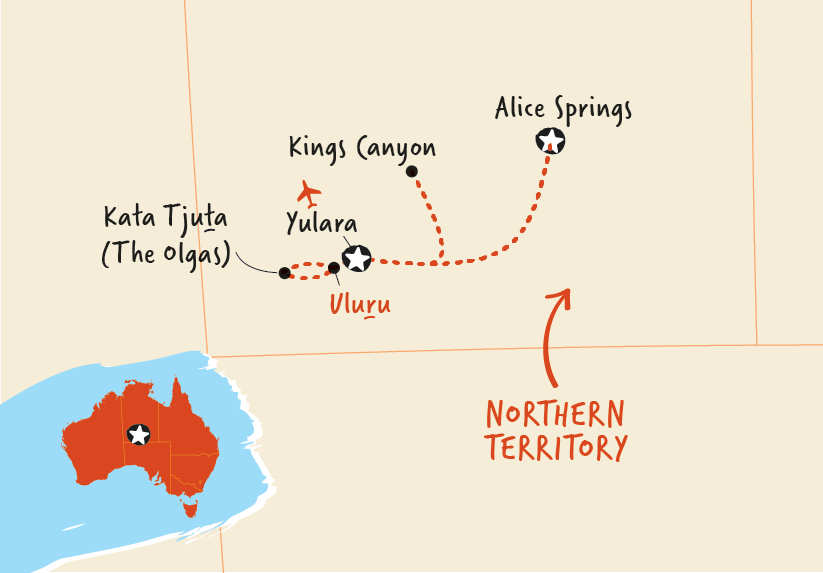
Uluru Adventure (Yulara to Alice Springs)
3 days from $896.
Experience Uluru (Ayers Rock), Watarrka National Park, Kings Canyon and Kata Tjuta…
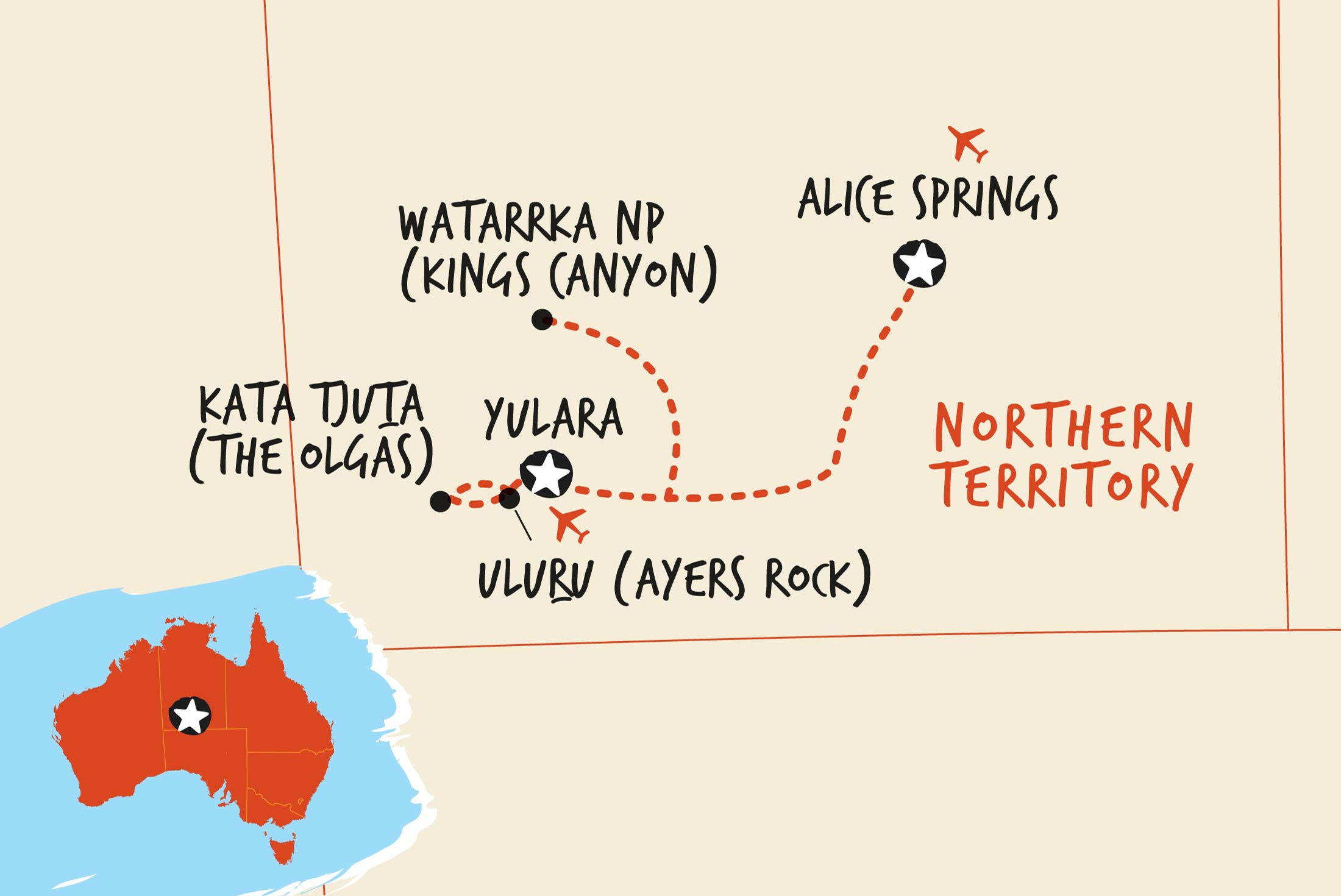
Uluru Adventure (Alice Springs to Alice Springs)
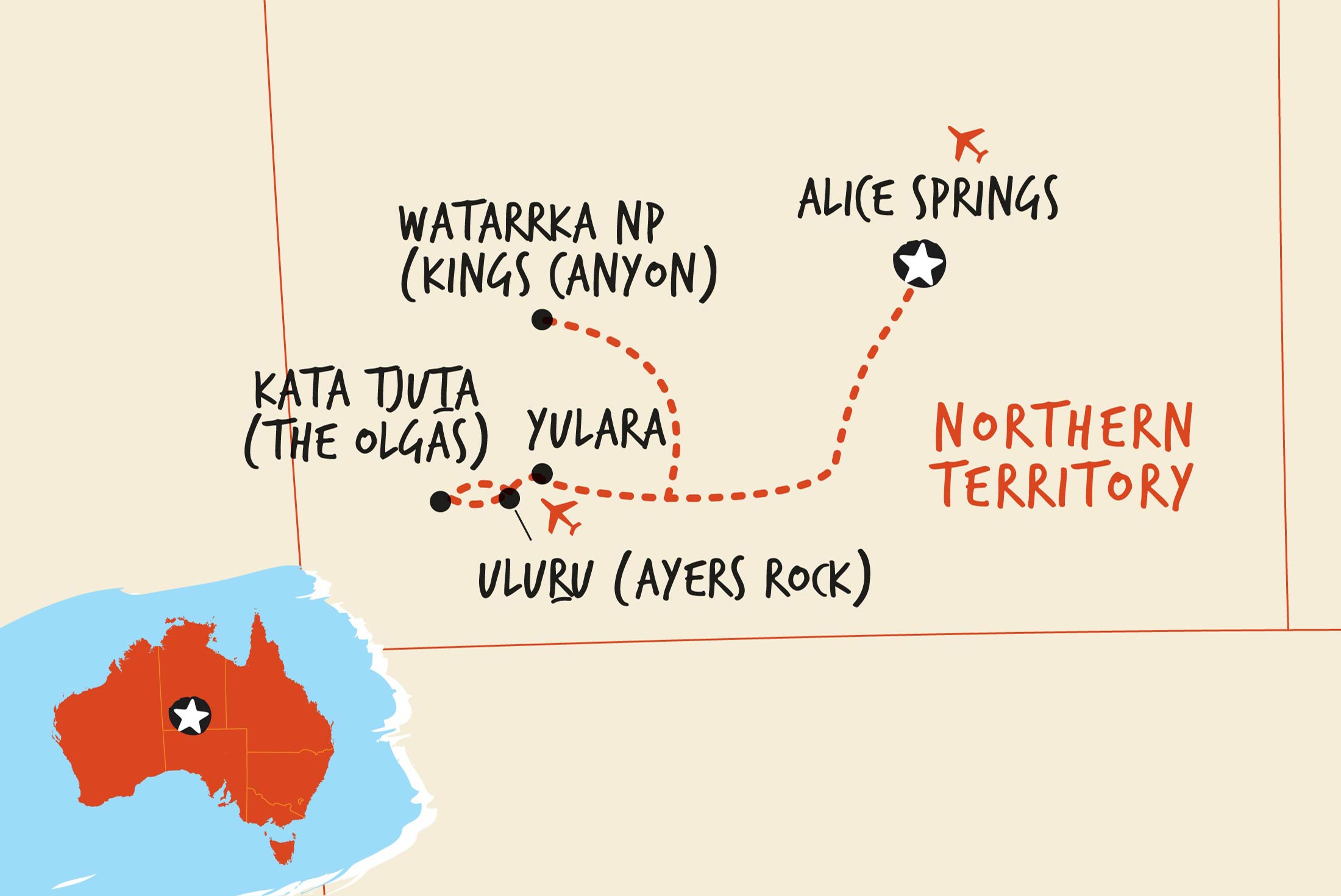
3 Night Uluru Adventure (Yulara to Yulara)
4 days from $1,076.
Experience the highlights of the Red Centre in just 3 nights.

Perth to Monkey Mia & Return
The only way to see Western Australia’s Coral Coast, in only 4…

3 Night Uluru Adventure (Alice Springs to Yulara)
Go camping in the Australian outback on this 3 night stay visiting…

5 Night Perth to Exmouth Adventure
5 days from $1,256.
Experience Western Australia’s amazing Coastline, in less than a week.

Esperance & Southwest Adventure
6 days from $1,395.
The southwestern reaches of Western Australia are defined by rolling vineyards, lush…
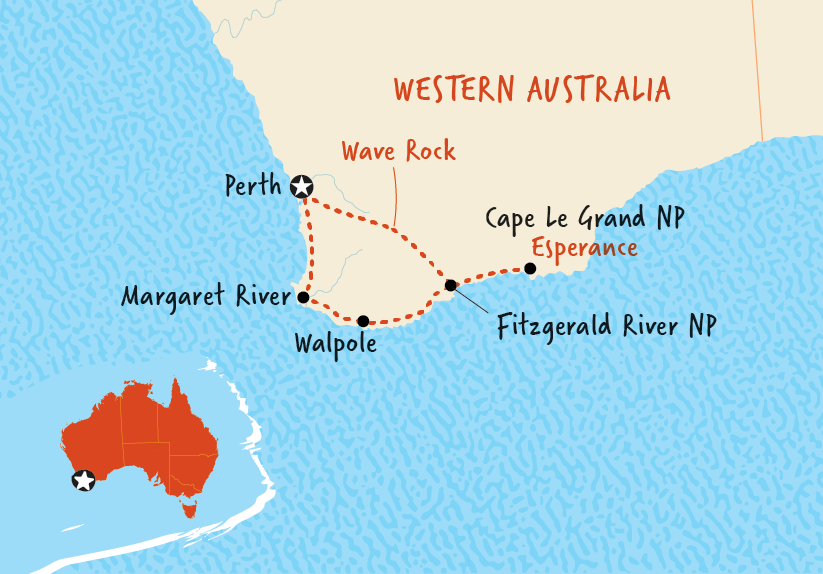
Outback Camping Adventure (Alice Springs to Alice Springs)
5 days from $1,196.
Get to know the Red Centre at your own pace with a…
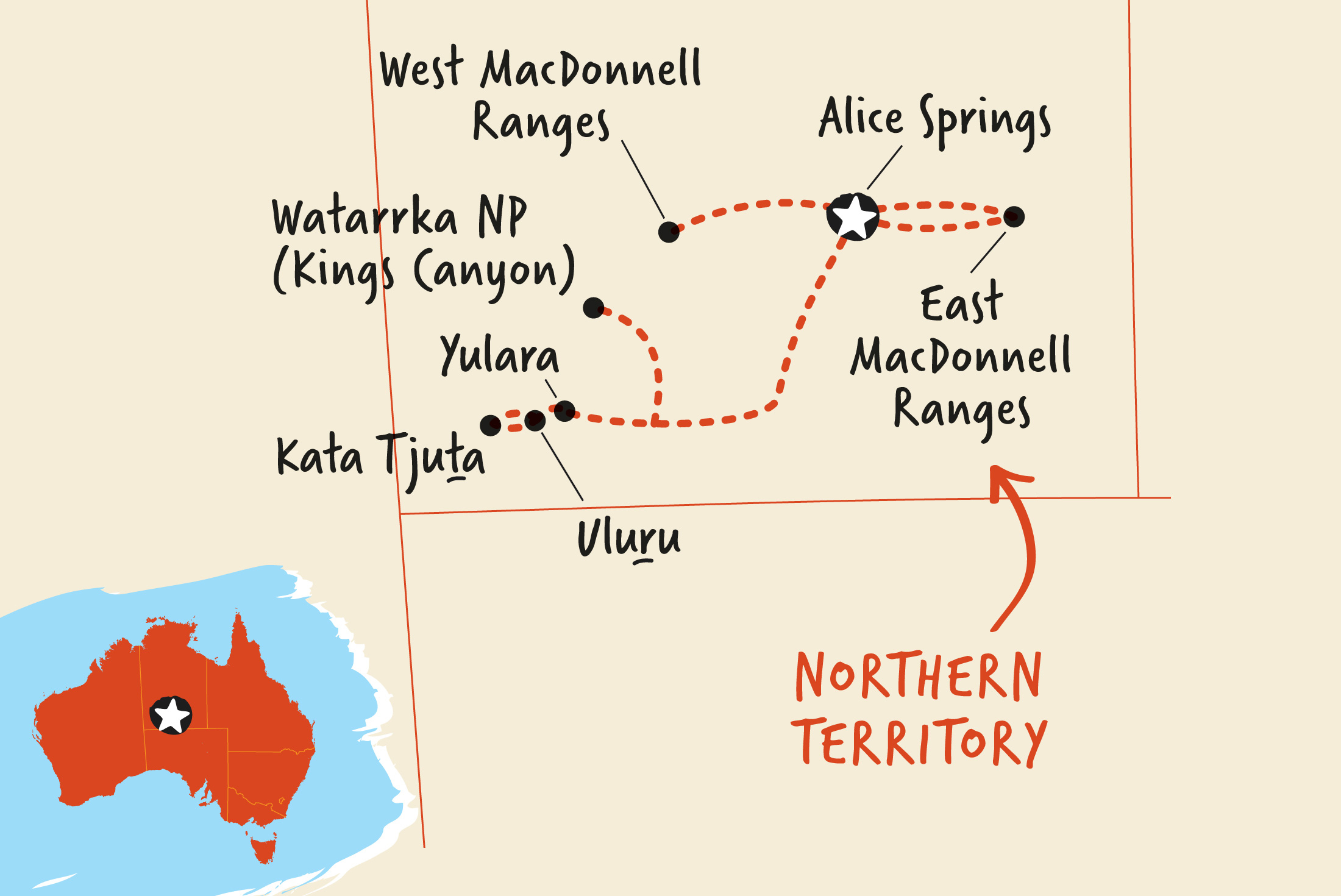
Outback Camping Adventure (Yulara to Alice Springs)
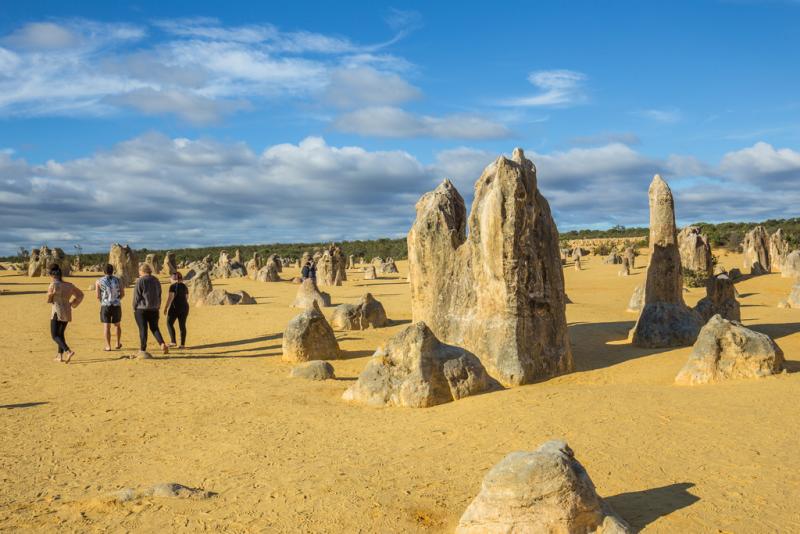
Perth to Ningaloo Reef & Return
7 days from $1,436.
The only way to capture the Best of the West, in less…
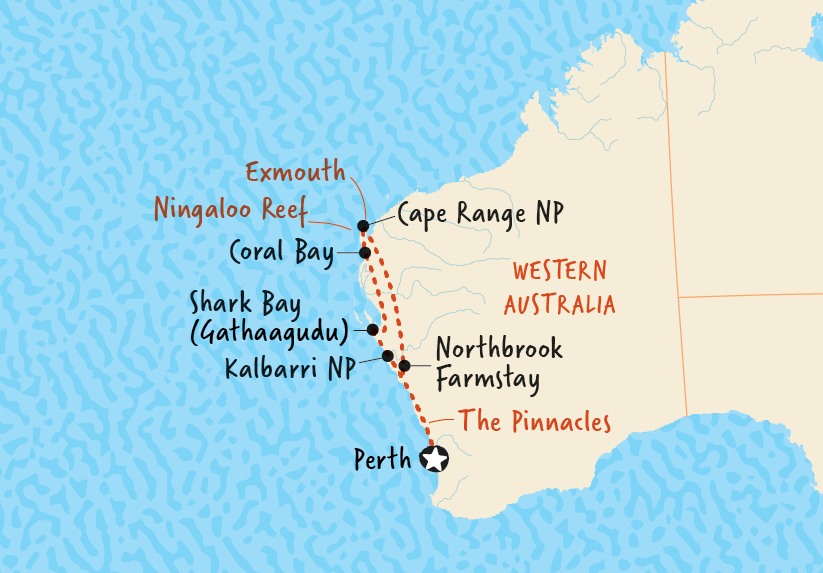
Perth to Exmouth & Return

Uluru to Adelaide Adventure
8 days from $1,995.
Experience moments in nature that will stay with you for a lifetime…
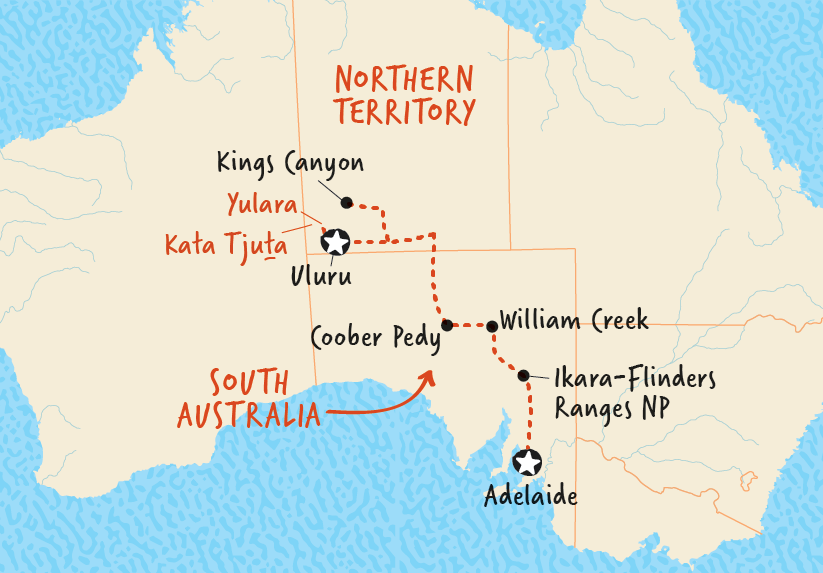
Uluru to Kakadu & Litchfield Package, incl Alice-Darwin overnight transfer
8 days from $1,945.
See all the Red Centre and Kakadu attractions in eight (8) days…
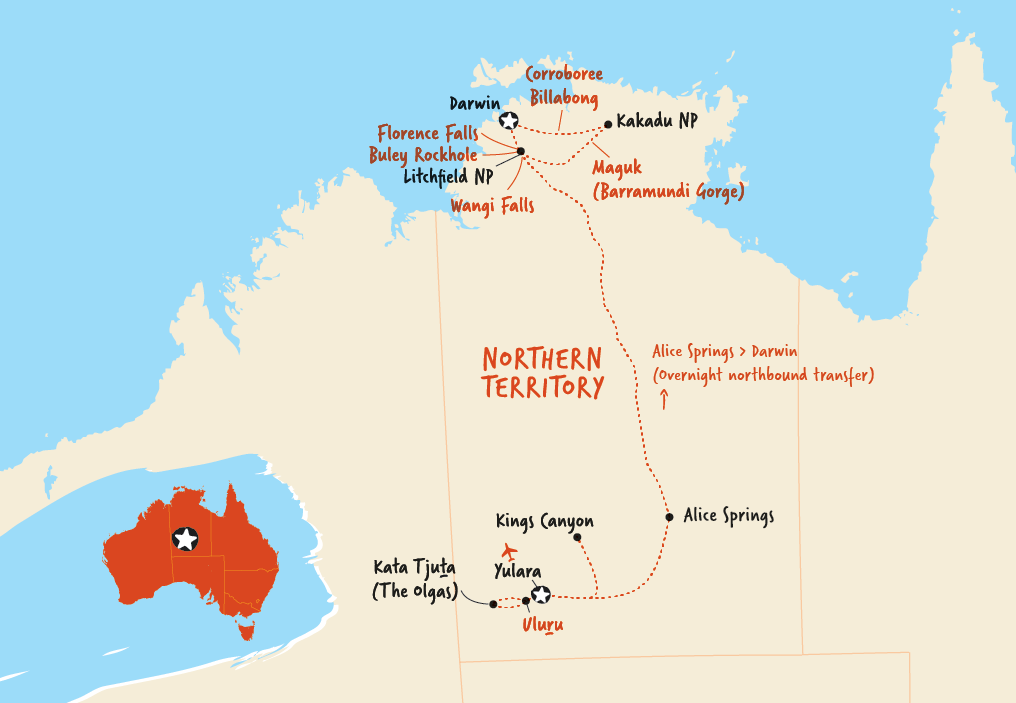
Uluru to Kakadu Adventure Package, incl Alice-Darwin overnight
See all the Red Centre and Kakadu attractions in eight days at…
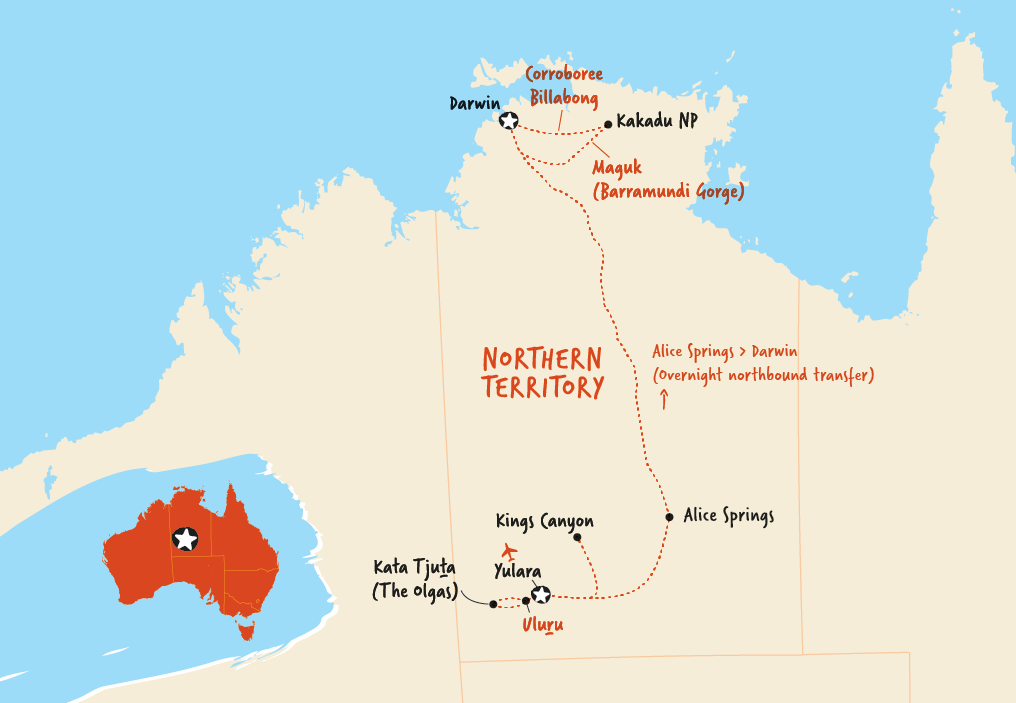
Top destinations for Australian Outback adventures

South Australia

Western Australia

The Kimberley
Outback tour reviews, trip rating, time of year, esperance & southwest adventure , december 2019.
Thanks Adventure Tours for managing our itinerary during the tour so as to keep us safe and to ensure a good experience even with the worst fire season known in Australia unfolding throughout the nation in the summer of 2020. Some of your tours were cancelled where necessary. I felt we were in good hands throughout.
Review submitted 11 Jan 2020
- 1 --> Previous
- Page 1 of 22
Articles on the Australian Outback
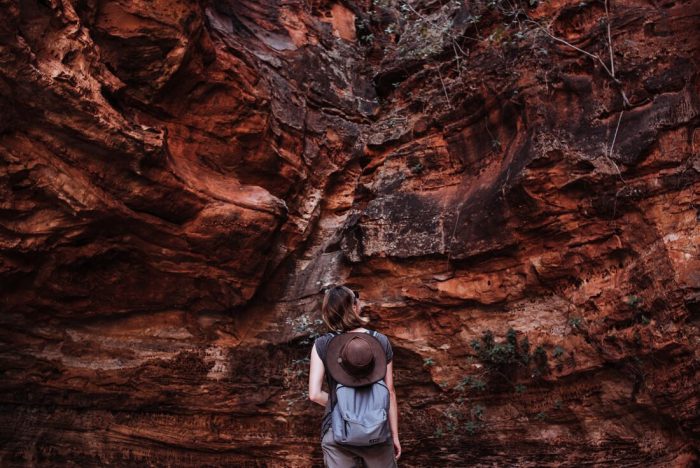

10 unmissable Aussie experiences you need in…
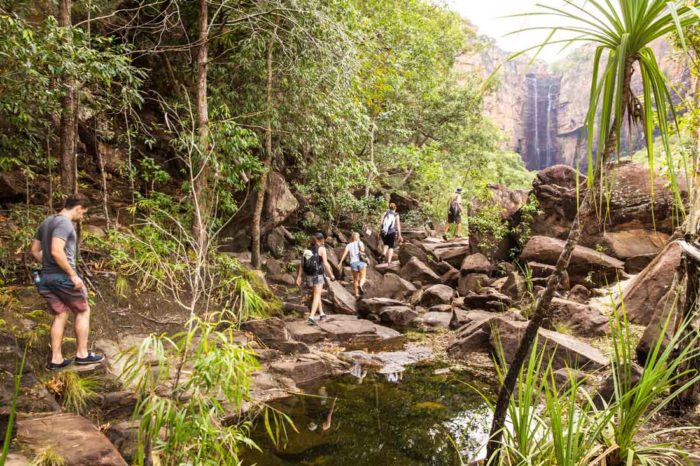
Why travelling during the wet season shouldn’t…
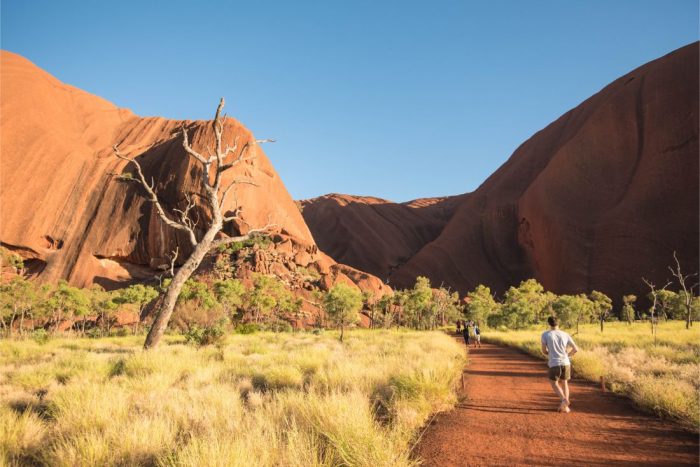
Everything you’ll see on a 3-day camping trip…
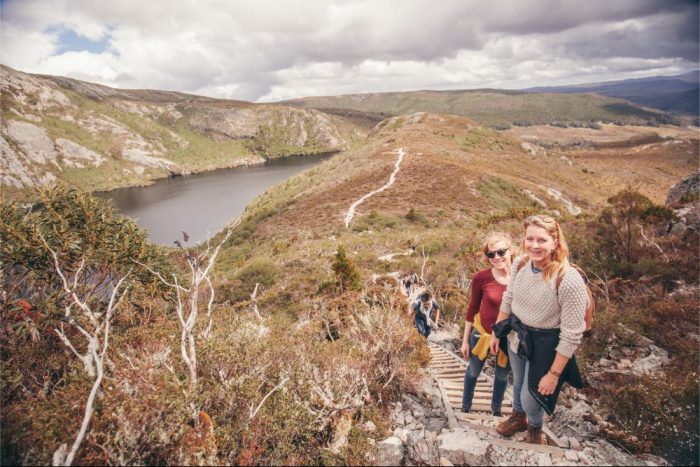
Walk this way: 8 of the best day hikes in…
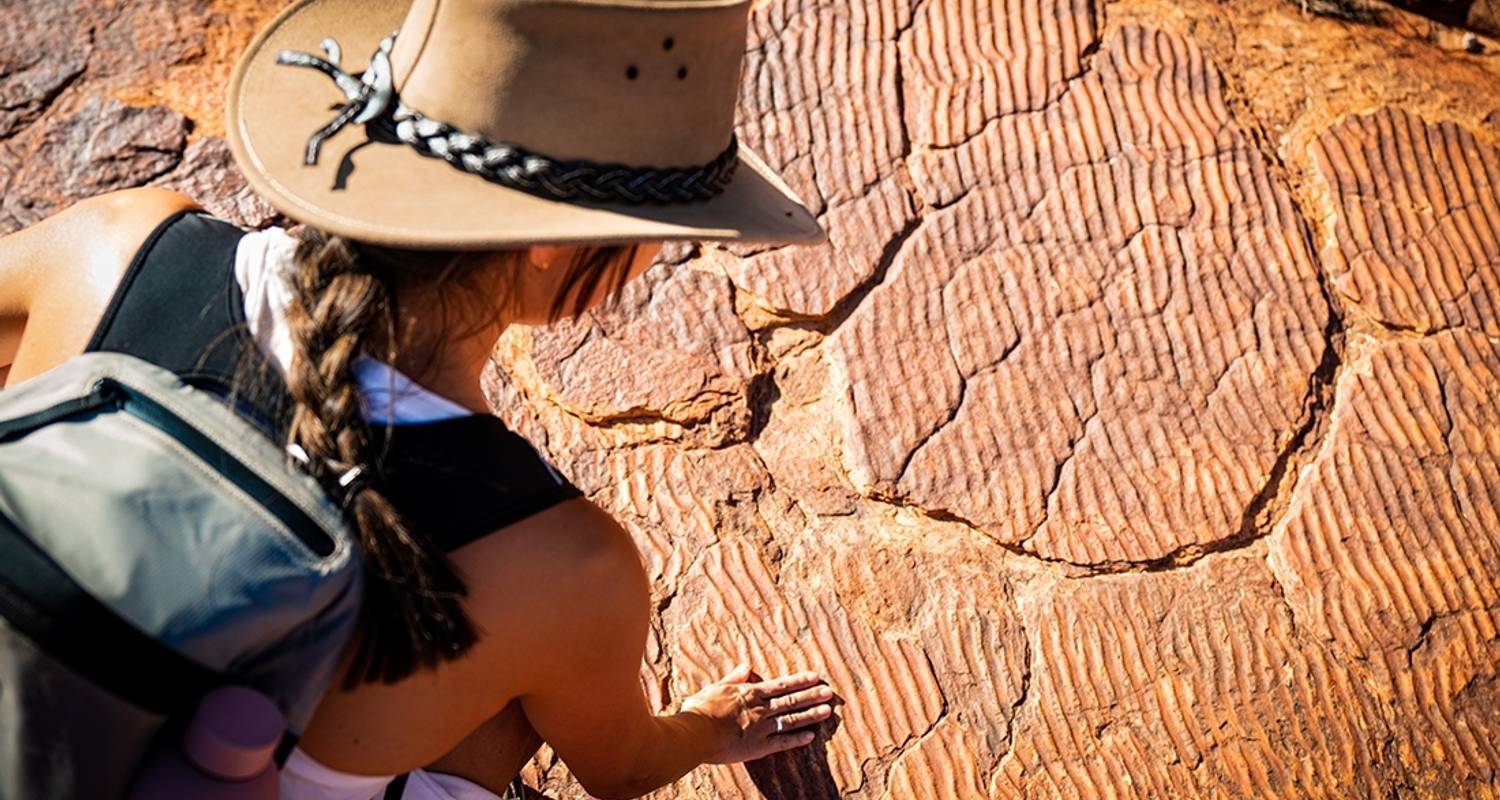
Australian Outback Tours & Trips
- Choose from 100+ Australian Outback tours
- 100+ verified reviews from TourRadar travelers
- 24/7 customer support
10 best Australian Outback tour packages
Compiled by

Melissa Australian Outback travel expert at TourRadar
8-Day Adelaide to Uluru Tour
8-day uluru to adelaide tour, 3 day uluru kata-tjuta kings canyon (camping) - from alice springs, uluru & kings canyon adventure, 3 day uluru red centre kings canyon (camping) - from ayers rock, northern territory escape with uluru tour, australia: uluru explorer (4 days), 3 day uluru adventure, outback highlights (short break, 5 days), best of uluru & kings canyon (4 destinations).
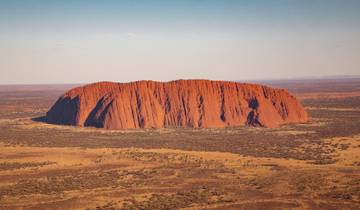
- Be mesmerised by spiritual sites like Kata Tjuta and Kings Canyon
- Connect with nature on inspiring and rewarding hikes
- Fall asleep in a dugout tucked beneath the Earth’s surface in Coober Pedy
“I loved being able to camp in the outback and see such unique places in Australia. This tour was truly my favorite thing I did on my trip.”

- Christmas & New Year
- Unearth the ancient Ikara-Flinders Ranges National Park
“Amazing views, beautiful sunrise hikes, (bush) camping in swags and learning so much about geological and cultural history.”
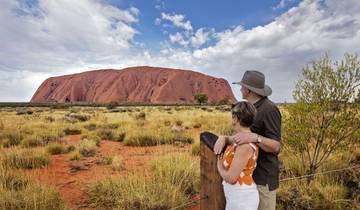
- Witness a majestic Uluru sunset with dinner
- Enjoy a campfire meal in the Kings Canyon region
- Trek the towering cliffs of Kings Canyon
“It was a great experience and we would definitely not have got the same if we had hired a car and done it by ourselves.”
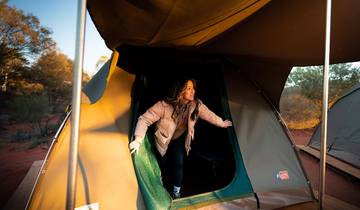
- Experience sunrise and sacred sites at Uluru
- Watch the sunset over Uluru's sandstone
- Discover bush tucker with First Nations guides
“Tents no hassle, well organised. A great story teller.”
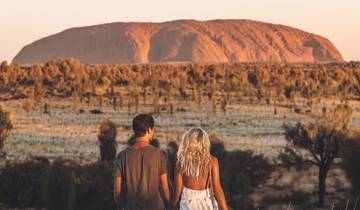
- Explore Uluru's base and sacred rock art sites
- Enjoy campfire meals in the Australian outback
- Witness Uluru's sunset while dining outdoors
“The tour was amazing, and it was so interesting listening to the guide.”
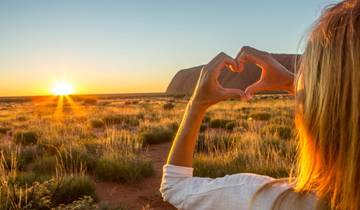
- Sightseeing
- Hike through Simpsons Gap and Standley Chasm
- Discover Uluru with a cultural walk and sunset BBQ
- Explore Alice Springs' heritage on a guided walk

- Trek around King's Canyon and visit Garden of Eden
- Join a dot painting workshop in Uluru
- Explore Uluru at sunrise for stunning views
“Very nice trip :-))).”
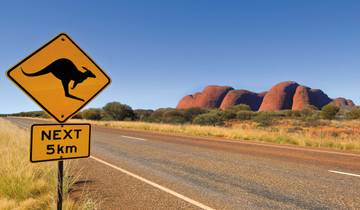
- Watch the sunset over Uluru with snacks
- Hike through the domes of Kata Tjuta
- Explore a working camel farm in Alice Springs
“Truly a breathtaking experience. The stunning landscapes and rich cultural heritage left me in awe.”

- Wander through Munro's magical Field of Light
- Dine under the stars at the Sounds of Silence Dinner
- Explore the Uluru base and enjoy a sunset with wine

- Walking Adventure
- Witness Uluru at sunset, a breathtaking sight
- Catch the sunrise over Uluru and visit cultural sites
- Hike the majestic Kings Canyon rim
Other Regions in Australia
Discover TourRadar

Outback Destinations
The outback has many destinations to choose from….
In fact, lots of people who visit tell us they see the Outback as a tourist destination in itself – just because of its size!
Here’s a quick introduction to some of the most popular places.
Alice Springs is the heart and soul of the Outback. The number one destination in Outback Austalia. Make Alice Springs your base for exploring the Outback! It’s located central to everywhere else.. not just in the Outback but in Australia!
Ayers Rock/Uluru – Australia’s best known tourist attraction. Visit the most famous destination in Australia. Learn about Aboriginal culture and Dreaming. Want to save money visiting Ayers Rock? Let us share our local knowledge with you.
Alice Springs Desert Park. The Desert Park is one of the Outback’s best tourist attractions. The Desert Park reveals the Outback to you -its Aboriginal culture, its environment (you get to walk through every single desert habitat), its plants and animals. Make it your first stop in Alice Springs.
Kings Canyon/Watarrka. Located 350km from Alice Springs and about 300km from Ayers Rock, Watarrka is another top Outback destination. Some people say it’s even BETTER than Uluru! Make sure you visit to find out why.
Lake Eyre – Australia’s largest lake. I rate seeing Lake Eyre full second only to going to Mount Everest in terms of travel experiences. We’ve got a whole section of the site devoted to getting you out there!
Port Augusta – Crossroads of Australia . Located at the top of Spencer Gulf, Port Augusta is where the desert meets the sea. Like Alice Springs, we recommend that you use it as a base for your exploring top Outback destinations in South Australia
Coober Pedy – Opal Capital of the World. Coober Pedy is located about halfway between Alice Springs and Port Augusta. It’s one of Australia’s most unique tourist attractions. Lots of people visit Coober Pedy to stay in underground accommodation, and of course, to see the opals!
Tennant Creek. Located 505km north of Alice Springs and 1000km south of Darwin, Tennant Creek is everything you’d imagine a town in Outback Australia to be: quirky, friendly, and full of living history. It makes an ideal base to explore the Barkly Region – the ‘subtropical north’ of the Australian Outback.
The West MacDonnell Ranges. The MacDonnell Ranges often get ignored by tourists rushing off to see Ayers Rock. In our opinion, they’re one of the top Outback destinations. Don’t miss out on the gorges, waterholes and peaceful bush camping sites
The East MacDonnell Ranges . The East Macs (as we locals call them) are the perfect place to get away from tourist crowds in the Outback. Little-known swimming holes, gorges and gold mines you can explore yourself, the East Macs are an easy hour’s drive from Alice Springs. You don’t even need an off road vehicle!
Palm Valley/Finke Gorge National Park. Want some easy off road driving with a spectacular finish. A beautiful campground with hot showers and free barbeques? Then an overnight visit to Palm Valley is a must. Located 130km west of Alice Springs, Palm Valley can be seen in a day or, why not take our advice and stay the night?
The Stuart Highway . Where else in the world can you drive for 1100km on a bitumen road, without a single traffic light, and scarcely a bend? But it’s not just a boring, long straight road! We’ve written a special guide to the tourist attractions, secret spots, roadhouses and how to survive really, really long road trips.
The Simpson Desert . There are other deserts in Australia, but there is only one Simpson. We think it’s the most magical, special, beautiful place in the entire Outback. Find out how to camp out in the Simpson and how to explore its desert tracks.


The Ultimate Australian Outback/ Northern Territory Travel Itinerary
They say you haven’t been Down Under until you’ve been to the Outback , and after recently finishing a two week long Northern Territory trip – I would completely agree with that statement!
Known for its adventurous spirit, majestic landscapes, ancient Aboriginal history, and diverse Outback wildlife, the Northern Territory is a truly remarkable destination where travelers can see the real Australia for themselves.
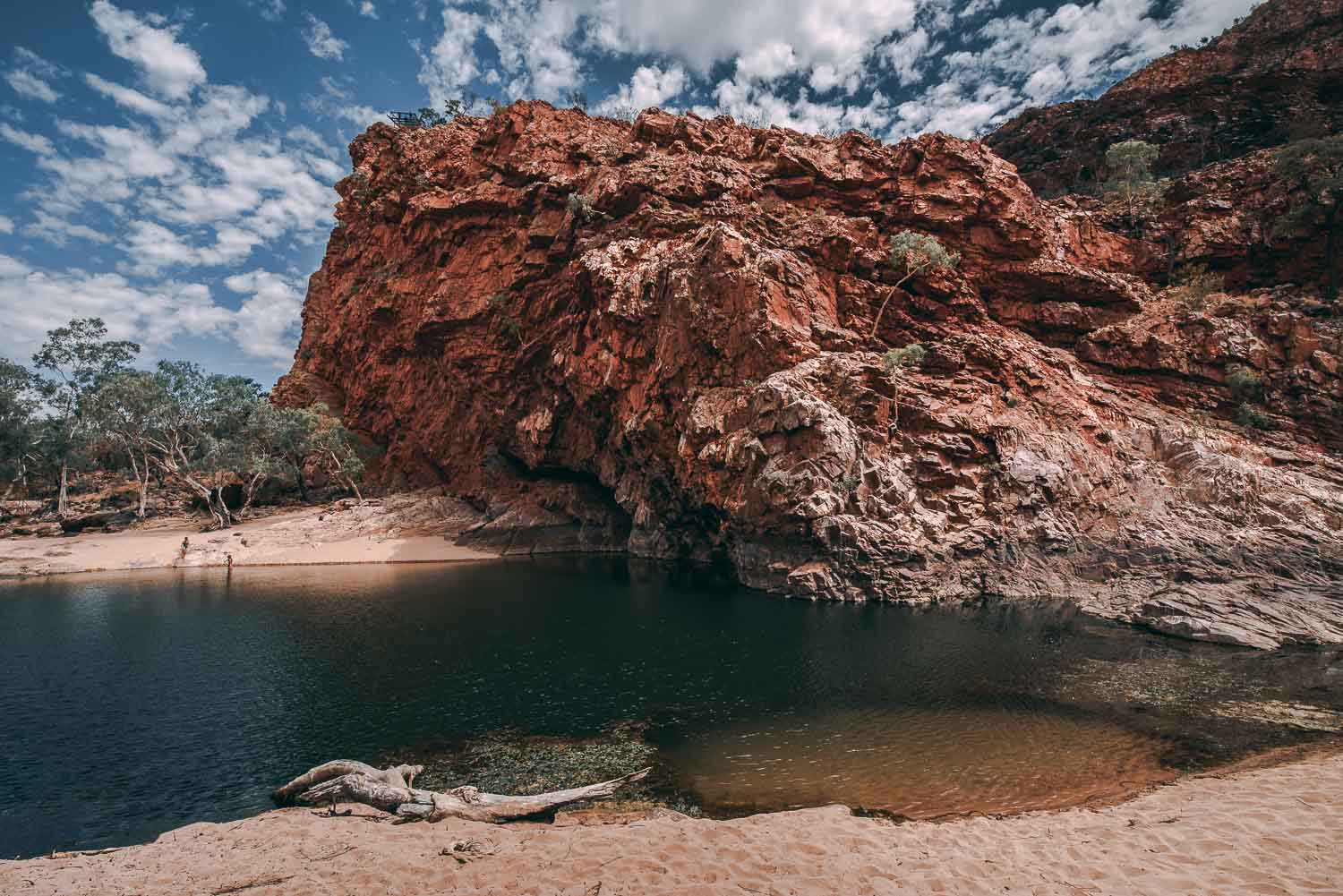
I’ve spent a lot of time traveling around Oz, and it’s easily one of my favorite countries in the world. From working my way down the coast from Cairns to Sydney , to road-tripping along the world famous Great Ocean Road, and taking selfies with native quokkas on Rottnest Island in Western Australia – I’ve explored many destinations that make this country a world-class tourism destination.
So I was unbelievably excited when I got invited to explore the Northern Territory for a couple weeks, and finally experience the famous “Australian Outback”. Take a read through my itinerary, browse through my photos, and feel free to reach out to me if you have any questions about traveling through this unique destination!
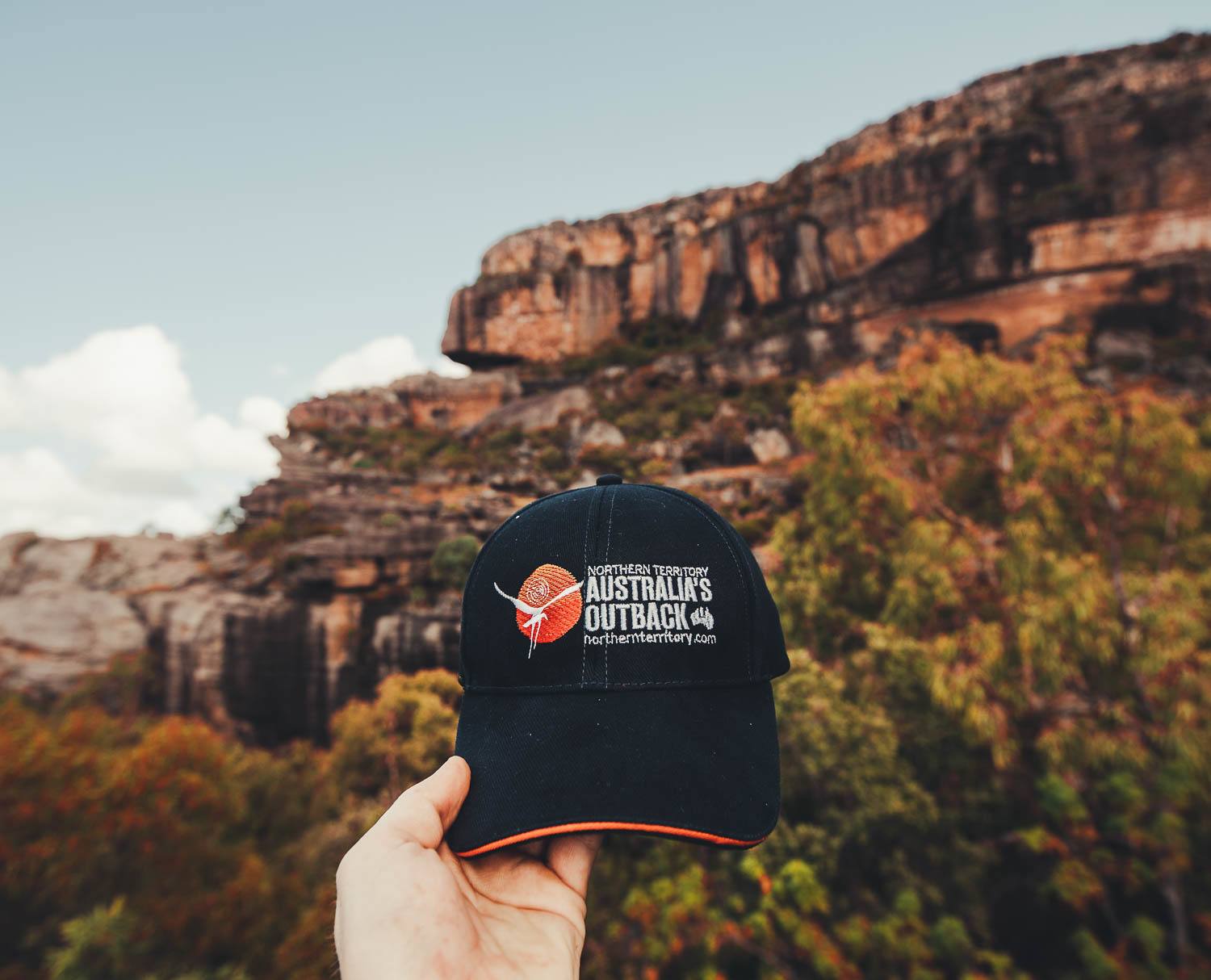
Organized Tour vs Rental Car
The first question of traveling through the Outback…
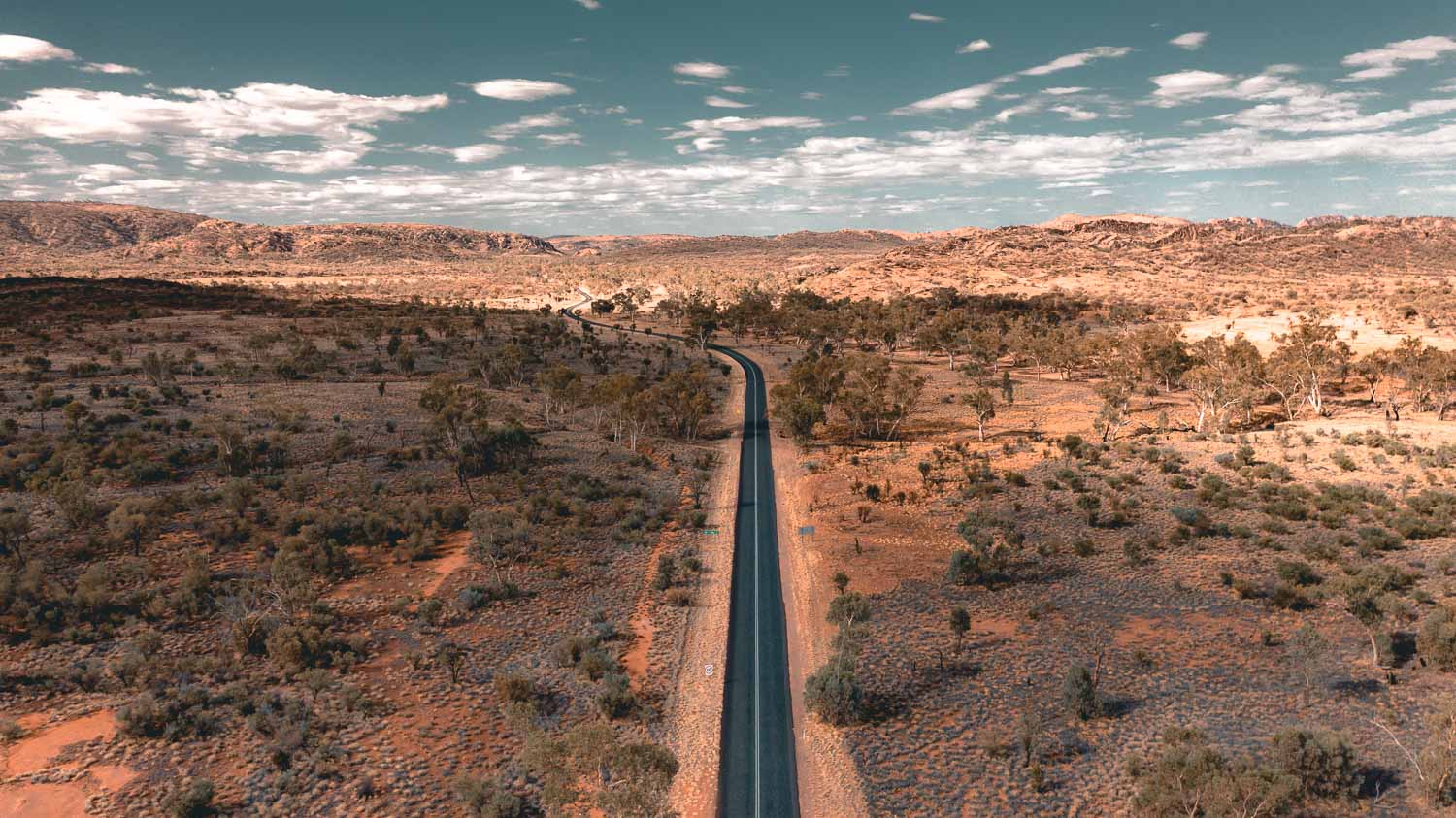
When I traveled through the Northern Territory I was on a press trip with the NT Tourism board , so everything was fortunately pre-arranged for me. If I was doing this trip on my own, I would be sure to pre-plan as much as I could before I arrived!
There are a huge number of tour groups you can book that head to the Northern Territory from all pockets of Australia, or alternatively, you can join one upon your arrival in the Outback. It’s entirely up to you. The benefit of traveling with a small group tour is that you not only have company, but everything is organized for you. It doesn’t matter if you overlook or forget something – everything is sorted out by the experts for you, and it usually works out to be much cheaper in the long run. You just have to sit back and enjoy the experience.
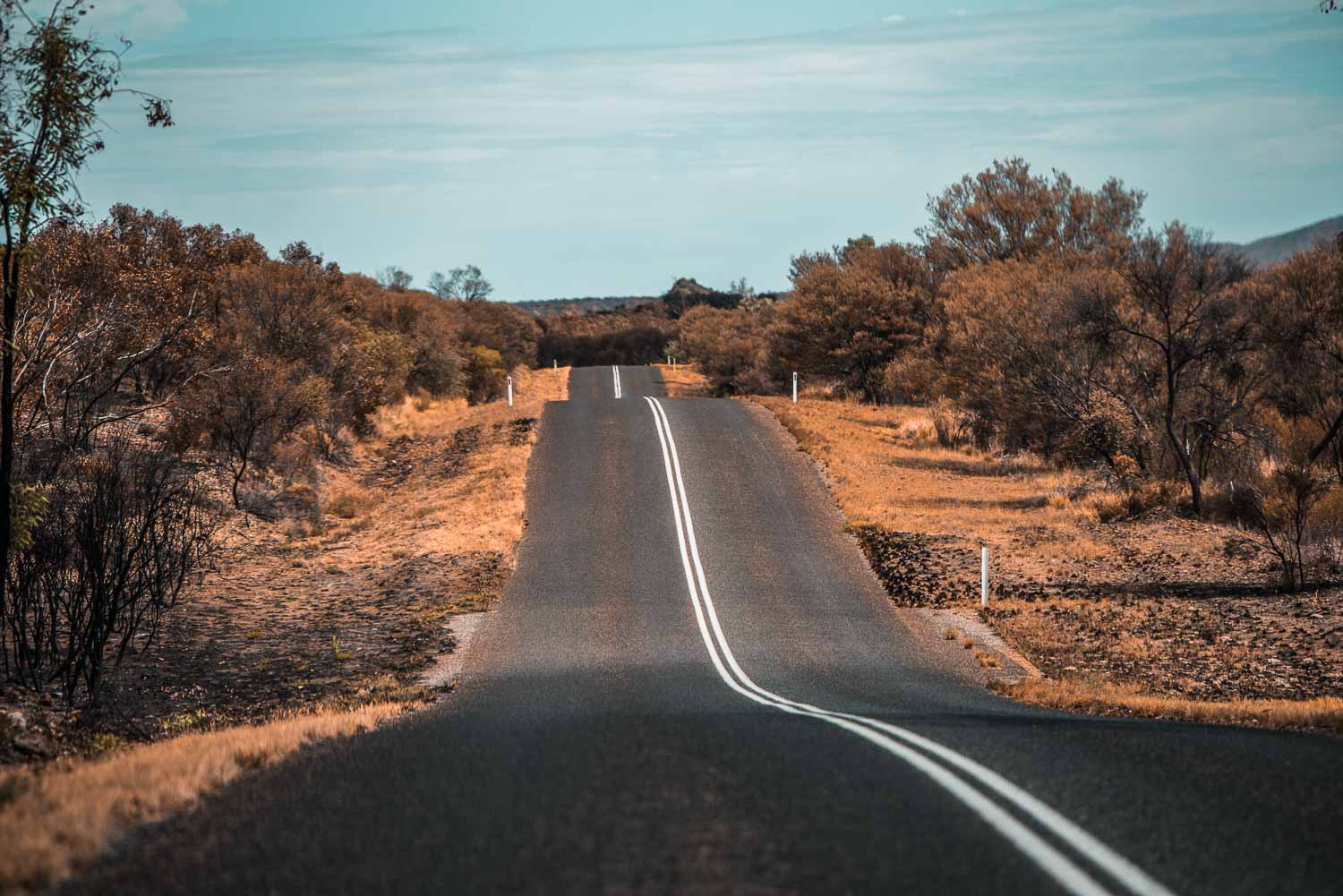
While group tours are perfect for many people, particularly solo travelers, others find a strict itinerary stifling or restrictive and would rather travel without these confines. Just remember, traveling in the Outback requires a fair amount of preparation and knowledge , and this remote area of the world can be dangerous.
Traveling with a friend or two is definitely better than traveling alone out here, and you can split the driving schedule between you – and the cost! There are many car rental companies with pick-up and drop-off locations in major locations within the Northern Territory. The best part is you can easily organize to pick up a car in Darwin, for example, and drop it off when you reach your location in Alice Springs. The NT is very well set-up for tourists, and should you need help, you can generally get it.
How you choose to travel through the Northern Territory is up to you. Just be safe, prepared and stocked up with all the essentials you will need if disaster strikes.
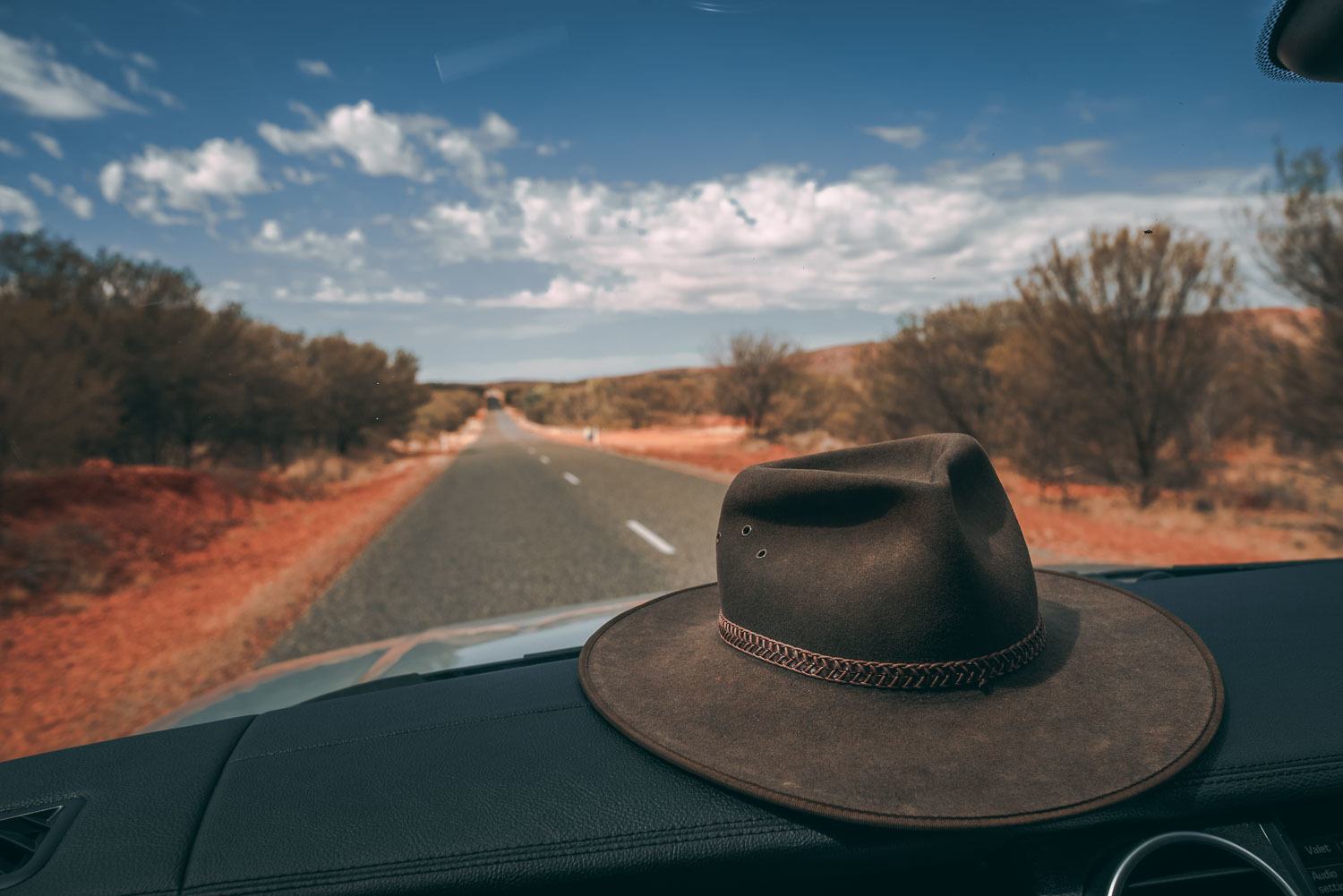
Now, on with my own NT experience…
Two-Week Northern Territory Itinerary
Days 1-2: arrive into darwin.
Welcome to the capital city of the Northern Territory – the perfect place to begin your Outback adventure. While it is the largest city biggest city in the Top End, I think it still boasts a very relaxing small-town vibe . Similar to most major destinations in Australia, Darwin has a very “liveable” atmosphere about it, which is something I’ve always loved about the country as a whole.
On this trip, I didn’t have all that much time to explore Darwin, but here are a few of the highlights which I think you MUST experience with if you have two days/nights to spend here.
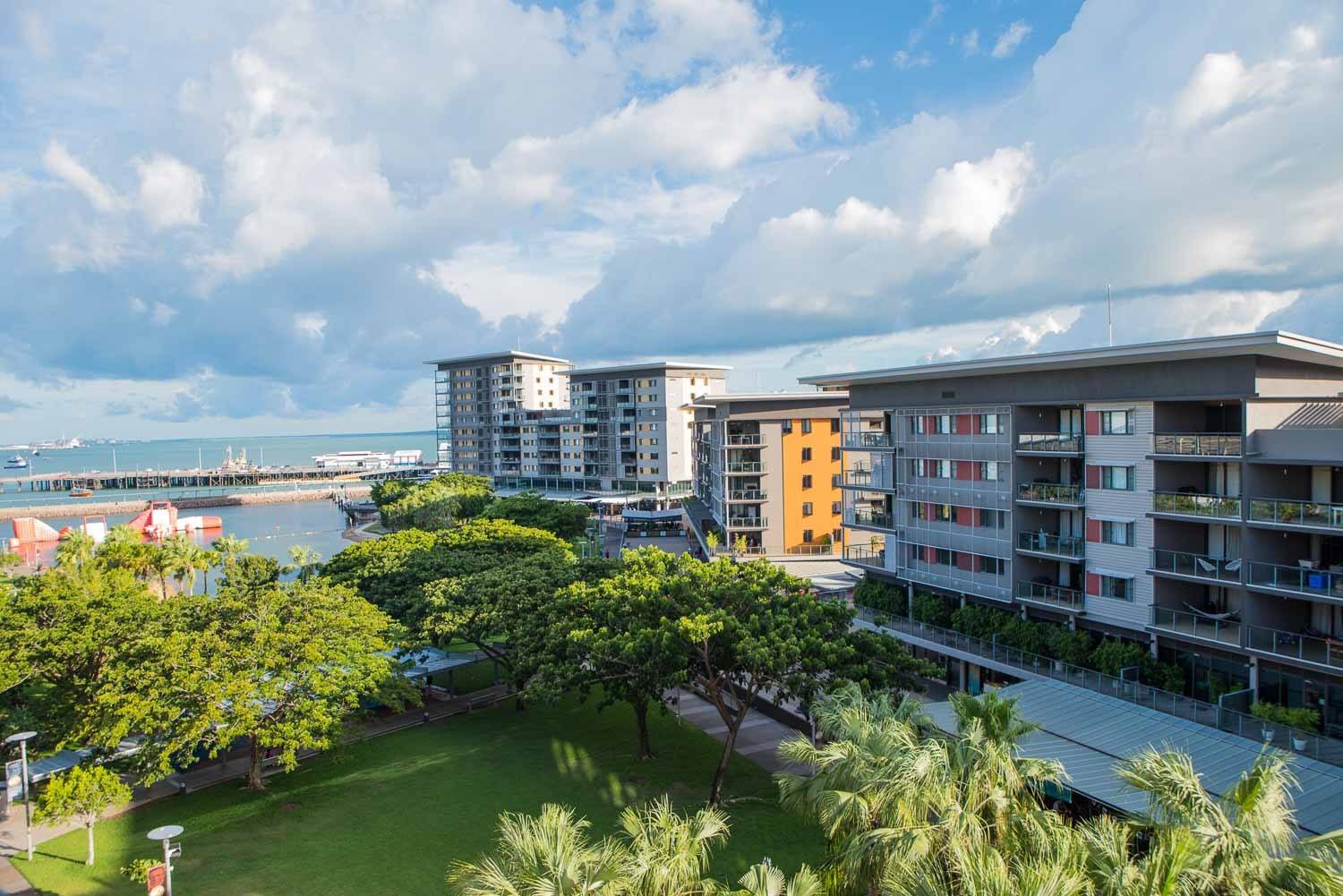
Crocosaurus Cove: Have you ever wanted to get up close and personal with crocodiles? Well, this is your chance! Even if you don’t want to enter the “ Cage of Death “, it’s still 100% worth a visit. They’ve got a really cool reptile area, a variety of marine life, and of course some massive crocodiles! You can even meet “Bert”, the famous crocodile from the Crocodile Dundee films!
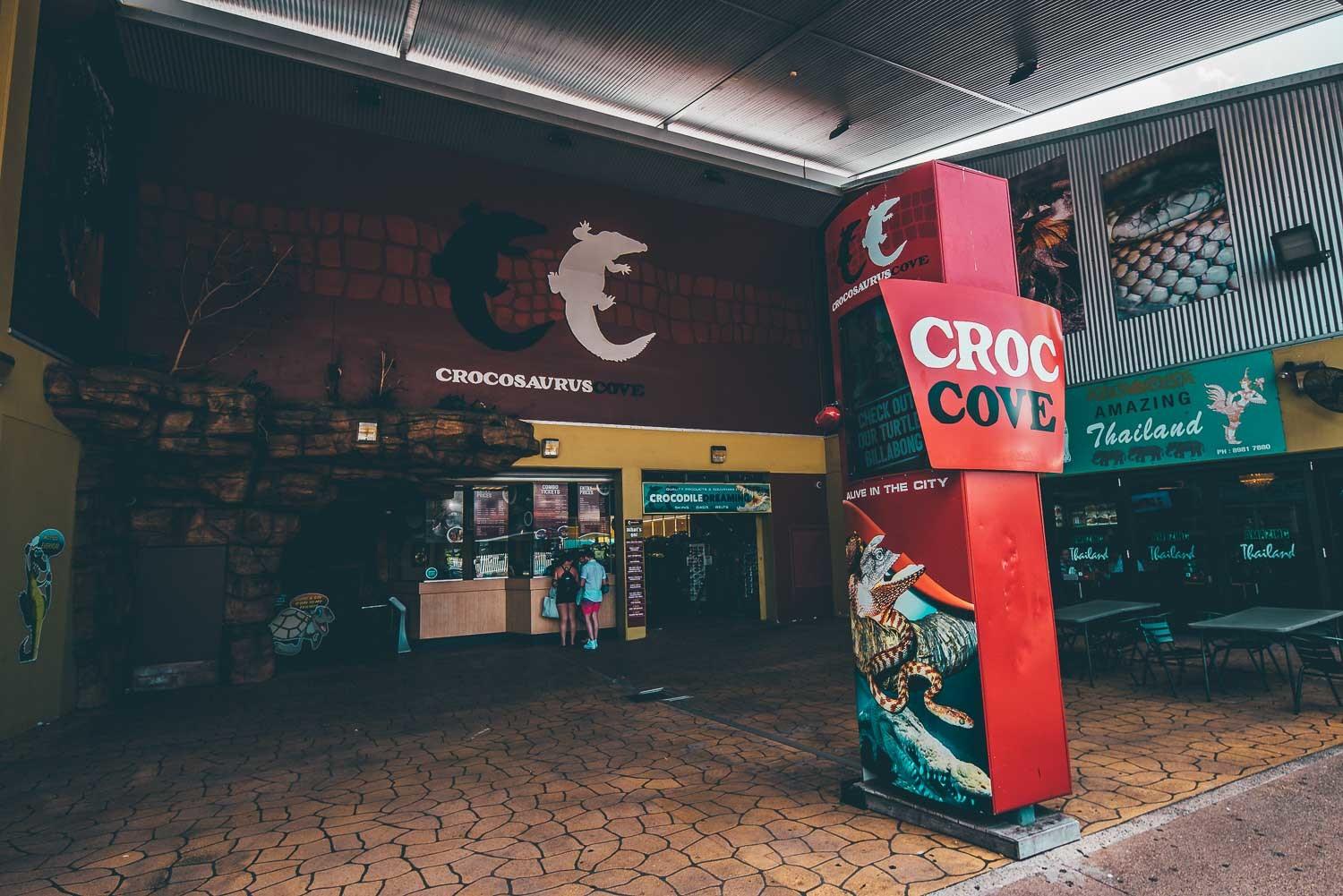
Explore the Darwin waterfront: Whether lazing on its man-made beach, taking a whirl in the wavepool, or enjoying an evening out at one of the many restaurants or bars, no visit to Darwin is complete without thoroughly exploring the waterfront area. It’s very well maintained, relaxing, and can provide the perfect escape for the tropical humidity.
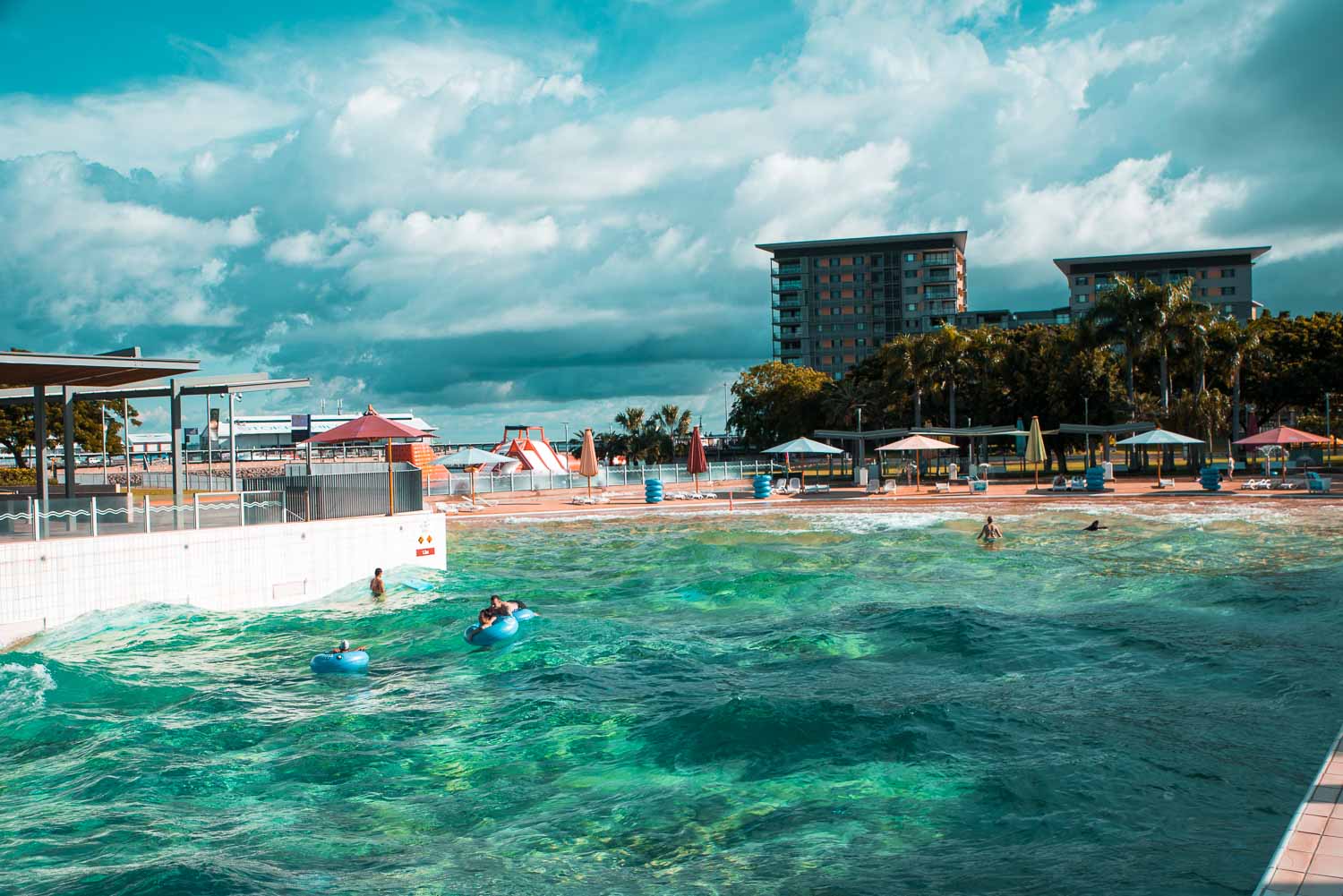
Visit fascinating museums: Did you know Darwin was heavily bombed during WW2? I had no idea before I visited, but there are some really interesting historical museums where you can learn all about it, As well as The Museum and Art Gallery of the Northern Territory .
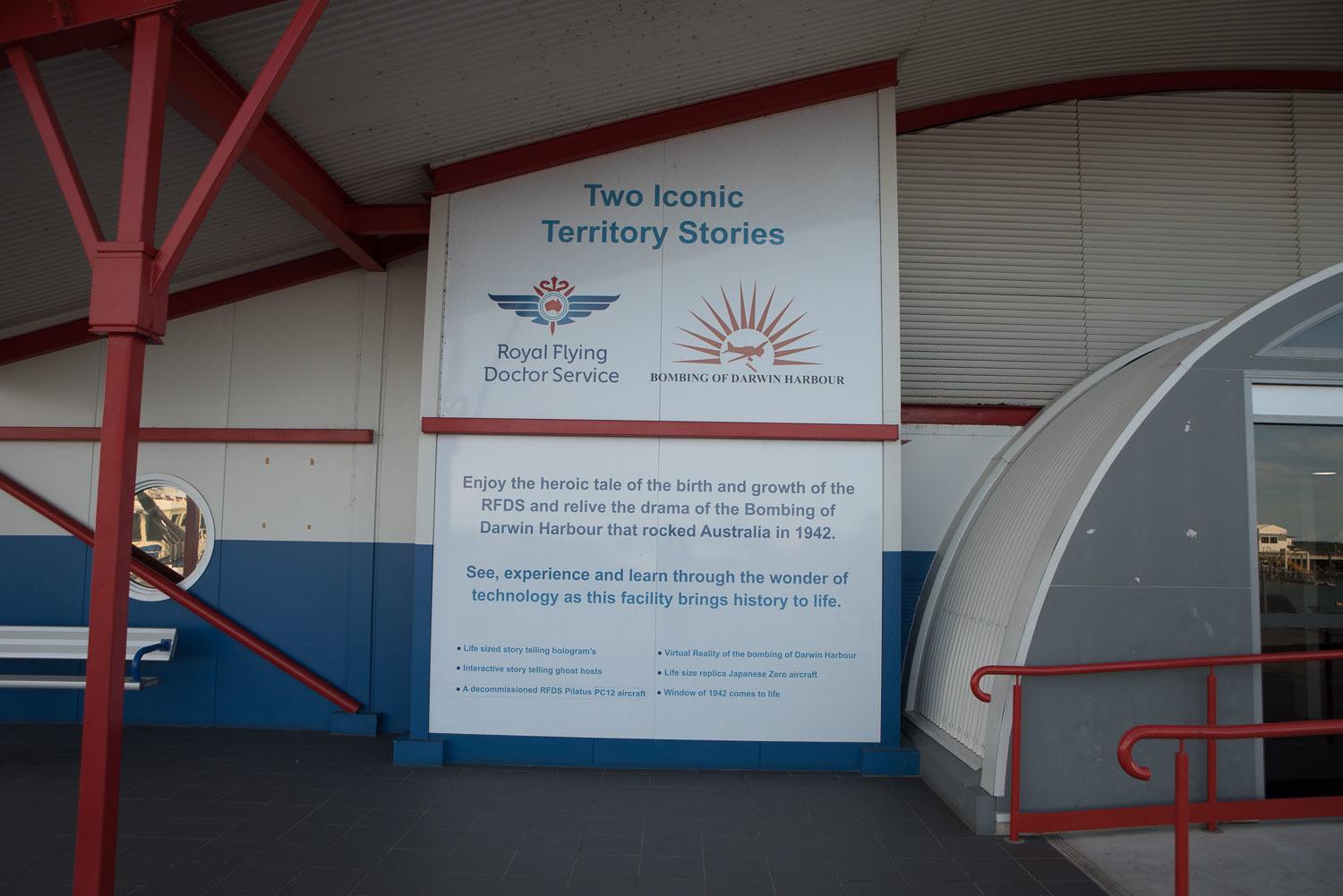
Mindil Beach Sunset Markets: Unfortunately when I visited Darwin these markets weren’t open, as they operate from the last Thursday in April until the last Thursday in October. However, I’ve heard this is a true highlight of visiting Darwin and a chance to pick up some special treasures. Definitely worth checking out if you’re in town!
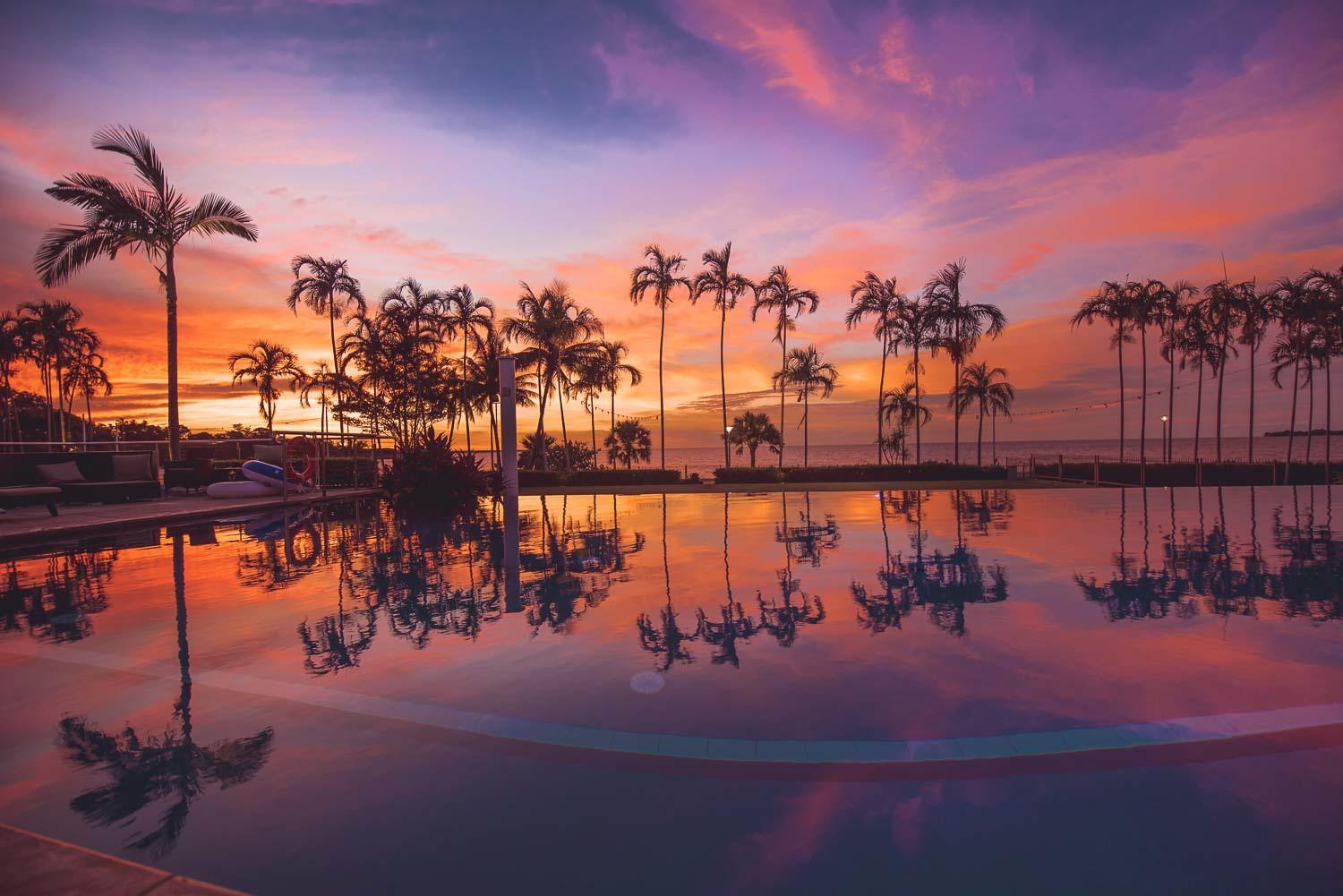
Where To Stay in Darwin…?
Skycity Darwin Casino & Hotel: This is where I was fortunate enough to stay my first night in Darwin, and I would highly recommend staying here. I was fortunate enough to have secured one of their patio suites that has direct access to the lagoon pool. It goes without saying, I thoroughly enjoyed that part in the intense Darwin heat. The entire property is gorgeous, the food was spectacular, and the rooms were unbelievably comfortable. Read Reviews & Check Availability .
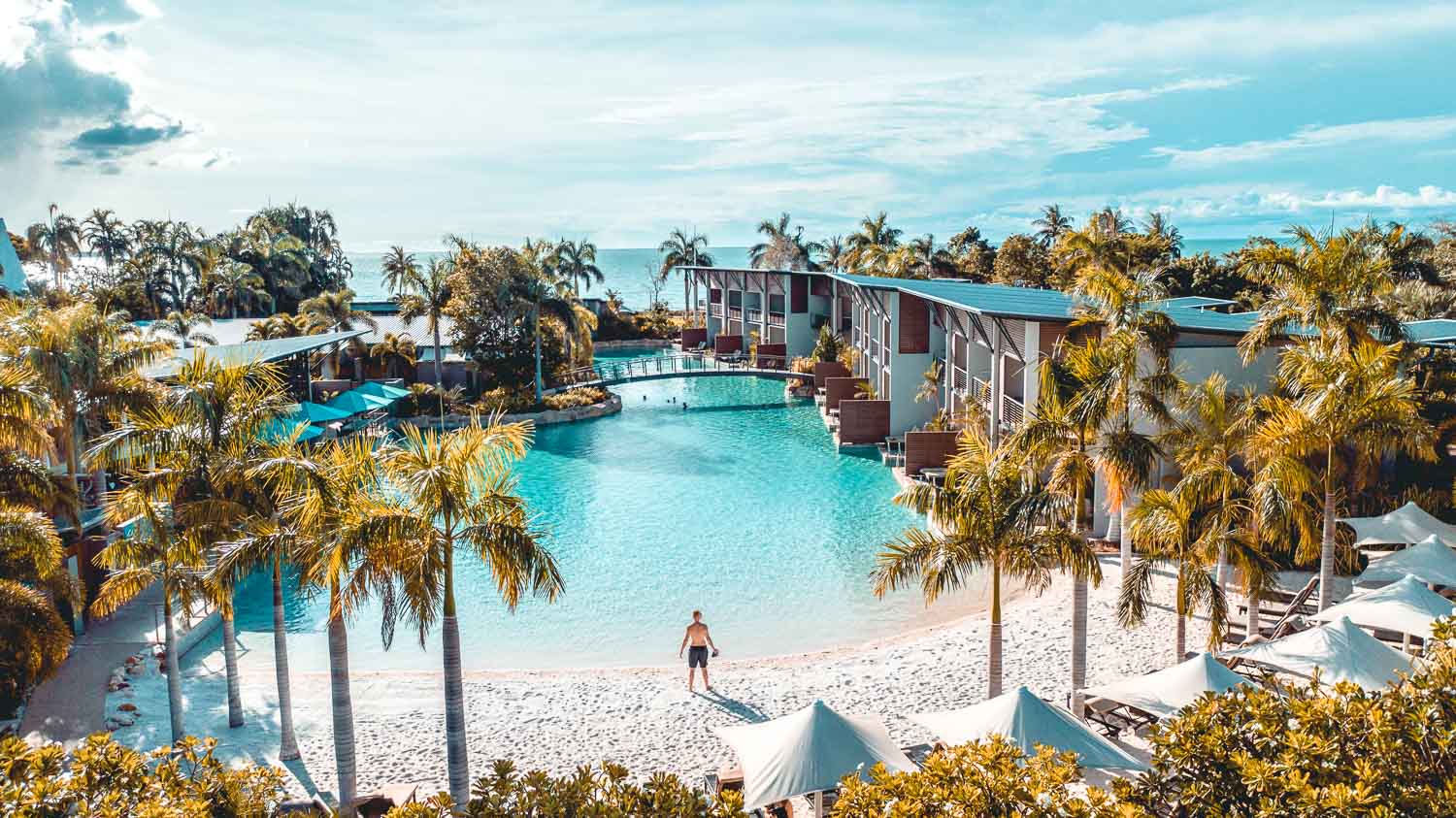
The Melaleuca – Darwin YHA Hostel – For all the budget travelers and backpackers out there, look no further than booking a couple of nights at the Melaleuca. I’ve always loved staying at YHA hostels in Australia, and their Darwin location is one of the top-rated accommodation options in the city. Rooms are affordable, the atmosphere is top-notch, and it’s perfectly located in the heart of the city!
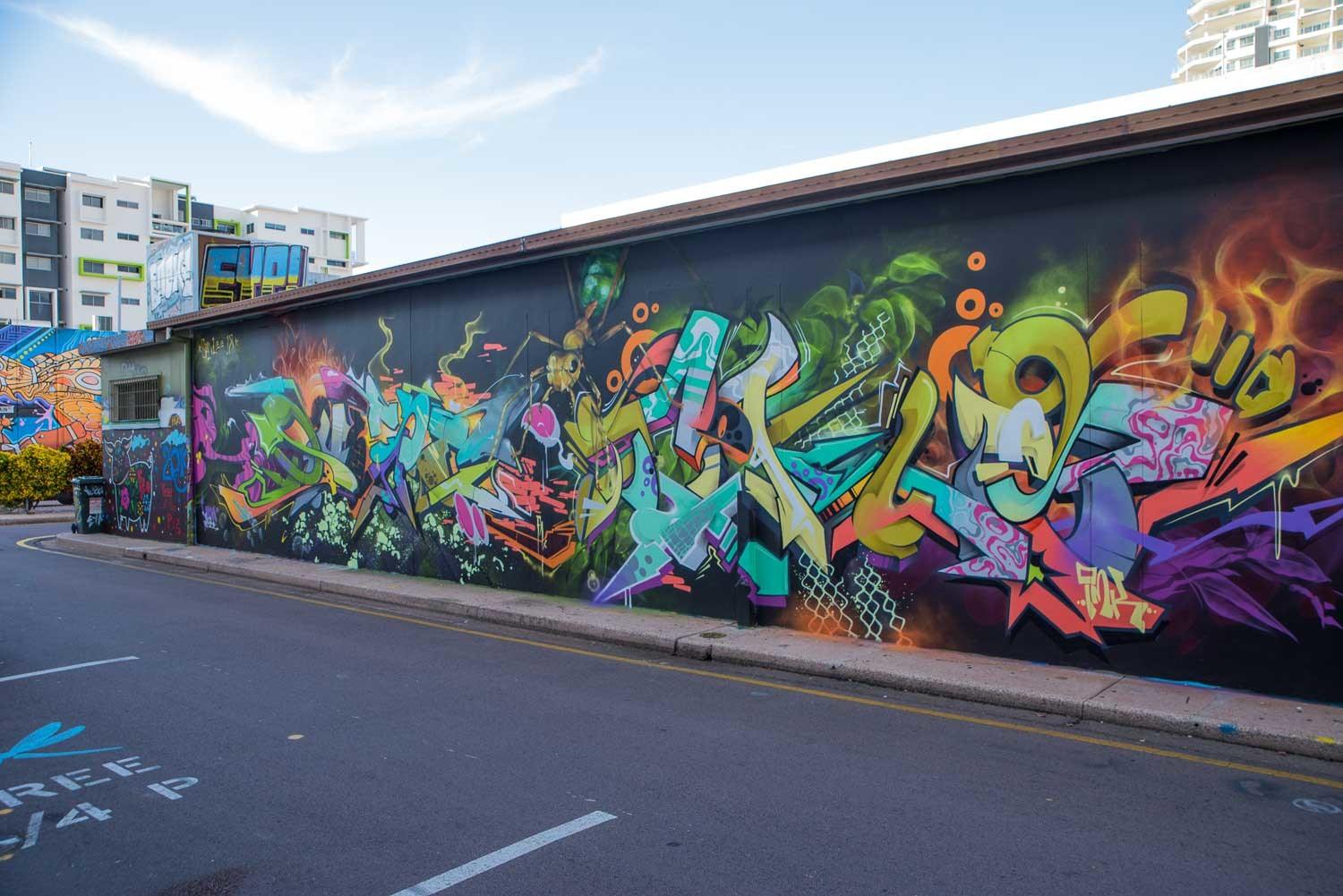
Days 3-4: Kakadu National Park
Covering nearly 20,000 square kilometers, Kakadu is the largest national park in Australia and an official UNESCO World Heritage Site. Famous for its ancient Aboriginal rock art, complex ecosystems, abundant wildlife, and colorful landscape, you could easily spend a week or two exploring Kakadu and still barely scratch the surface!
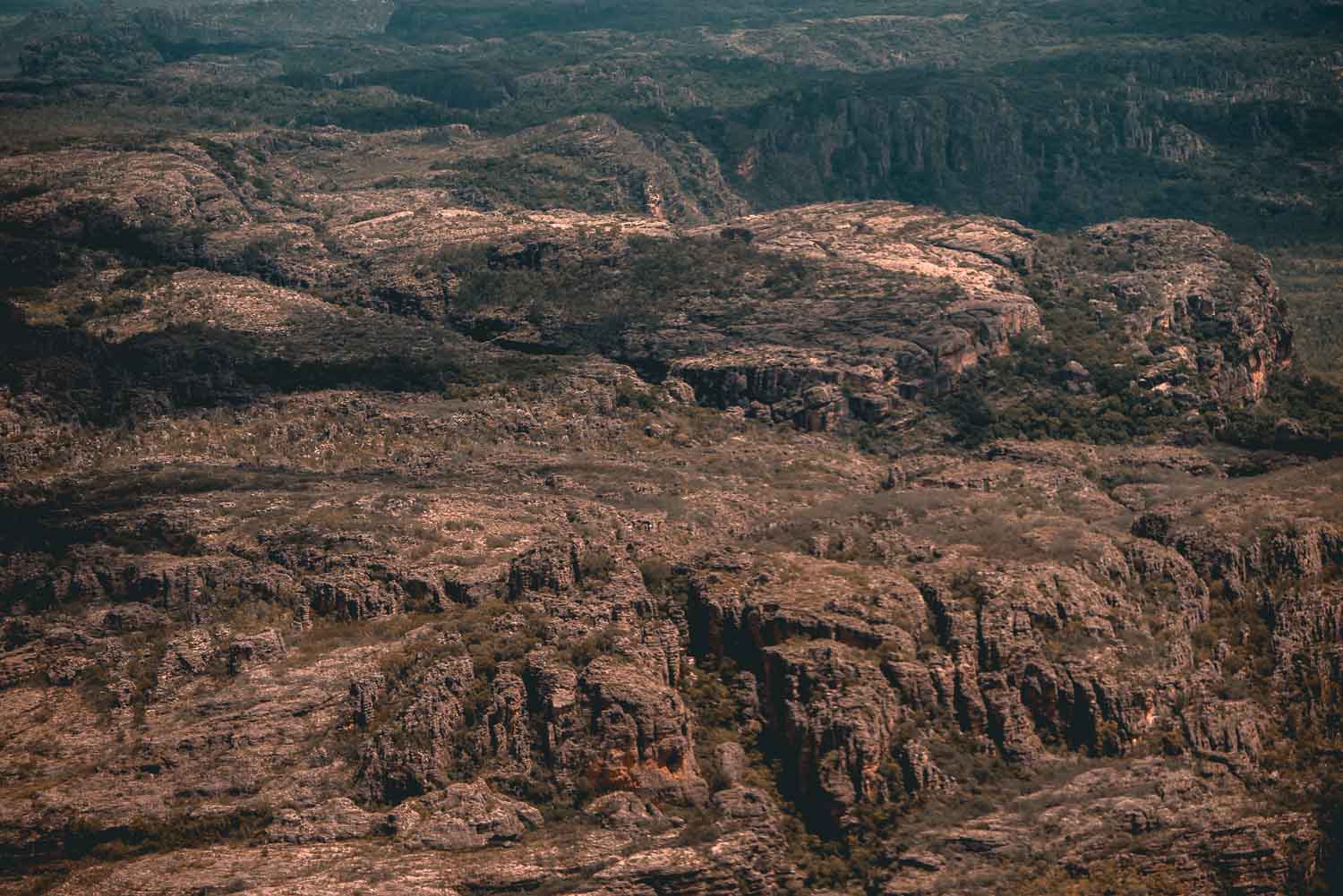
Kakadu is definitely one of the major highlights of visiting the Northern Territory, and a region that I look forward to returning to in the future, since we only got to spend one day there due to a missed flight and subsequent forced itinerary change.
“Kakadu offers many experiences: bush walking, bird watching, cruising and swimming under waterfalls to four-wheel driving, camping, scenic flights and wandering through galleries of Aboriginal art 20,000 years old.”
Check out this article on the Top 10 Things To Do in Kakadu National Park for more information. It’s important to note that self-guided visitors are required to purchase a park pass to enter Kakadu National Park. Passes cost $25.00 per adult, are valid for 7 days, and can be purchased online here .
While my time in Kakadu was limited, I loved checking out Nourlangie Rock. It’s home to some of the most famous and important Aboriginal rock paintings in the country and provides some epic views of the landscape.
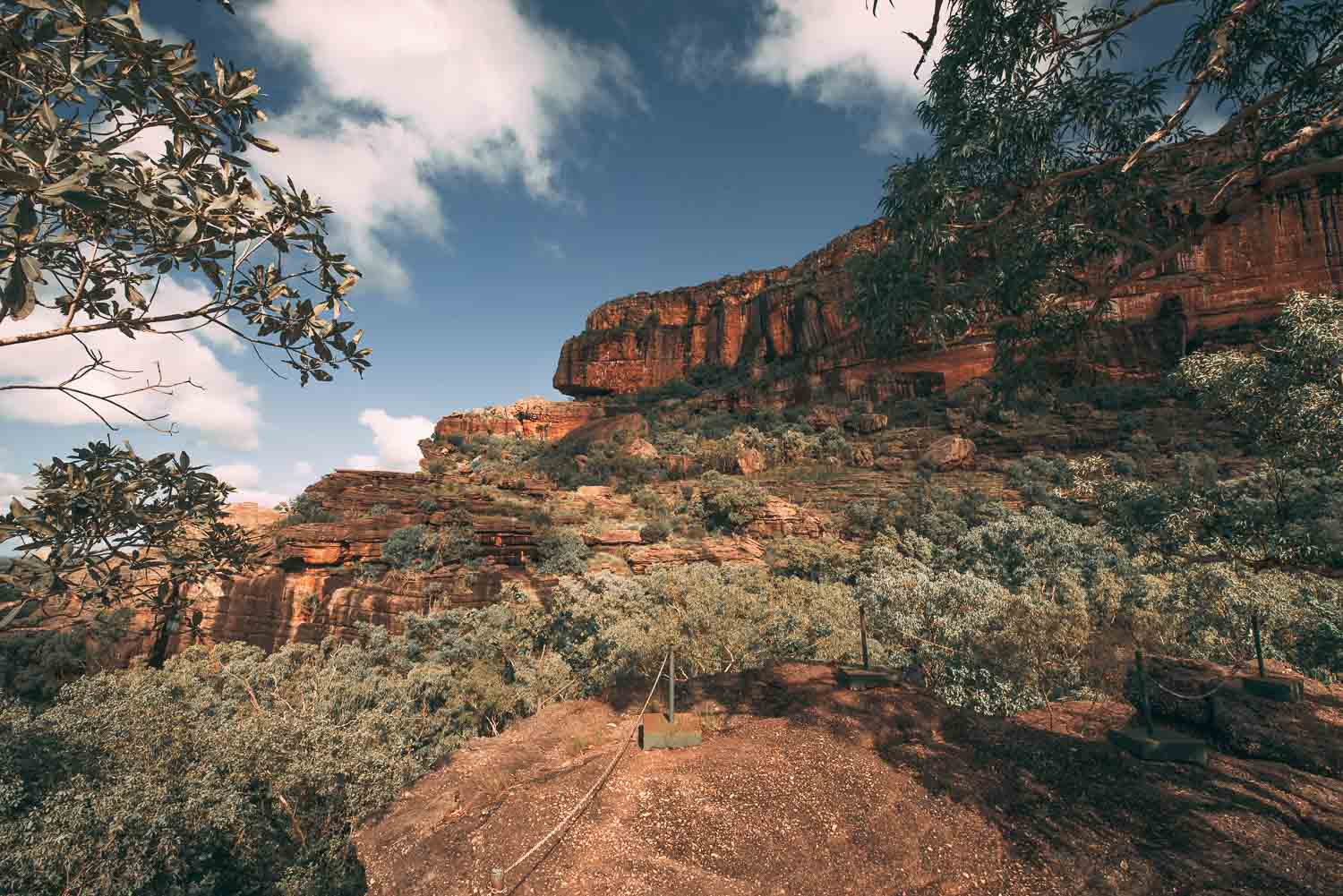
I do think that the best thing you can do in Kakadu National Park is to book a 30/60-minute scenic flight with Kakadu Air . While this activity isn’t for everyone (motion sickness and vertigo people should avoid), the aerial views of Kakadu are simply stunning. You can book a 30-minute scenic flight for only $150 AUD ($110 U.S.D), which I personally think is an amazing deal for this unforgettable experience. We ended up taking two scenic flights over Kakadu National Park (as they were charter flight transfers to Arnhem Land), and I would highly recommend it. It really gives you a bird’s eye perspective of how vast and unique this part of the world is!
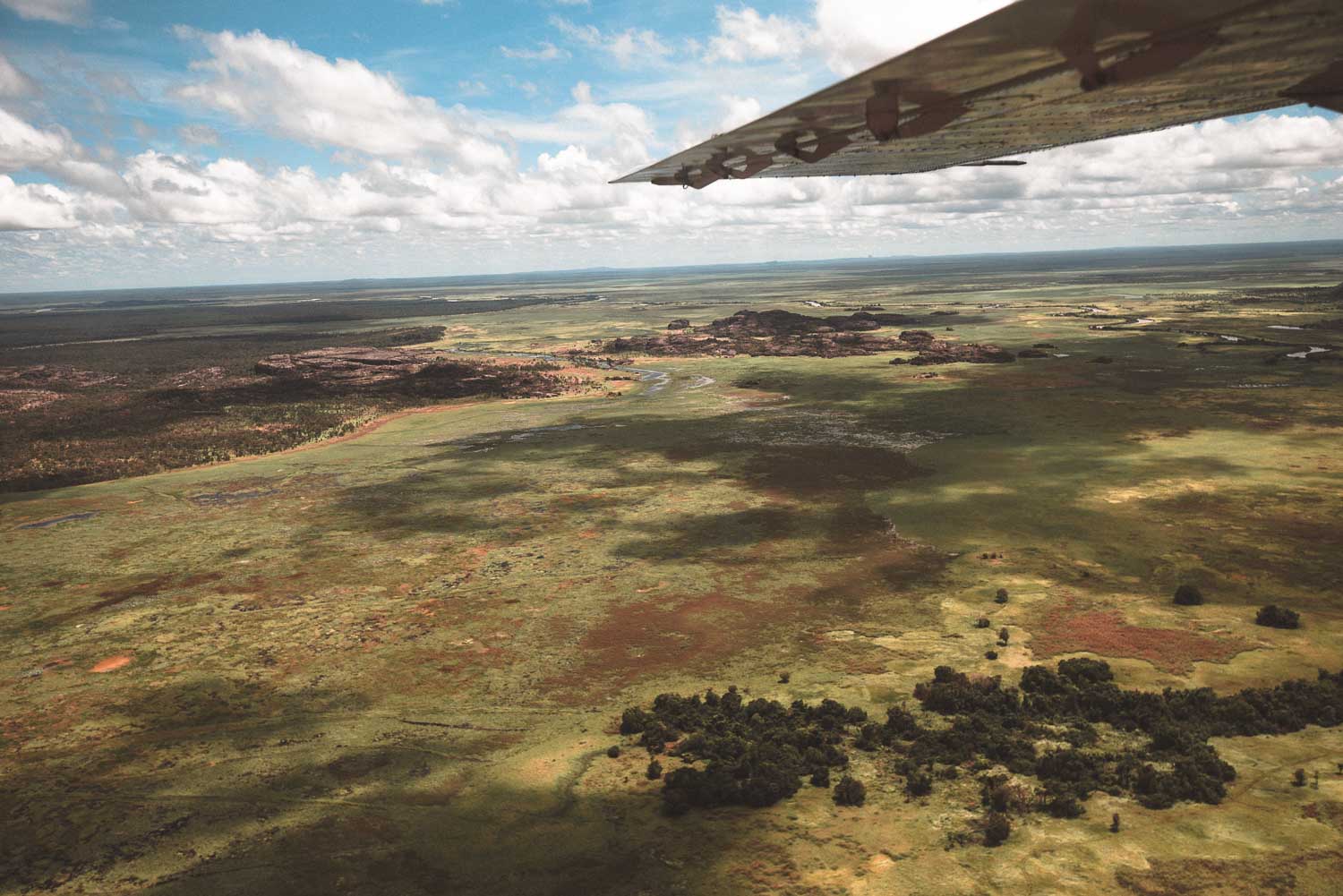
Days 5-7: Arnhem Wildlife Safari Adventure
Welcome to Australia’s Final Frontier…
Ohh, Arnhem Land — where do I even begin…?
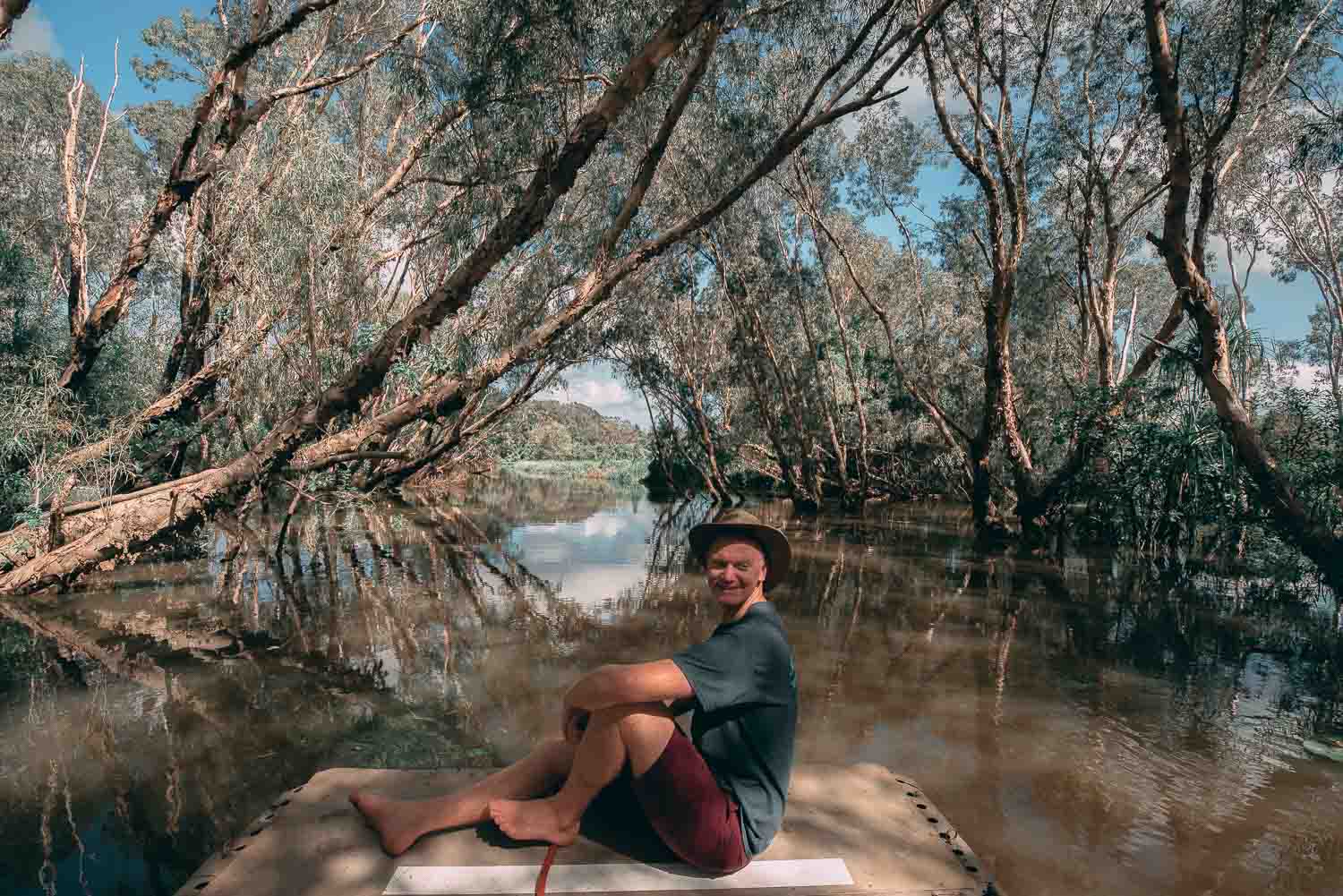
Well, I guess I should start by saying that this particular experience staying at Davidson’s Arnhemland Safari Lodge was definitely my favorite aspect of the entire trip in the Northern Territory – and that’s really saying something!
After all my time spent living and traveling around Australia a few years back, I had somehow never heard of this remote Outback region. I had no idea what to expect, but it really did leave a strong impression on me.
Everything from the scenic private charter flights we took to get there, 4WD Jeep adventures, mangrove boat rides, cozy glamping huts, delicious food, passionate tour guides, and starry night skies all made this experience truly unforgettable.
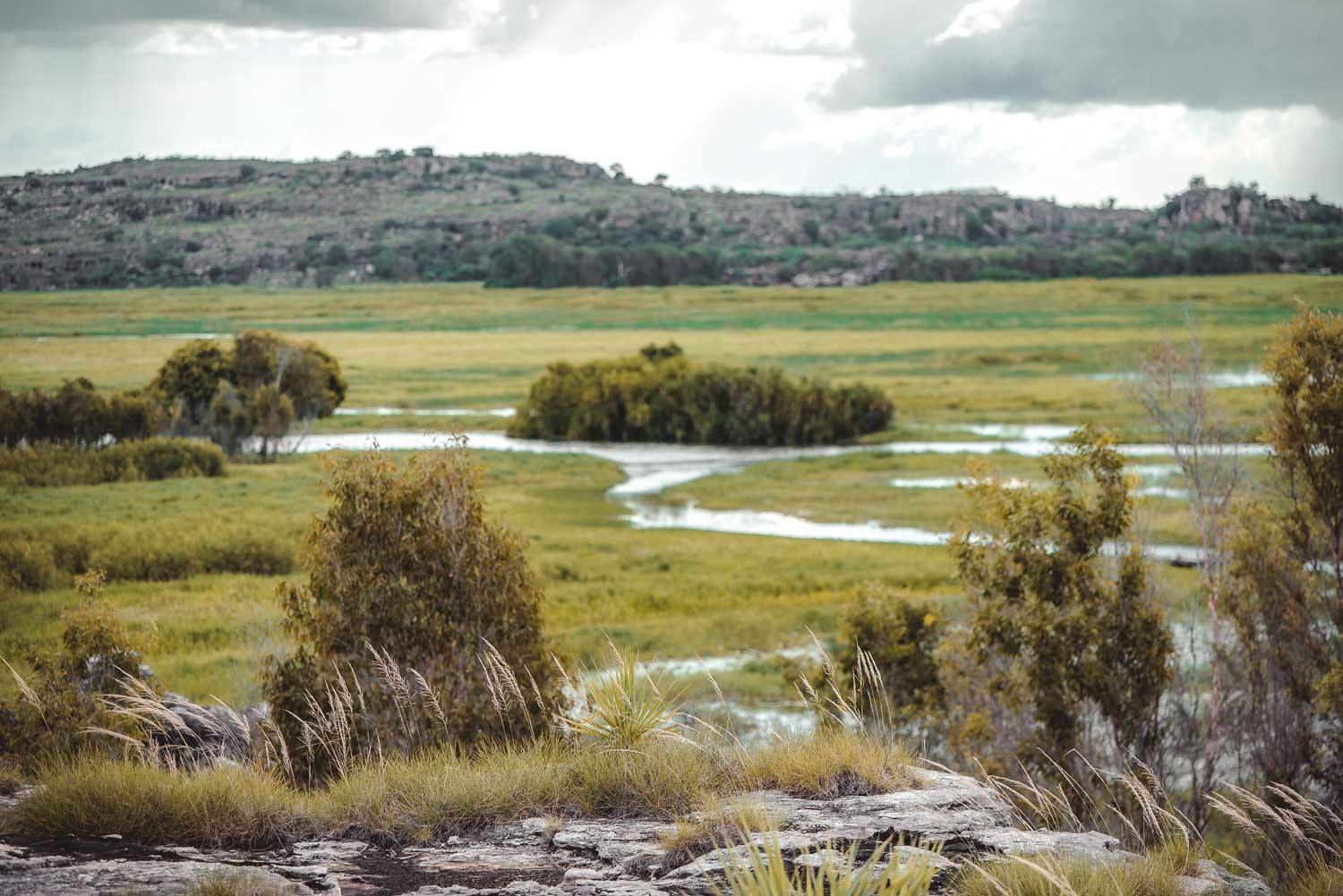
There’s a whole lot more I could say about this experience, but I’ll let my photos do the talking for me. While it certainly is an expensive adventure, it’s worth every damn penny. Trust me.
I really think that no trip to the Northern Territory is complete without booking a wildlife safari through Arnhem Land, but I understand that might be difficult for some, as it’s quite an expensive activity and not necessarily doable for those traveling on a shoestring. A round-trip airfare costs $500 AUD per person (leaving from Jabiru Airport), and the safari costs $900 per person/per night for this all-inclusive experience. Save up your hard-earned cash for this one!
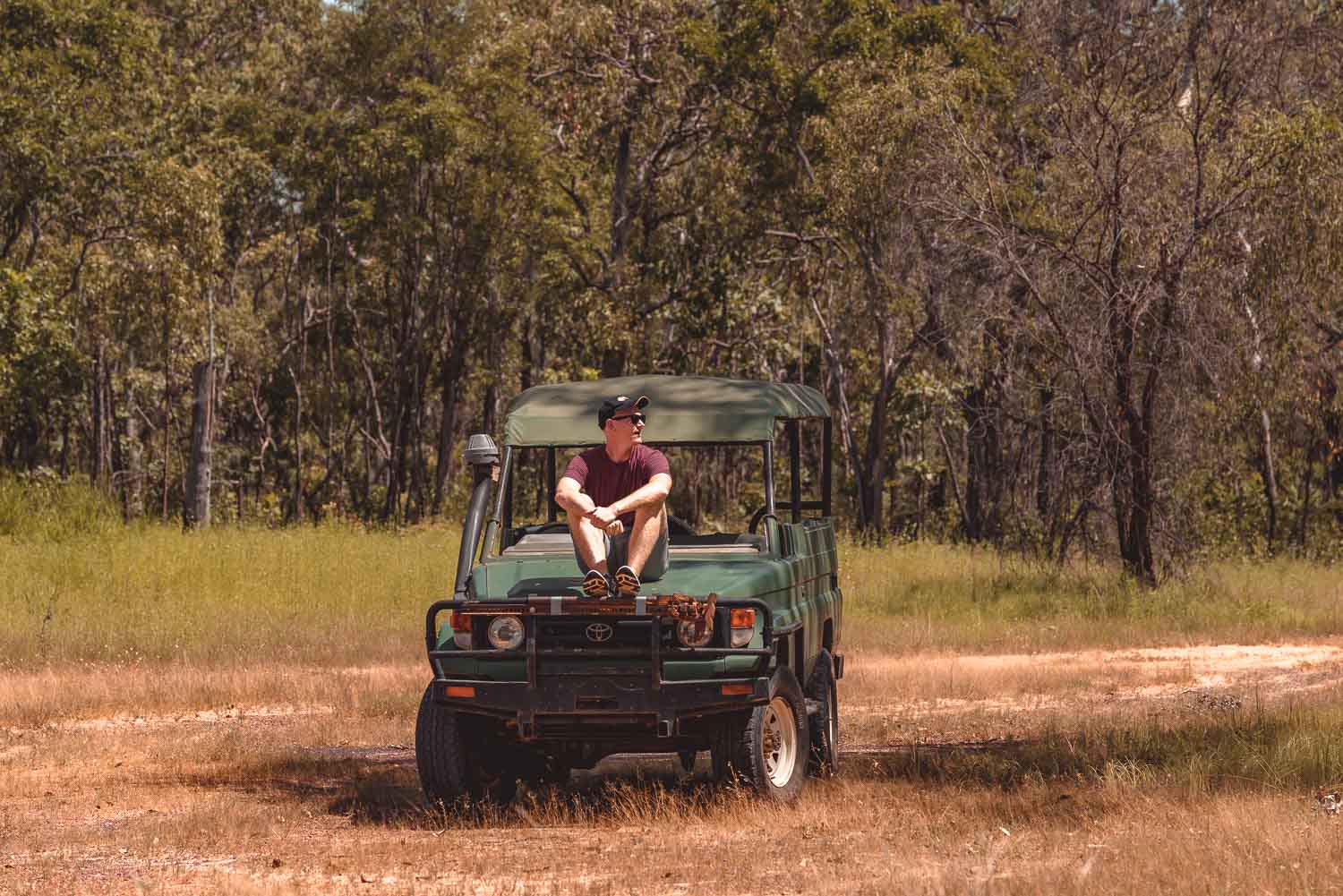
Days 8-9: Katherine Gorge & Hot Springs
After arriving back from Arnhem Land, it’s time to make the long yet scenic drive down to the small town of Katherine. There’s pretty much only one reason to visit this tiny Outback town though, and that’s simply to marvel at the majestic Katherine Gorge, which is well worth the drive!
Before soaking up those gorgeous views though , make a quick stop at the Katherine Hot Springs for a refreshing morning swim. This place is as relaxing as it is beautiful, and the water could not feel any more perfect, especially amidst the harsh NT heat.
Important Note – The hot springs are typically open March/April through the end of the dry season (October/November)! Make sure you do your research beforehand to make sure you can go visit them during your trip!
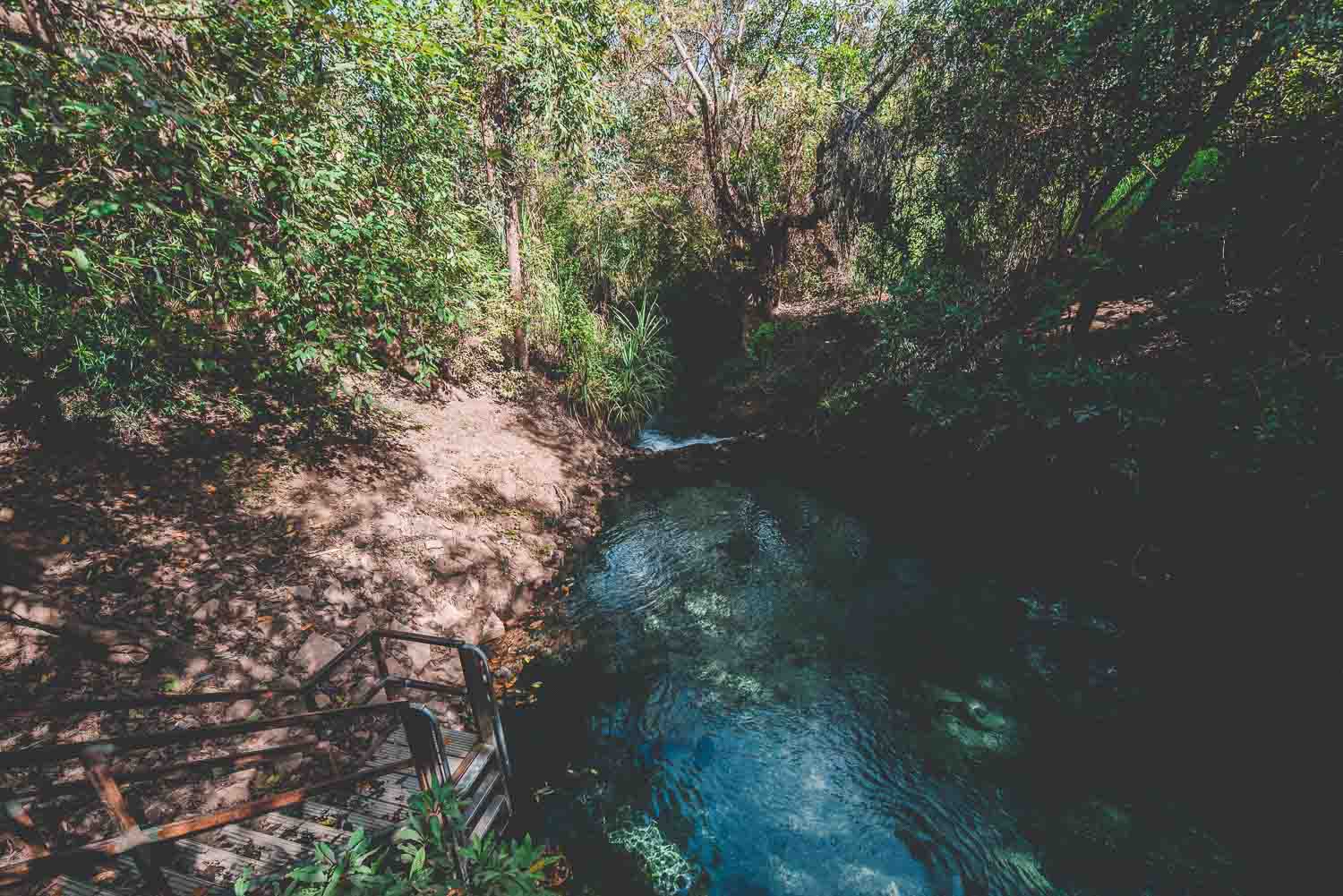
Katherine Gorge Lookout
Now that you’re feeling all relaxed after a hot springs session, it’s time to put your muscles to work and hike to the peak of this stunning lookout overlooking a section of the Katherine Gorge. The trail is a bit steep, and you’ll be sweating up a storm in the humidity, but it’s definitely a spectacular view and worthy of some envy-inducing snapshots to show the folks back home. Just be sure to wear your best walking or hiking shoes.
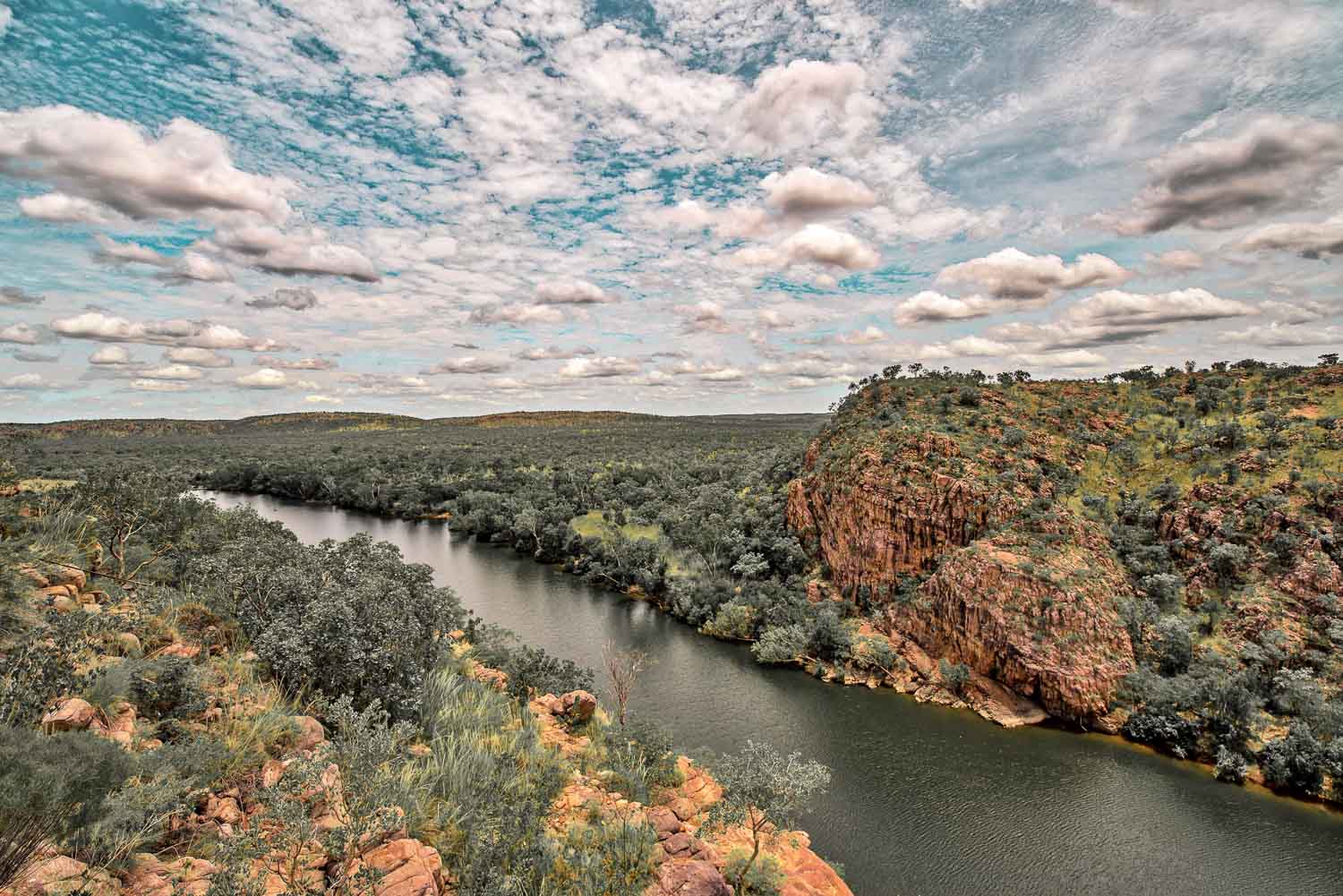
Katherine Gorge River Cruise
Located in the Nitmiluk National Park, the Katherine Gorge is actually a network of 13 separate gorges carved out by the Katherine River. It has a deep significance for the local Jawoyn people , which you’ll learn all about during your 2-3 hour cultural cruise.
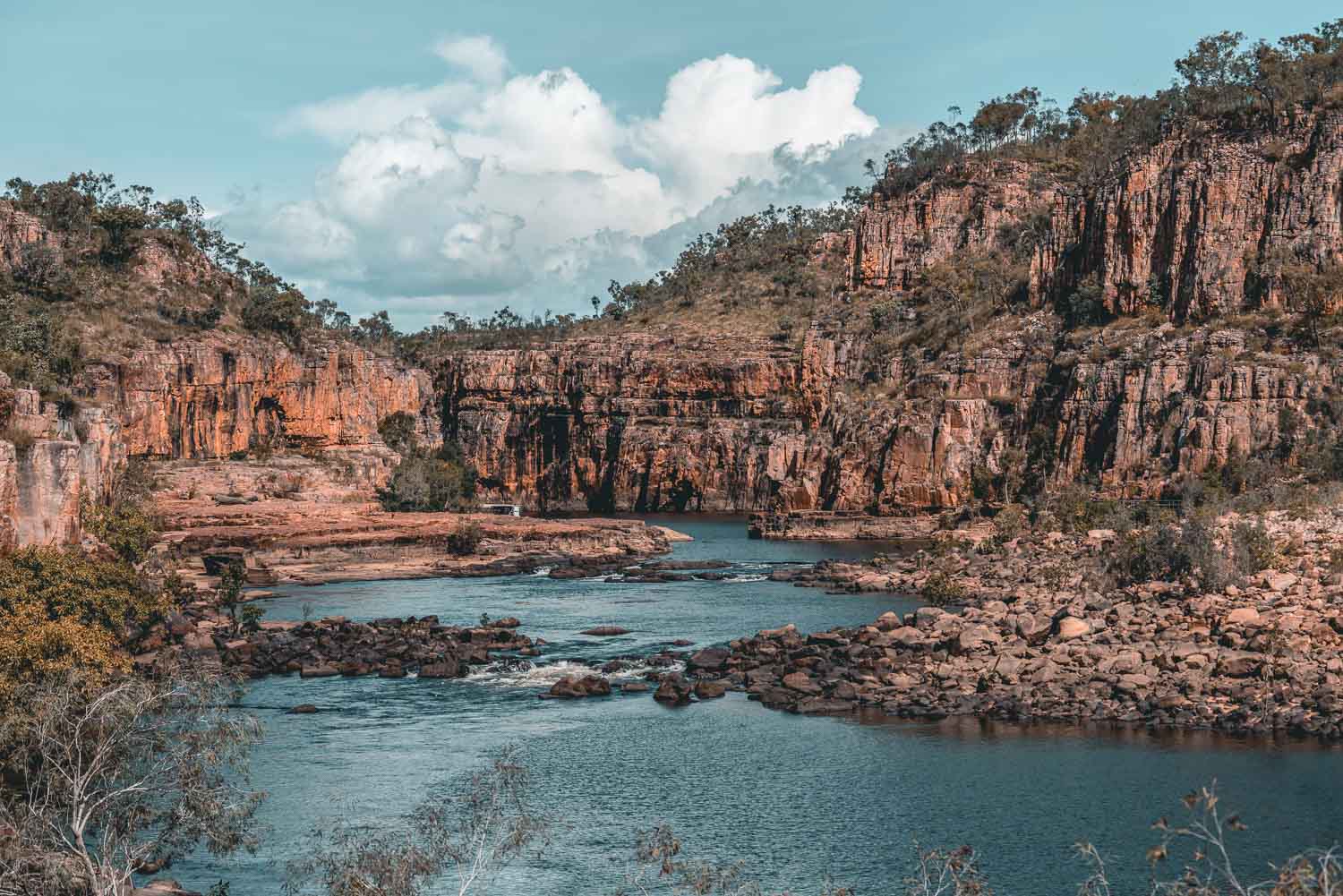
All I have to say is… WOW! This place is indescribable, and I definitely wasn’t ready for my time here to end. As our boat slowly cruised up and down the river, I was in a complete state of awe gazing up at the towering gorge walls surrounding us. It’s hard to explain, but Katherine Gorge is one of those places where pictures just won’t do it justice. Having seen it for myself, I now consider it to be one of Australia’s must-see natural landscape sites.
Since we traveled during the off-peak season, we only had access to two of the gorges, but I guess that just gives me a decent excuse to return in the future and experience this breathtaking location all over again. I’d love to witness Katherine Gorge during the peak of the wet season, where the walls are awash with natural waterfalls.
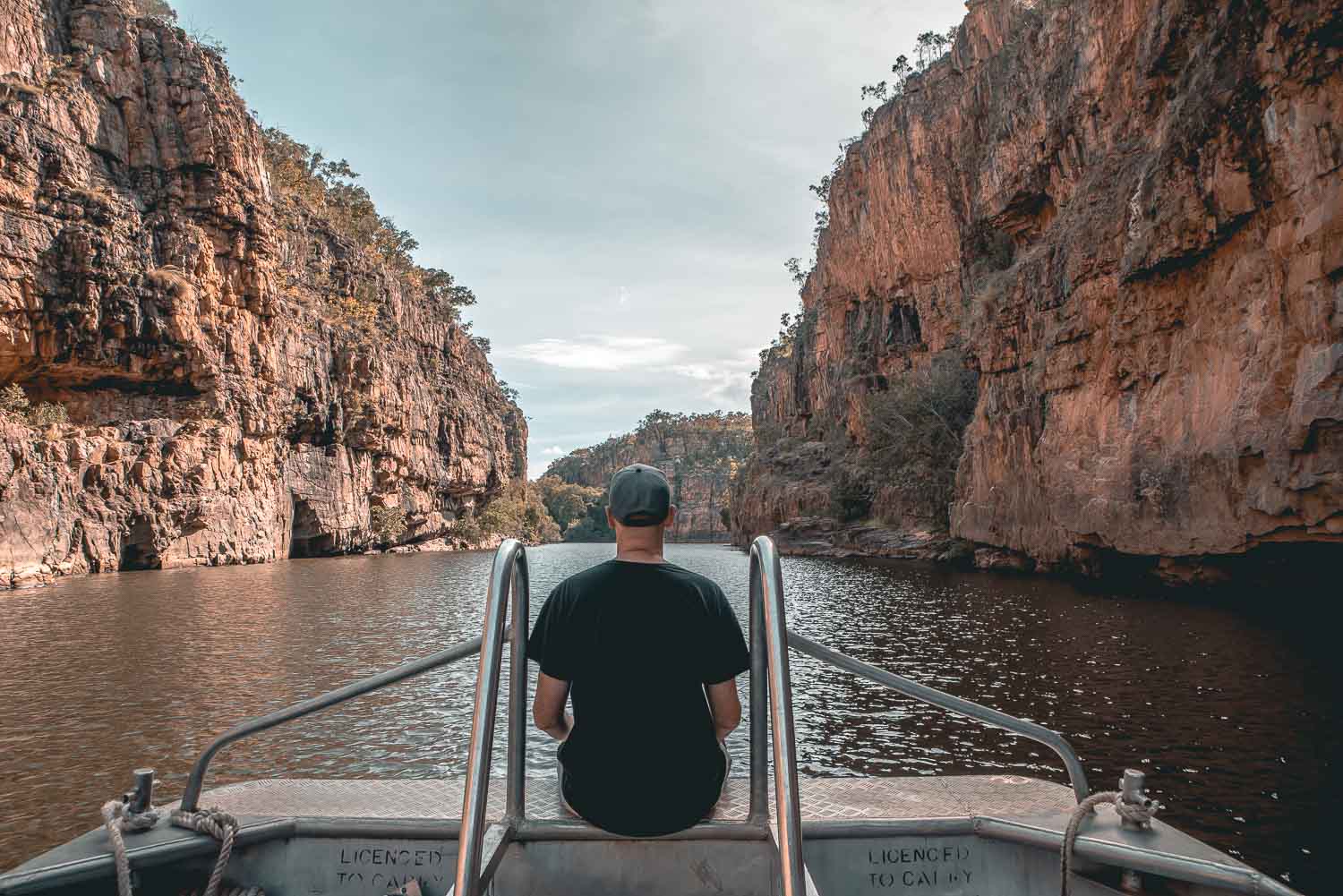
Where to Stay in Katherine
Knotts River Crossing : This is where we stayed for our two-night stay, and it’ll provide everything you need for a comfortable stay. While it may not be the fanciest or luxurious, it’s budget-friendly and has an awesome pool that will certainly come in handy. Also, the food (*cough* dessert) at the hotel restaurant is spectacular!
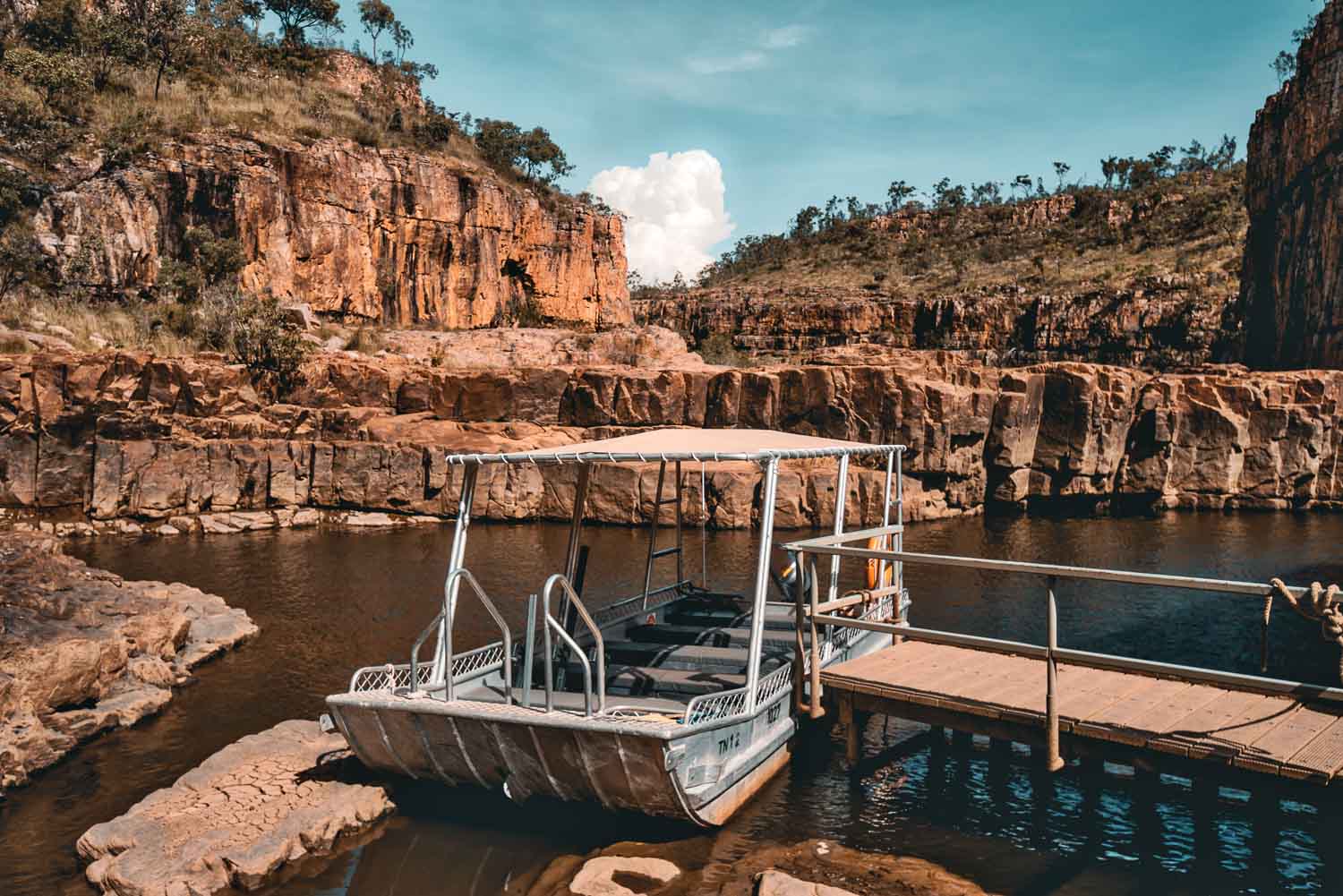
Day 10: Edith Falls & Drive Back to Darwin
The next (and final) location I’d visit on this Northern Territory itinerary was Alice Springs, but that was a 14-hour drive from where I was, so instead, I headed back to Darwin and booked a flight instead.
On the journey back to Darwin, there’s a popular spot called Edith Falls, and it’s the perfect place to spend a day of hiking, exploring, and lots of swimming. It is super picturesque, and the water provides a much needed escape from the humidity of the Top End.
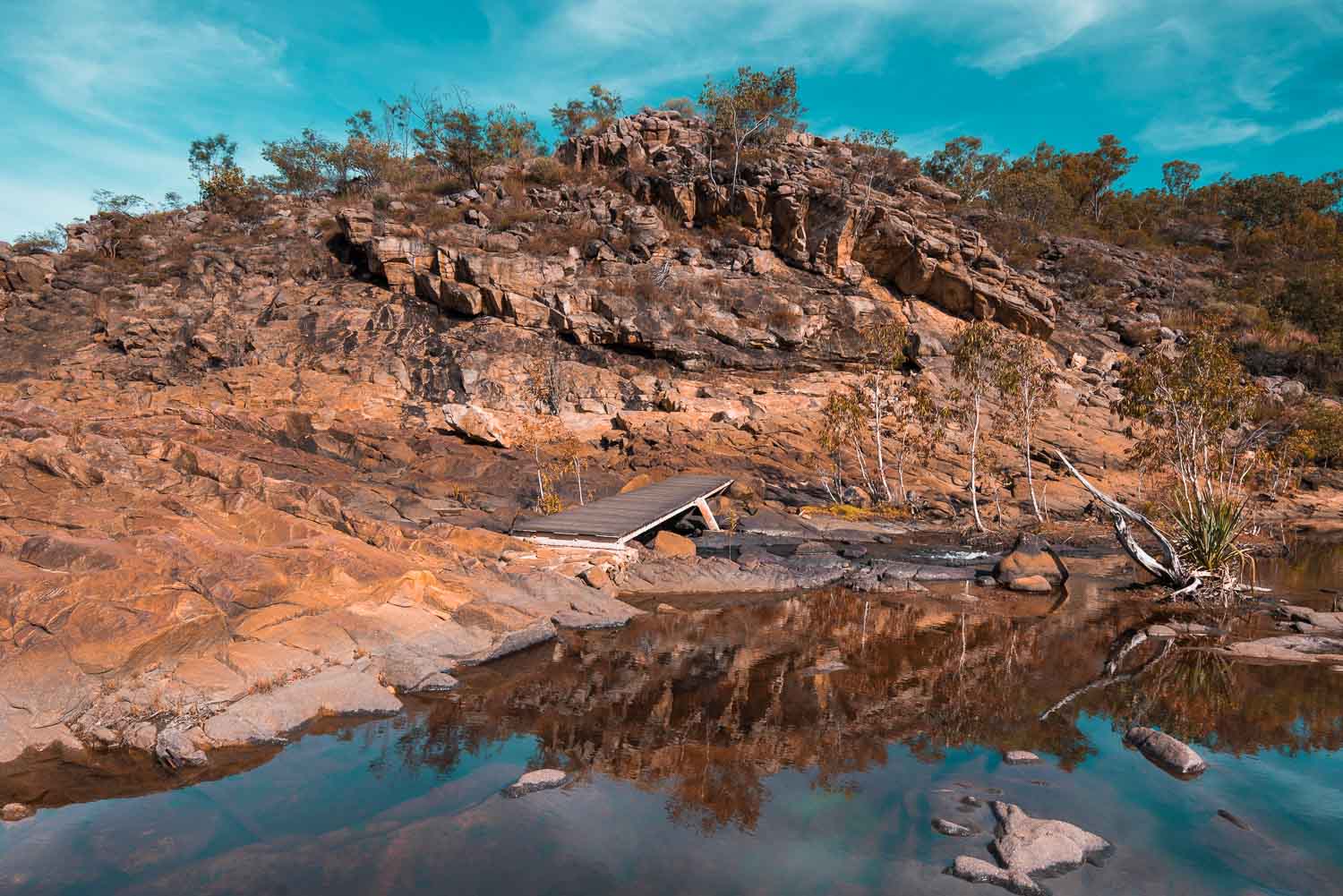
“The area is great for bushwalking with the 2.6 kilometre Leliyn Trail offering a challenging walk along a steep, rocky loop. There is a chance for a refreshing swim in the upper pool of Leliyn / Edith Falls halfway around the trail. You can also enjoy the longer 9 kilometre return walk to Sweetwater Pool, a tranquil swimming hole. Leliyn / Edith Falls is the finishing point of the 62 kilometre Jatbula Trail walking track, which begins at Nitmiluk National Park (Katherine Gorge).” – Northern Territory Tourism
Our group was a bit short on time, so we only spent an hour around the Falls, but you could honestly spend all day there if you have the opportunity. If you get up early enough, you could also hit up Litchfield National Park on the way back to Darwin – another amazing spot in the Northern Territory. I sadly didn’t get the chance to visit during my two week trip, but it looks unmissable.
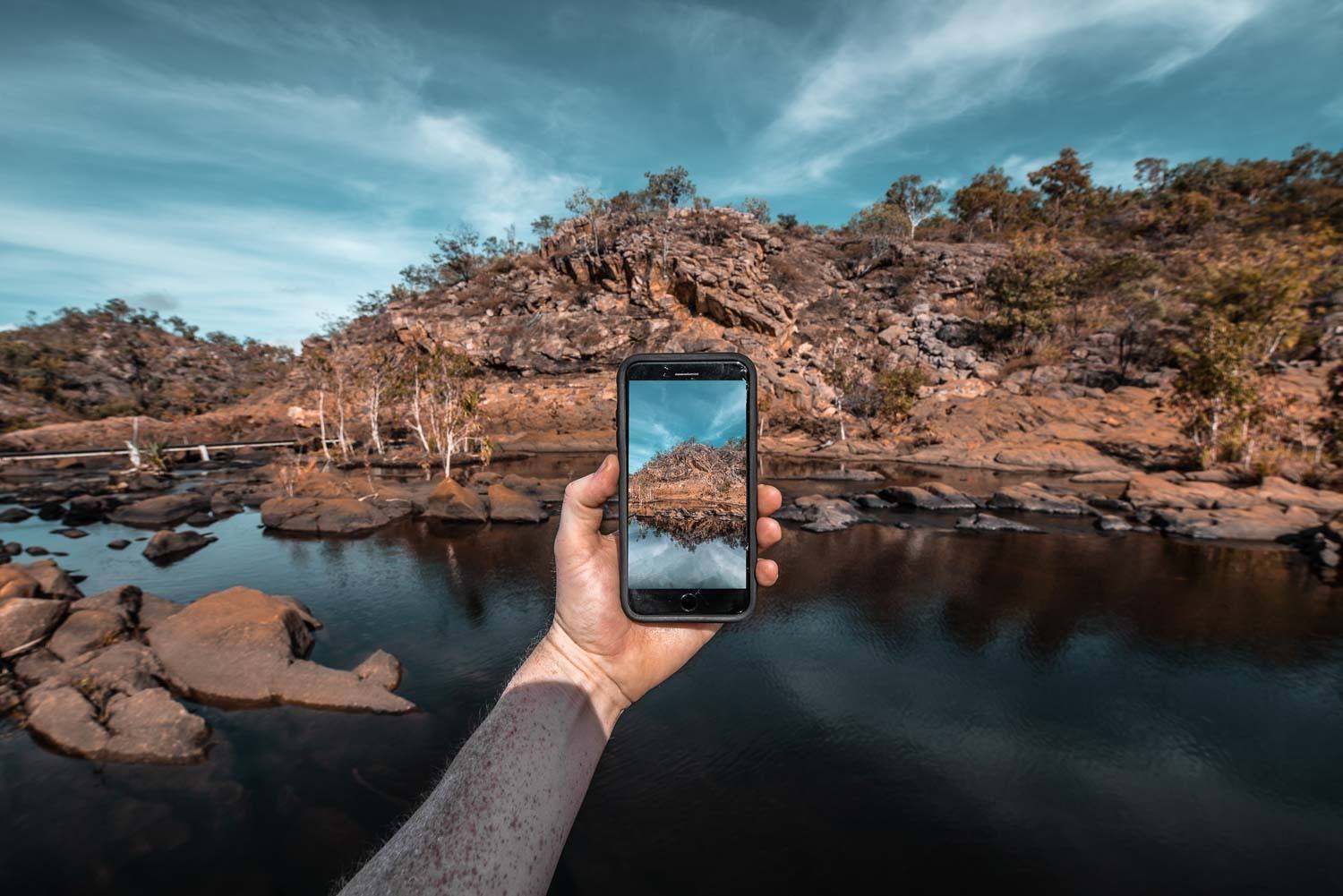
Days 11-14: Alice Springs
After a relatively quick, scenic flight from Darwin to Alice Springs (seriously, snag yourself a window seat for this one), we arrived in the heart of the ‘Red Centre’ of Australia, and the final destination on my Northern Territory Outback itinerary.
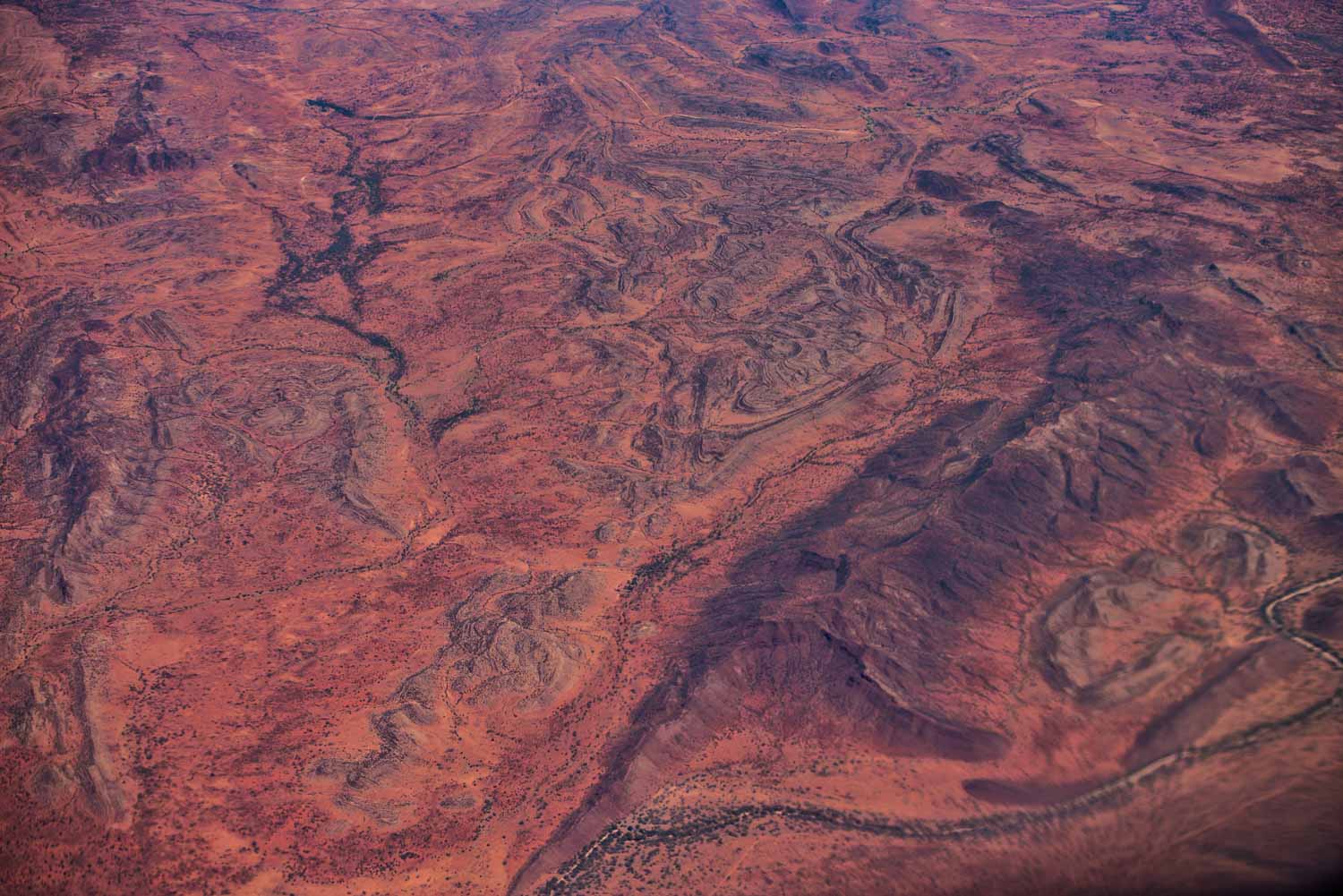
Window Seat Views flying over the Red Center
Located almost exactly in the middle of the Australia, Alice Springs is one of the most unique places in this huge country. Famous for its rugged natural beauty, fascinating Aboriginal history and its many outdoor adventure activities, a visit to this iconic Outback town should be on everyone’s Australian bucket list!
While it may be hot out there in the desert, and the flies can drive you close to sheer insanity, the experiences you can have here are worth every bit of it.
Here are just a few of my Alice Springs highlights…
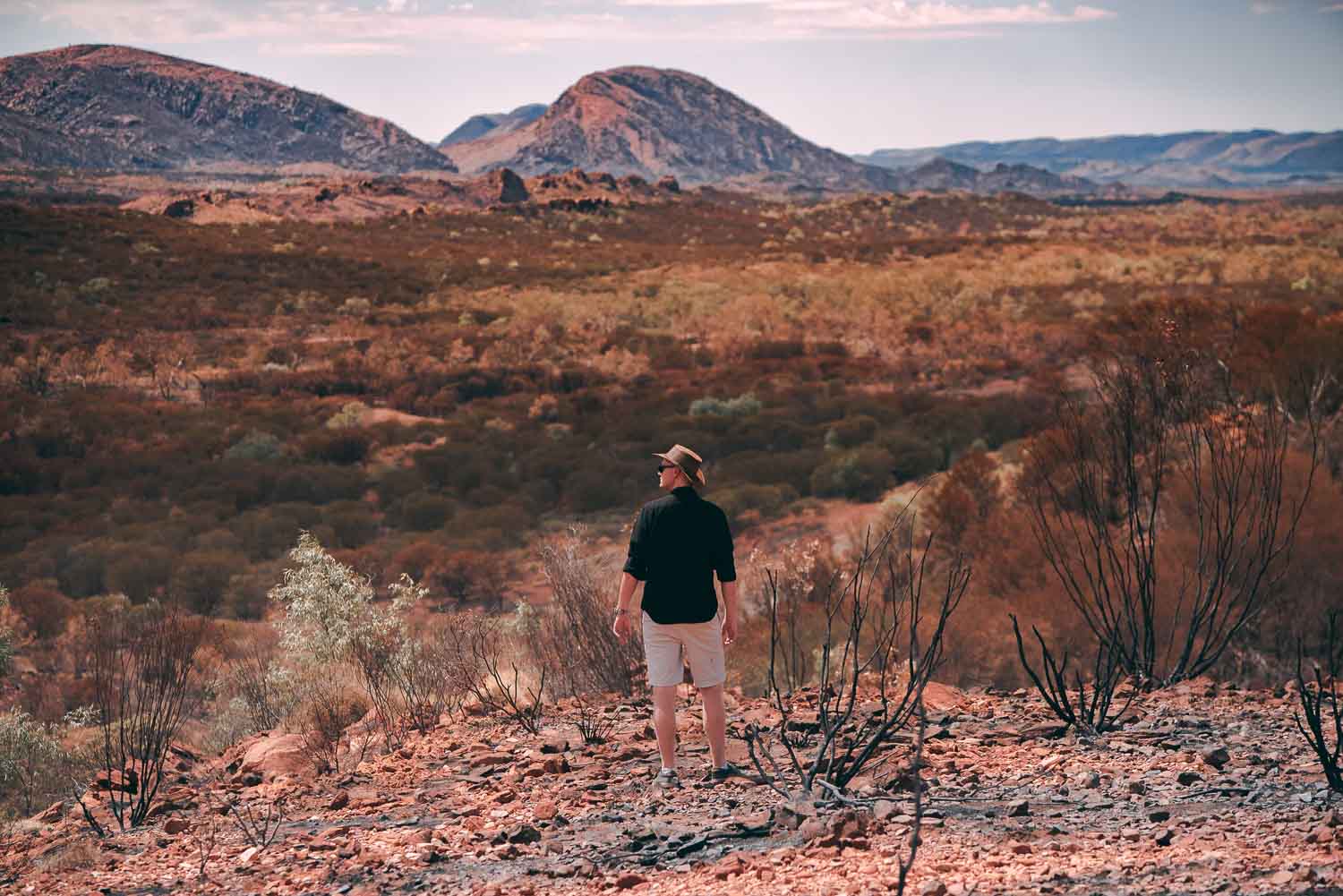
The Kangaroo Sanctuary Sunset Experience
I’ve always had a fascination with kangaroos, so visiting this sanctuary in Alice Springs was one of the most incredible experiences I’ve had in the country! We learned lots of fun facts about the animals, got to hold a couple cute and cuddly Joeys, and marveled at these adorable creatures bounce around in the beautiful golden light in the Outback.
It’s basically a 188-acre wildlife sanctuary for rescued orphaned baby and adult kangaroos. What most people don’t know, is that kangaroos are one of the most common roadkill animals in the country, and there can be alive baby joeys in their mother’s pouch when their on the side of the road.
What this place does, under the leadership of the famous “Brolga” A.K.A the “mother of kangaroos”, is rescue these cute animals, and prepare them for life in the wild. The sunset kangaroo feeding experience was one-of-a-kind, and is worth every penny!
For more information, head over to The Kangaroo Sanctuary website for times and availability!
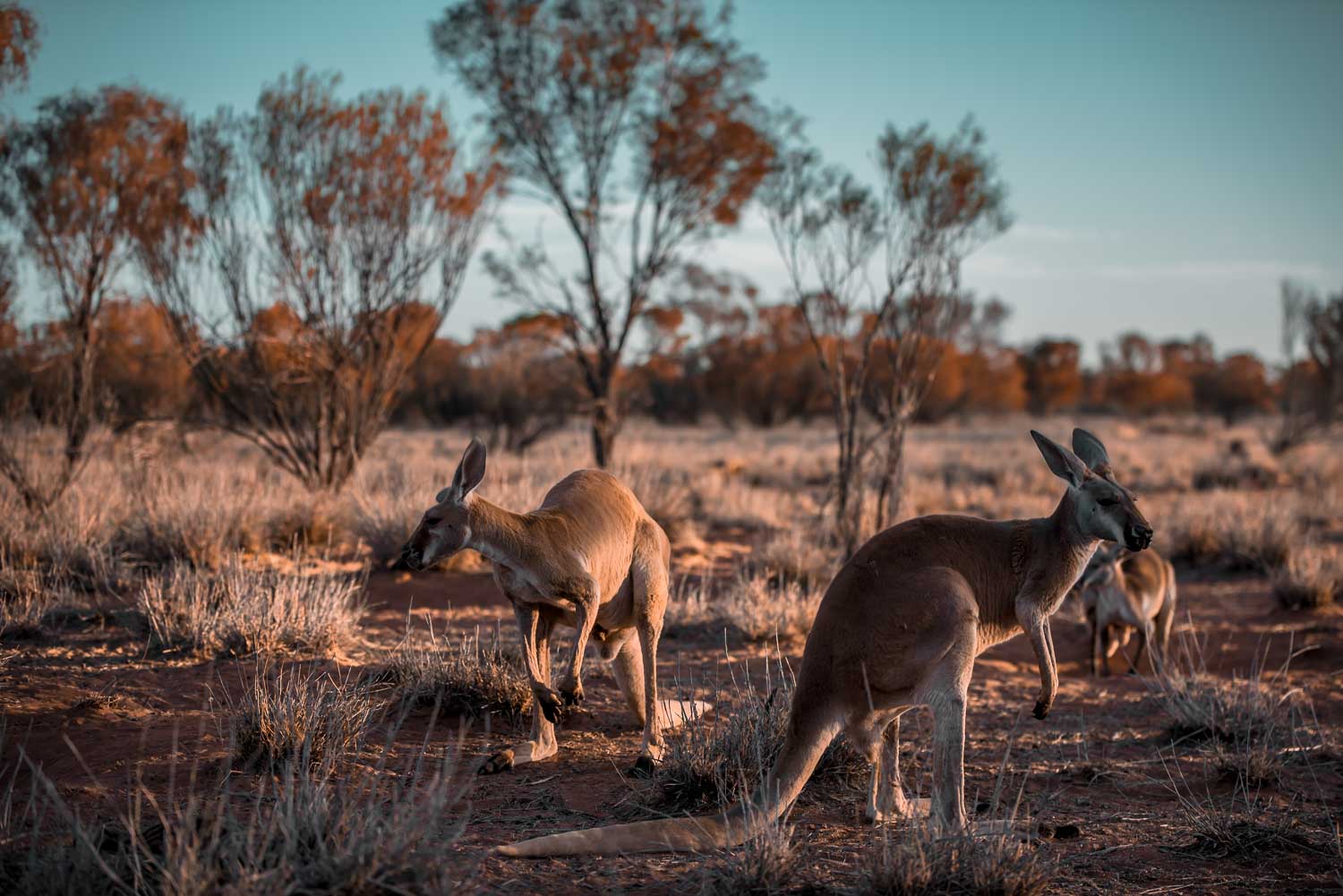
The West MacDonnell National Park
Nestled just a quick one-hour drive west of Alice Springs , you’ll find the entrance to the West MacDonnell National Park. If you enjoy hiking and working up a sweat against one of the most beautiful backdrops imaginable, this national park that belongs to the well-known MacDonnell ranges is the destination for you!
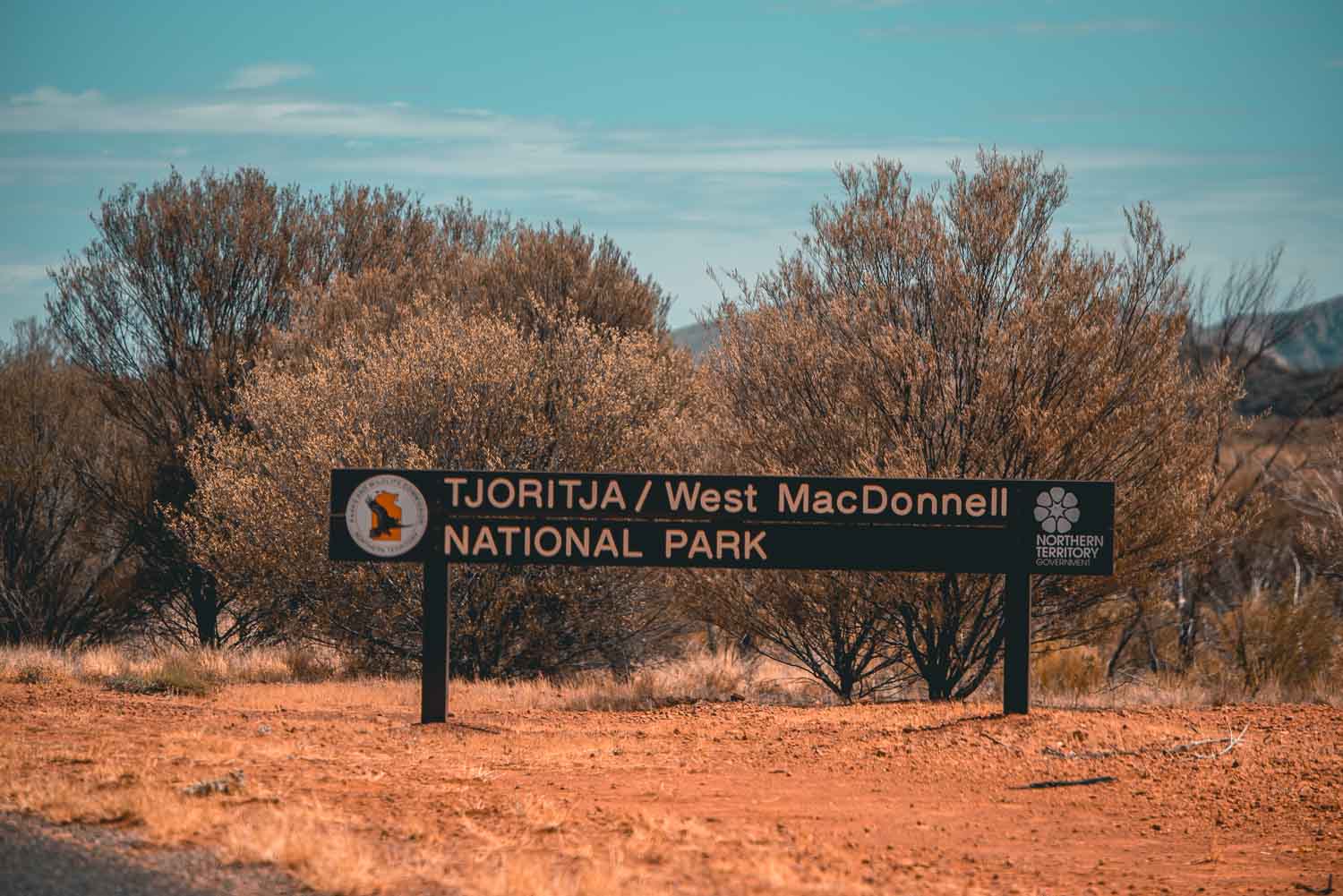
I had actually never heard of this National Park before visiting Alice Springs, and I was completely blown away from our one-day adventure out there. This is the “Red Center”, and the landscape and scenery really is something special! I was obsessed with the windy Outback roads, the desert colors, and the picturesque swimming holes!
You absolutely can’t visit Alice Springs without booking a full-day trip out to these spots. You could also rent a car and do it yourself, just make sure you visit key spots like Simpsons Gap, Ormiston Gorge, and Ellery Creek Big Hole (pictured below).
From Alice Springs: West MacDonnell Ranges Day Trip | Experience the best of the West MacDonnell Ranges on this full-day trip from Alice Springs. Marvel at the fiery red walls of the mountains in the desert sun, visit gorges and waterfalls, spot local wildlife and learn from your expert guide.
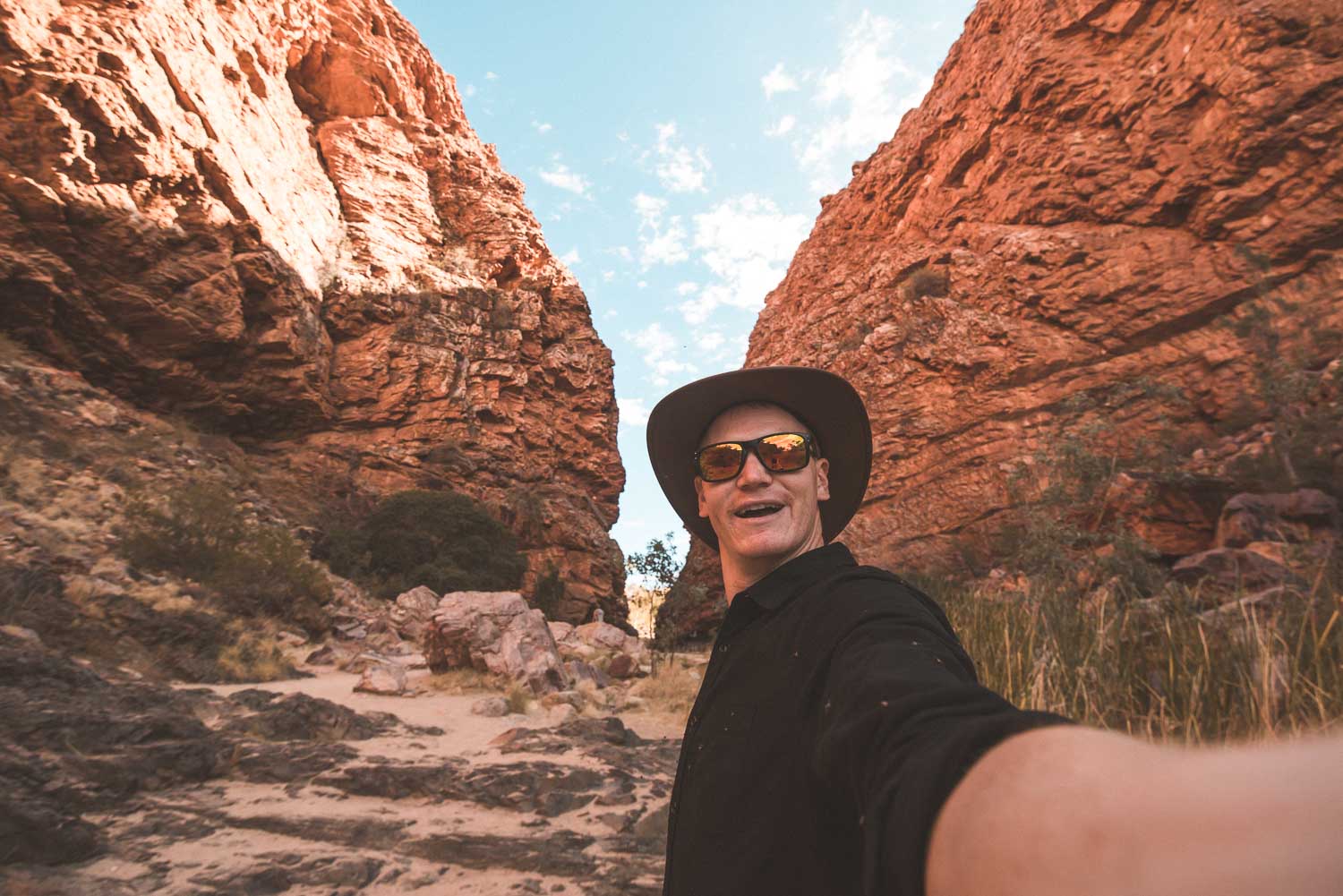
Simpsons Gap
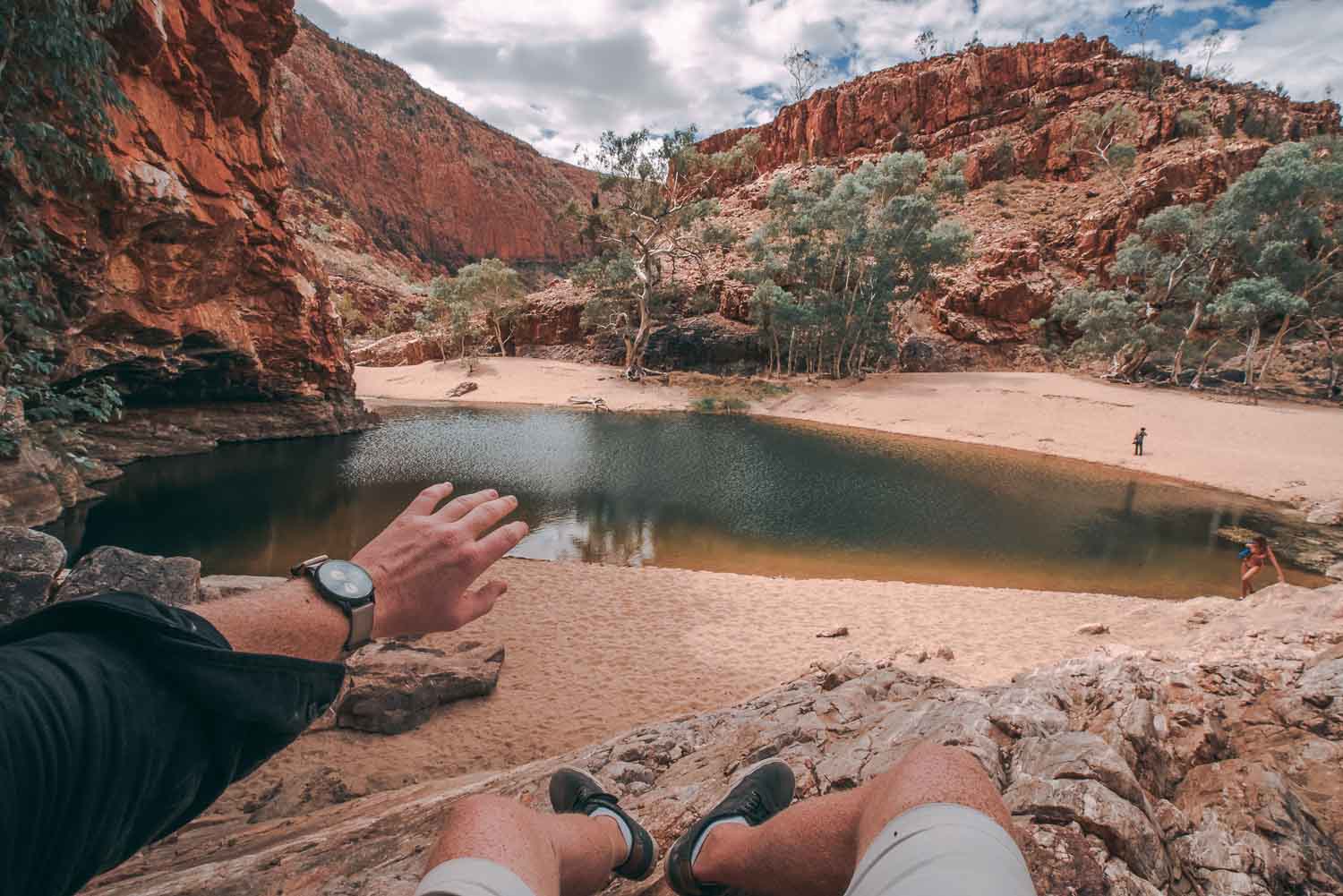
Ormiston Gorge
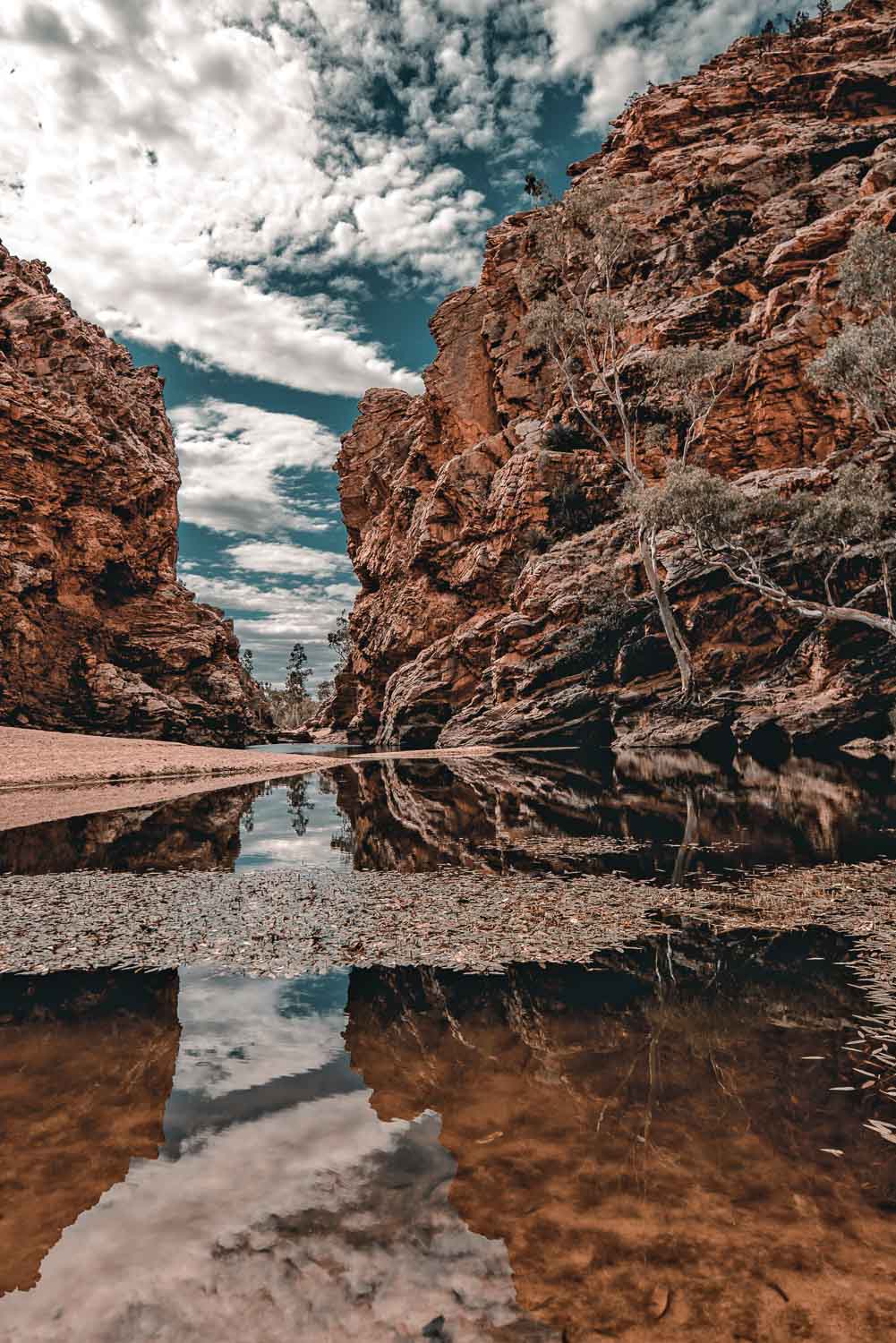
Ellery Creek Big Hole
Uluru is one of the most visited natural landmarks in the world, and unfortunately, this particular trip itinerary was just too jam-packed for me to tick it off my wanderlust bucket list. Located within Uluru-Kata Tjuta National Park, this immense sandstone must-see is of particular cultural significance to the Aboriginal community and tourists are, thankfully, veering away from climbing it these days.
If you are heading to the Red Centre, there’s a number of companies that organize day and overnight trips to this Outback icon, including my personal recommendations:
Uluru: Guided Trek of Uluru’s Base in a Small Group : This six hour tour is a great introduction to Uluru, where you will enjoy a walk around the base, breakfast and a tour guide full of interesting insights and historical knowledge.
From Alice Springs: Uluru 3-Day Camping Tour: If you want to make the most of your visit to this famous Aussie landmark, book in your place on this three day camping tour. You’ll also get to see the breathtaking Kings Canyon and Kata Tjuta, as well as counting the millions of stars in the Outback sky from your sleeping bag.
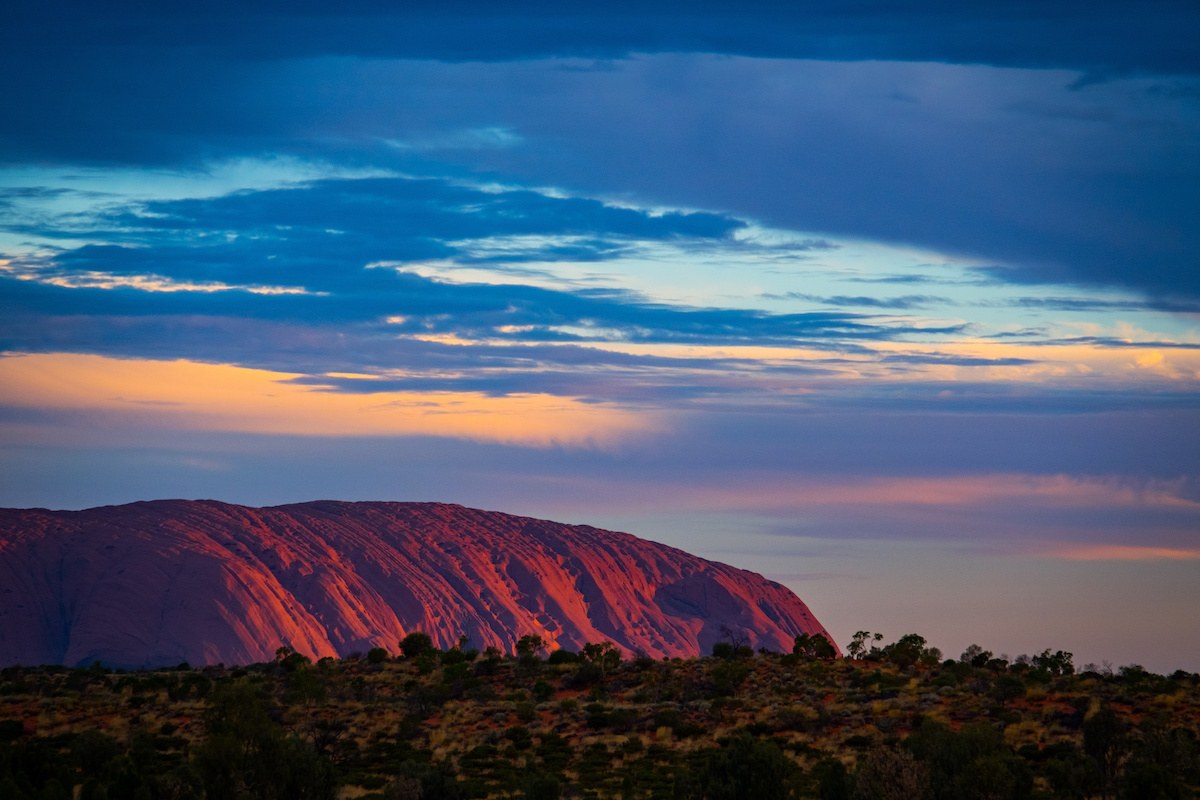
The Town of “Alice”
Visitors are prone to overlooking the city of Alice Springs itself in place of visiting its surrounding natural wonders. But while Alice is often a pit stop for travelers on the road, it has its own unique charm that makes it a great place to spend some downtime. And with only 25,000 residents, it’s a cozy city with tons of room to breathe.
A few recommendations for what to see in Alice Springs:
Anzac Hill : The Anzac tradition is dear to every Aussie’s heart, and pays homage to those who fought and died for the country across many wars. This memorial offers a view of Alice Springs you can’t get anywhere else, as well as a chance to reflect in a peaceful location.
Alice Springs Reptile Centre: The Northern Territory’s biggest collection of reptiles call this centre home, including goannas, crocs, frill-neck lizards and thorny devil’s. With three daily shows, you’ll learn a lot about these native not-so-furry friends.
Royal Flying Doctor Service Museum : The RFDS is an Australian institution, providing critical support and emergency services to those living in rural or remote areas across the country. Visit where it all began at this Alice Springs museum, where you can see the original planes and radio equipment used in the early days of the service.
Further reading : 3 Days in Alice Springs Travel Itinerary
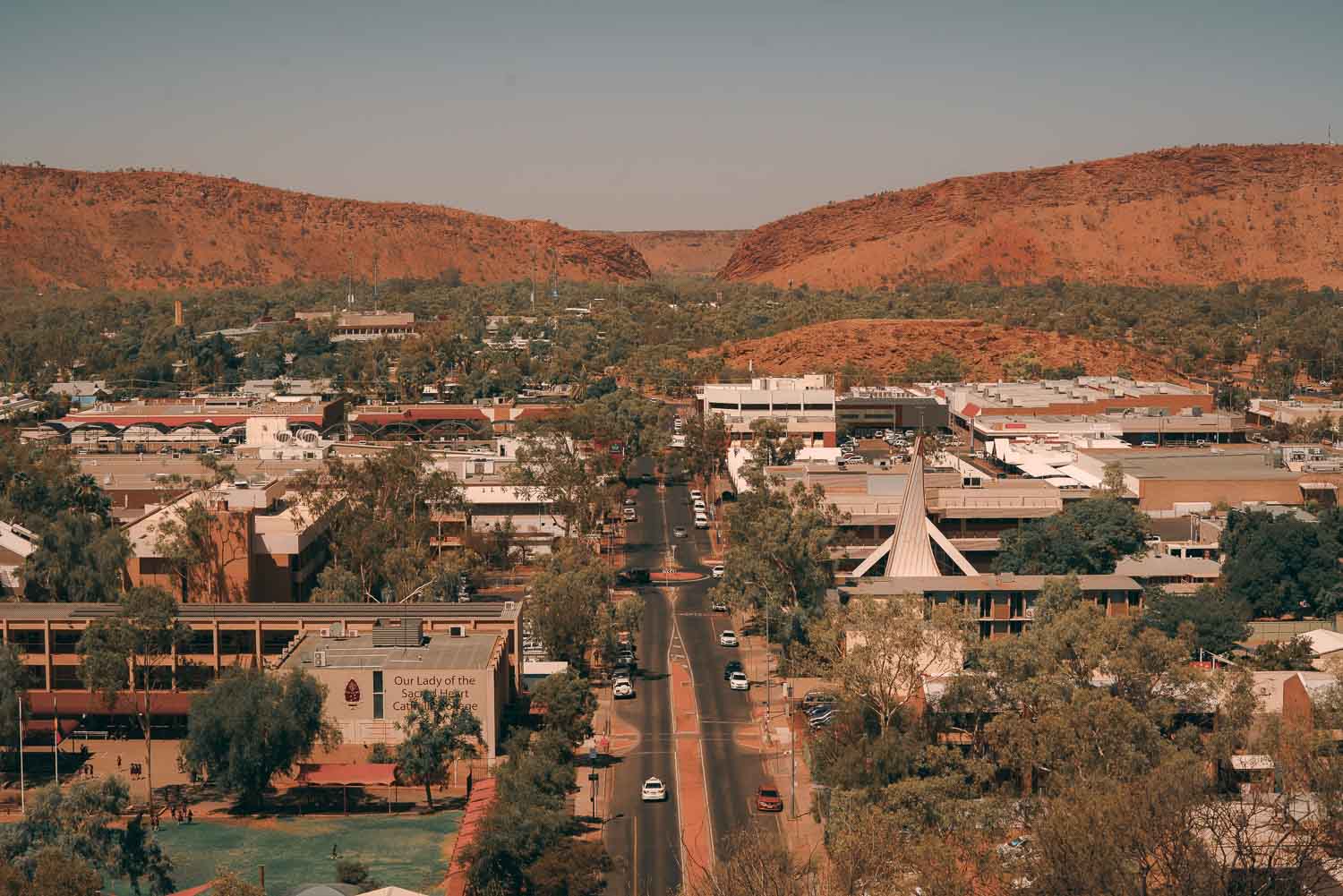
Where to Stay in Alice Springs
Crowne Plaza Alice Springs – Treat yourself in the Red Centre and experience the luxury of staying at the Crowne Plaza Alice Springs. It’s local to both the CBD and Alice Springs Airport, has a huge pool to cool off in, gym, spa, dining options and the staff are extremely courteous and helpful. 10/10 would recommend.
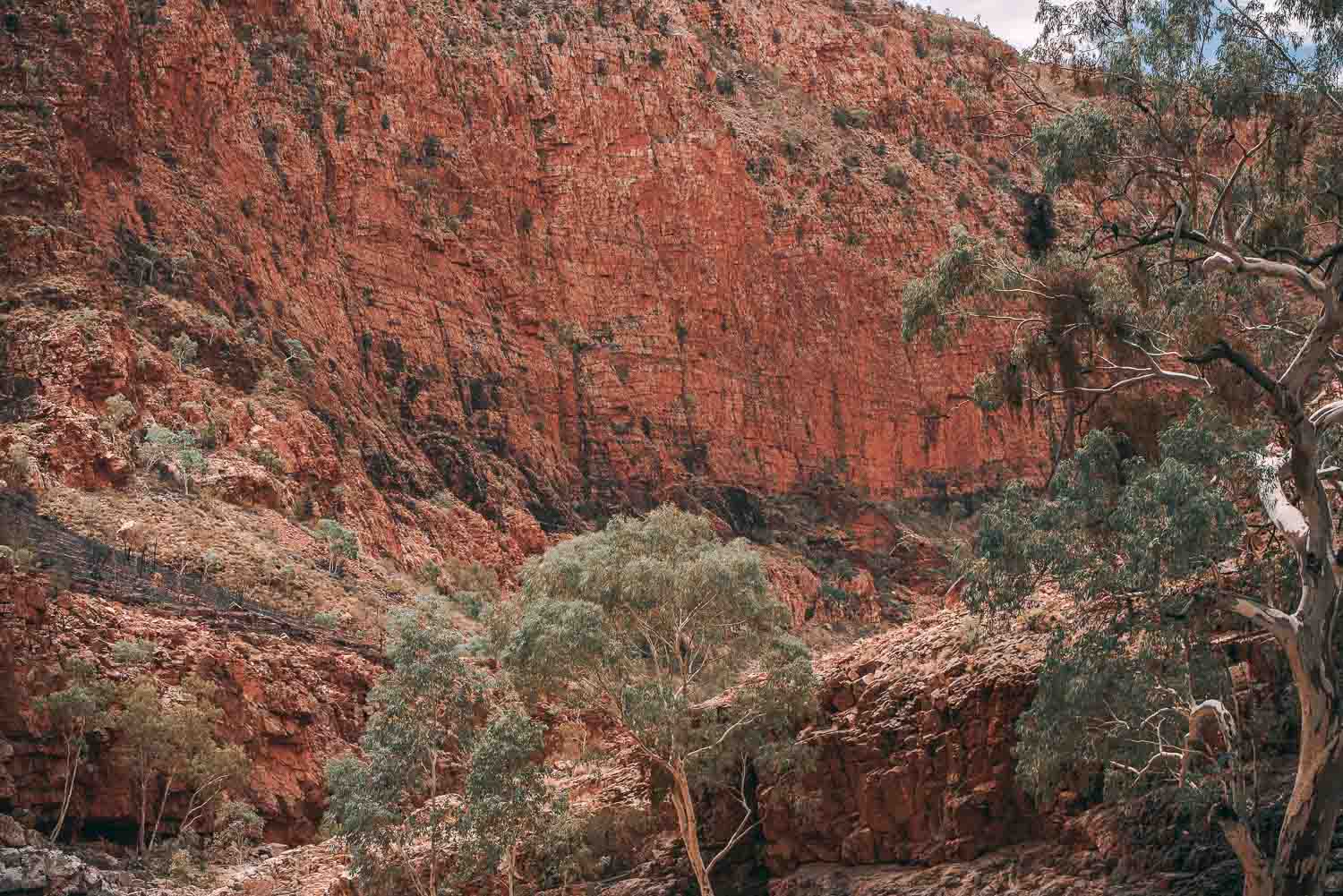
Some important Northern Territory travel tips:
- Pack sturdy walking shoes.
- Mosquito repellant and a fly net are mandatory.
- Regularly apply sunscreen (that Outback sun is HARSH!)
- Pack breathable, natural clothing.
- Carry lots of water on you and in your vehicle.
- Don’t just pack for intense heat. Nights in the Outback can get pretty chilly, so definitely prepare for that.
- Understand that this is one of the most remote places on Earth, and amenities and services can be hundreds of kilometers apart. Carry additional fuel and supplies if you know it’s going to be a long haul between service stations.
- Read up on how to treat the local Aboriginal tribes and communities with respect while you are visiting their land. They are very friendly and accommodating people, and we all owe them the same respect back. Some understanding of their customs will go a long way.
- If road tripping in your own vehicle, have a full car service before your trip. Breaking down without resources in the Outback can turn deadly fast. Plan and pack accordingly.
- Advise someone back home of your travel plans and check in regularly while on the road.
- Avoid driving at night. With local wildlife crossing the road in the dark, an accident could spell disaster.
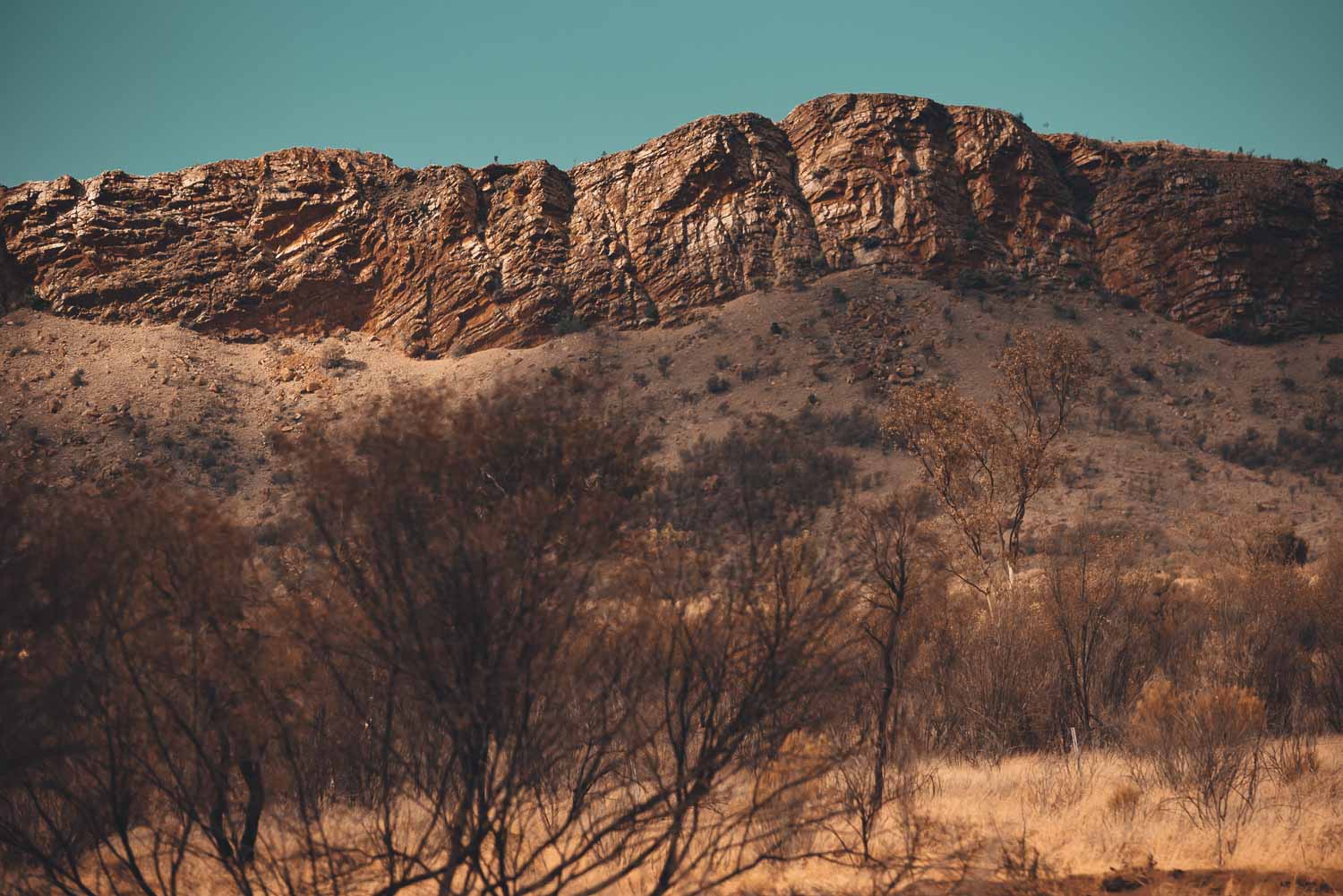
Am I Missing Anything important on this Northern Territory Itinerary…?
The Australian “Outback” is a pretty massive place, and I feel like even after spending a couple of weeks out there, I still have a lot more that I need to explore in the future! I’d love to hear from you guys if you have any hidden gems or other important places I should add to my list!!
Be sure to follow along on my Facebook & Instagram pages as well for more of my adventures around the world!
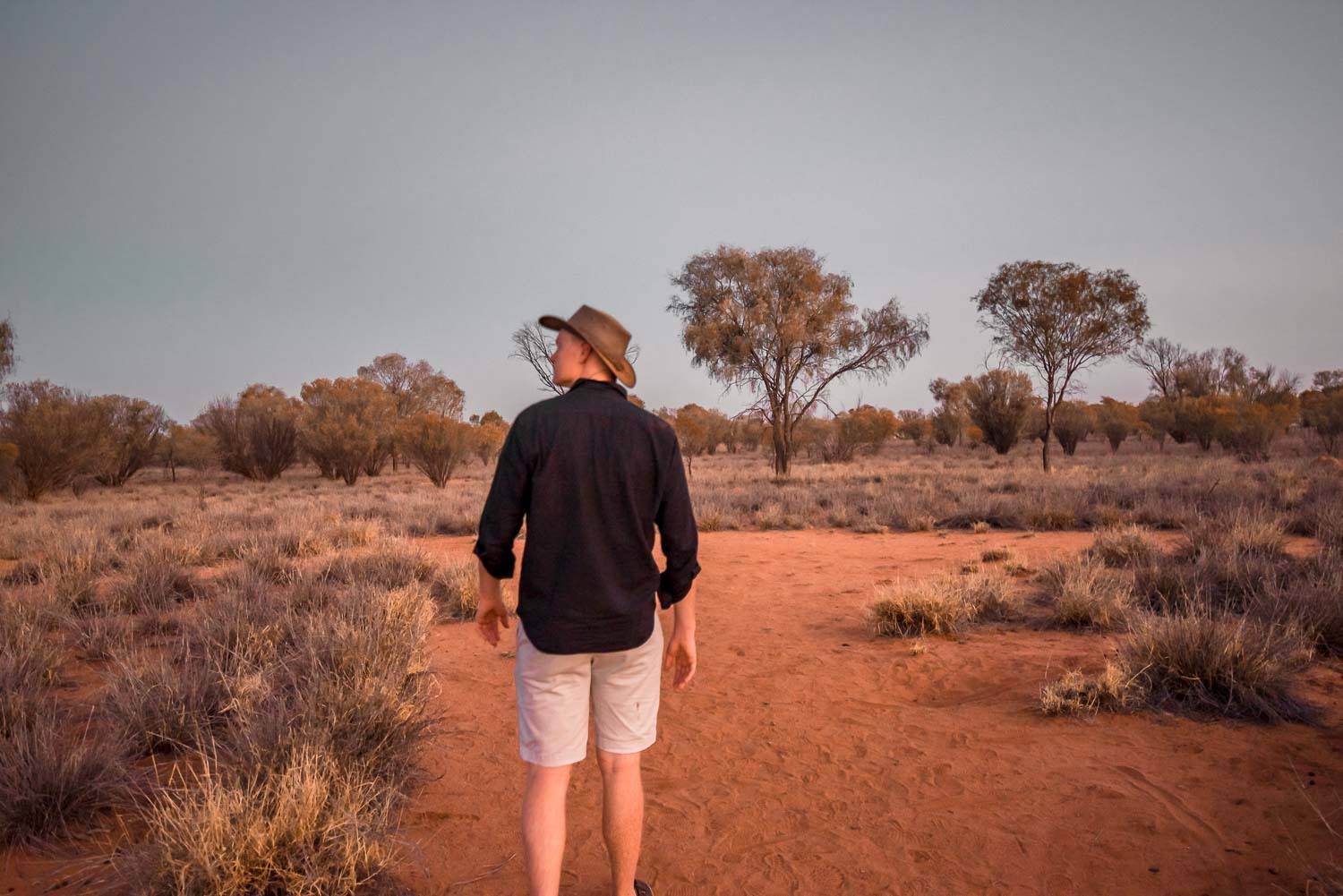
Planning a trip to Australia…?
I’ve spent quite a large amount of time down under, and my website is filled with awesome articles and travel guides just like this. Check out a few of them below, and feel free to reach out to me if you ever have any questions!
- The Ultimate SYDNEY Itinerary | How to Spend 4-7 Days in Sydney
- The Ultimate MELBOURNE Itinerary | How to Spend 4-7 Days in Melbourne
- 14 Words You’ll Start Saying When You Move to Australia
- The Ultimate Guide For Moving To Sydney on a Working Holiday Visa
- Cairns – Sydney: The Ultimate Greyhound Bus Pass Itinerary
- 30 Music Festivals in Australia To Experience Before You
- The 5 Best Rooftop Bars in Melbourne
- The 14 Best Music Festivals in Sydney
- Top 10 Music Festivals in Melbourne
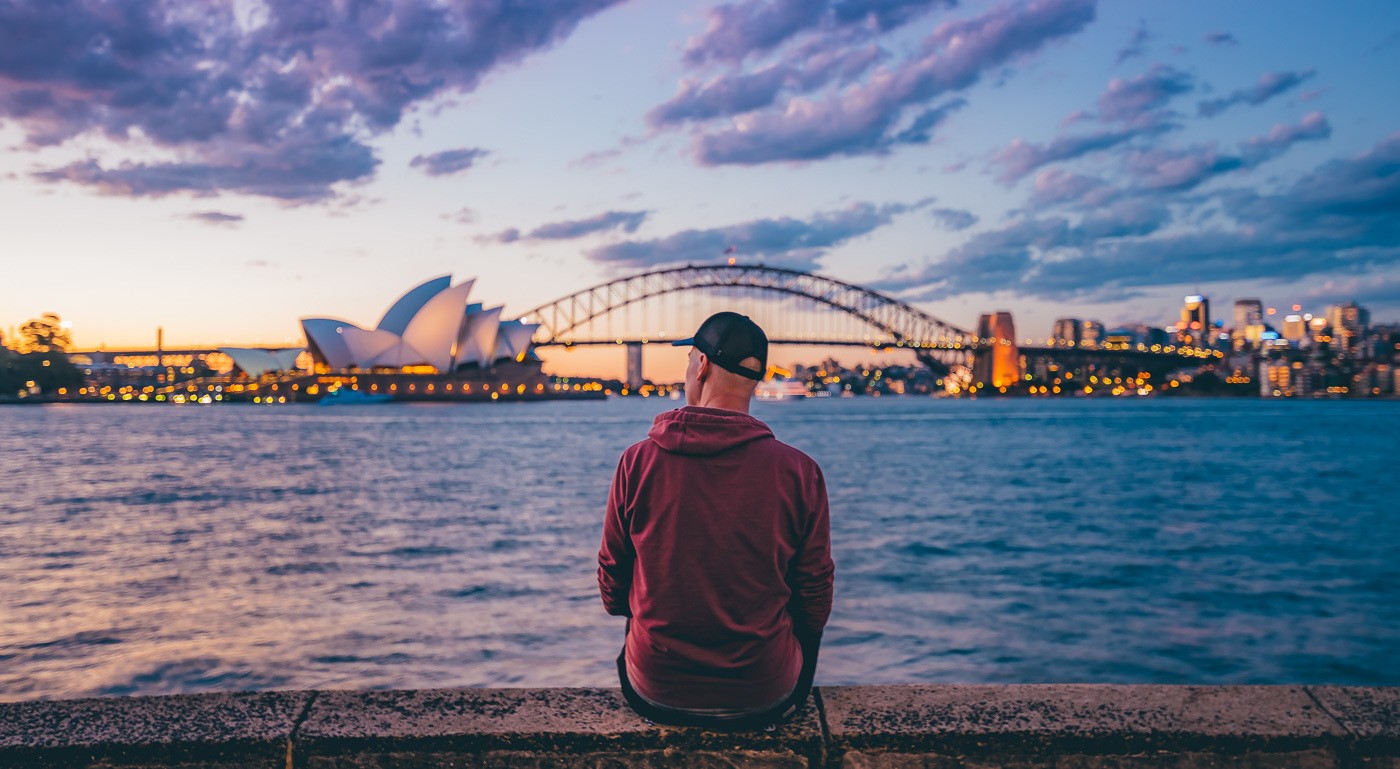
Thanks so much for reading my Australian Outback itinerary!
Share this article with your Aussie mates!

Disclaimer: I was an invited guest by Tourism NT to come and experience the Australian Outback and share my experiences. As always, all opinions are my own.
I’ve really been enjoying your posts Thanks for sharing such an useful Information
Trackbacks & Pingbacks
[…] Transylvania… driving through the scenic highlands of Scotland… or rolling through the outback on Australia‘s famous Ghan train… and dozens of other intriguing options all over the […]
[…] My Australian Outback / Northern Territory Travel Itinerary […]
Leave a Reply
Leave a reply cancel reply.
Your email address will not be published. Required fields are marked *
Save my name, email, and website in this browser for the next time I comment.
Photography Gear
Work With Me
Privacy Policy
Destinations
Music Festivals
Travel Itineraries
Inspiration
Travel Gifts
Southeast Asia
Outback Tours & Vacations

Vast, unforgiving and mostly uninhabited...
But one thing's for sure: the Australian Outback is one of the most intriguing and beautiful places you'll likely ever see. With its sun-scorched gorges set against blue skies, remarkable monoliths, waterfall-fed swimming holes and ancient First Nations cultures , the Outback was practically made for adventures. Called us biased, but we reckon such places are best explored with the experts (read: locals) who know their way around and can share a tale or two along the way. Just don't forget to pack your Akubra.
Our Outback trips
Let's create an exclusive trip for your group.
Outback highlights
Outback tour reviews.
Filter by rating
Kakadu, Katherine & Litchfield Explorer
Red Centre & Uluru Explorer
South Australia Outback Adventure
Articles of Outback
Life after cancer: the survivor who fell in love with the Outback and became an Intrepid trip leader
9 animals to see in Uluru & Kings Canyon
5 reasons for Kiwis to visit Australia right now
6 of the best swimming holes in Australia’s Top End
What to expect on an Australian overland adventure
4 places to discover in Australia’s Red Centre
Uluru through the lens: an Outback 50mm challenge
Outback destinations
Outback travel faqs, how much of australia is the outback.
The Outback occupies a whopping 70% of mainland Australia. It spans 2.1 million square miles, including all of the Northern Territory and a large part of South Australia, Queensland, Western Australia and New South Wales.
What is the weather like in the Outback?
You might assume the Outback is hot and dry all year round. While it gets very hot in the summer, people are surprised to learn how cold winter nights can be – with temps often plummeting to zero.
The climate varies throughout the Outback ranging from semi-dry tropic, arid and desert. Generally speaking, this means there are two seasons: summer which sees hot, humid days and mild nights, and winter which sees warm days and cold nights.
When is the best time to visit the Outback?
The Outback is stunning year-round, but winter (May-October) is considered the best time to visit for good weather. During these months, it's warm to hot during the day and cold at night. The conditions are near-perfect for hiking and exploring, and you won't spend your entire trip wiping sweat from your brow or battling with flies.
How to get to the Outback
The Outback is vast and remote. The best way to get there if you don't have much time is to fly. Otherwise you'll spend far too much time on the road. There are daily flights between Alice Springs, Darwin, Broome and other Outback towns from most major cities in Australia.
How to get around the Outback
The short answer is you’ll either need to self-drive or join a tour. The Outback is massive and public transport is scarce. Even with a car, you’ll often drive for hours without seeing another soul on the road. To give you an idea, Adelaide to Darwin is 1,864 miles and takes 31 hours to drive.
What animals are in the Outback?
From arid desert to lush gorges filled with trees and natural watering holes, the Outback's landscapes are super diverse – and so is the range of native fauna that call it home. Some of the animals you can expect to see on your Outback adventure include:
- Saltwater crocodiles
- Frilled-necked lizards
- Sand goannas
- Thorny devils
- Australian feral camels
What to wear in the Outback
Layers are key. Breathable, long-sleeved pants and shirts are comfortable for walking, and they also double up as sun protection. You should avoid wearing light colors (unless you want red dirt-stained clothes to take home with you as a souvenir!). Other essentials include a good pair of hiking boots and/or runners, sandals, a wide-brimmed sun hat, bathers, sunglasses, sunscreen and a small daypack.
If you’re visiting in the winter (May-September), you’ll definitely need a warm fleece, long pants, a woolly hat and maybe some thermals as the temperature often dips below freezing and it’s not uncommon to see ground frost in the morning.
Are Intrepid trips accessible for travelers with disabilities?
We are committed to making travel widely accessible , regardless of ability or disability. We do our best to help you see the world, regardless of physical or mental limitations.
We are always happy to talk to travelers with disabilities and see if we can help guide them toward the most suitable itinerary for their needs and, where possible, make reasonable adjustments to our itineraries.
1-888-359-2877
Australia Outback Experiences
spectacular
Welcome to a world of rugged terrain, expansive vistas, and untamed beauty. At About Australia, we specialize in curating bespoke travel experiences that delve into the heart of Australia’s awe-inspiring Outback. Our team of travel experts is passionate about designing the perfect itinerary tailored to your preferences, ensuring every detail is meticulously planned.
Explore the iconic Red Centre, where ancient rock formations stand in silent testament to time. Venture into the vast expanse of the Pilbara and Kimberley regions in Western Australia, where rugged gorges and hidden waterfalls await your discovery. Uncover the enchanting Flinders Ranges and stunning Gawler Ranges in South Australia, where dramatic landscapes and rich Aboriginal heritage offer a unique journey through the Outback.
Immerse yourself in the essence of Australia’s outback wilderness, from encountering unique wildlife to experiencing Aboriginal culture firsthand. Let us transform your travel aspirations into reality with personalized itineraries that promise unforgettable experiences and cherished memories in Australia’s captivating Outback.
outback TRIPS IN AUSTRALIA
Explore our sample itineraries highlighting the rugged beauty of Australia’s Outback, where every journey is an adventure waiting to unfold. Contact us today to begin crafting your personalized itinerary, meticulously tailored to fulfill your every desire and ensure your journey through Australia’s Outback is nothing short of extraordinary.

Australia’s Wilds, West & Wine TOUR
View Details

Sydney, Outback, Reef & Fiji Package

The best Outback experiences in Australia
Discover Australia’s most fantastic outback experiences, and then contact us to have one of our travel specialists create a tailor-made Australia Outback travel package just for you!

Flinders Ranges

planning your outback ADVENTURE IN australia?
Get expert help from an Aussie Specialist who has the knowledge and experience to help you plan and book every detail of your trip.
More Destinations You’ll love

wine & food

City, Art & History


The Outback
Take a trip to outback australia on your australia vacation..
What is the Outback exactly? A good definition might be a vastly remote area with wide open spaces where urban areas don’t exist and something totally unique on an Australian vacation. This covers a large portion of Australia obviously. The Outback covers a huge amount of Australia and is basically the countryside and remote areas located hours away from big city life. However, there are many cities that are close by and make good starting points for interesting areas of the Outback on trips to Australia. The Outback is not by any means all desert, although this does take up a certain amount of territory. But even in the desert, one will come across vegetation and waterholes. Wildlife has also adapted to the more remote parts. Kangaroos, dingoes, emus, wild horses and wild camels can frequently be seen. What does the Outback offer the traveller on Australian tours? The ability to explore, of course! This can be done either on a self-drive arrangement or on an organized tour. A few of the better-known areas which constitute a part of the Outback are Alice Springs, Kakadu National Park and Ayers Rock in the Northern Territory, Broken Hill in New South Wales, Broome in Western Australia and Flinders Ranges in Queensland which gives you an idea geographically just what is the Australian Outback.

Get Inspired About Australia
The experts in tailor-made travel.
When working with Goway, you dream it, we plan it. Rely on the passion and expertise of our Destination Specialists to craft the trip that’s right for you.

Sign up to our newsletter to unlock travel Specials, Inspiration, and Expert Guides right to your inbox.
Get FREE Australia Travel Advice

Australia in Summer: The Best Time to Visit For That Ultimate Experience
Australia Travel Hub contains affiliate links and is a member of the Amazon Services LLC Associates Program. If you make a purchase using one of these Amazon links, I may receive compensation at no extra cost to you. Read my Disclosure Policy for more information.
Australia in summer is nothing short of spectacular. With its endless stretches of golden beaches, vibrant cities buzzing with energy, and stunning natural landscapes, it’s a destination that comes alive under the summer sun.
Summer is the best time to visit for warm weather and outdoor adventures from December to February.
Whether you’re keen on exploring the Great Barrier Reef , relaxing by the beach, or discovering the unique wildlife, summer in Australia offers many experiences.
However, planning a summer trip to Australia requires a few key considerations to ensure you have the best time possible.
From understanding the climate to knowing what to pack and where to go, this guide will help you prepare for an unforgettable Aussie summer.
🔍 Table of Contents
Understanding the Australian Summer
The Australian summer is known for its warm temperatures and diverse climates, so it’s essential to understand what to expect when planning your trip.
Knowing the weather patterns will help you make the most of your summer adventure from the tropical north to the temperate south.
The Summer Months in Australia
Summer in Australia runs from December to February, offering warm temperatures, plenty of sunshine, and a vibrant atmosphere across the country.

The climate varies depending on where you are. In the southern parts, like Sydney and Melbourne , you can expect warm days, usually around 25-30°C, with cooler evenings.
Northern regions, including Cairns and Darwin, experience more tropical weather, with higher humidity and occasional summer rains, making it hotter and stickier.
This season is when Australia truly comes alive, with outdoor festivals, beach days, and longer daylight hours. Coastal areas become popular destinations as locals and tourists flock to the beaches to swim, surf, and soak up the sun.
Inland areas can get hot, especially in places like the Outback, where temperatures can soar above 40°C, so planning and preparation are essential.
Peak Season vs. Low Season Travel
Summer is the peak travel season in Australia, particularly around Christmas and New Year.
Popular destinations such as the Great Barrier Reef, Sydney, and the Gold Coast can get crowded, and accommodation prices spike due to the high demand.
Booking well in advance is recommended to secure the best deals and avoid disappointment.
On the other hand, early December and February are considered the low season, especially after the holiday rush. Travelling during these times can be a more relaxed experience, with fewer crowds and better accommodation availability.
You might also find lower prices on flights and tours, making it a good time for those looking for a quieter holiday or a budget-friendly trip.
The weather is still lovely, and you’ll have more space to explore some of Australia’s iconic spots without the hustle and bustle.
Regional Weather and Climate
Australia’s summer weather varies significantly across its regions, making it essential to understand what to expect based on where you’re heading.
The country’s vast size means that the climate can change drastically from one place to another, even within the same season.
Northern Regions
In the north, including Darwin and Cairns, summer means tropical weather. Expect hot temperatures, often exceeding 30°C, combined with high humidity.
This time of year also marks the start of the wet season, so you’ll encounter heavy rainfall, particularly in the afternoons and evenings.
These summer storms, with the occasional cyclone, can be intense, but they’re usually brief. The landscape becomes lush and green, and the waterfalls are at their most spectacular.
Southern Regions
Southern parts of Australia, such as Melbourne, Adelaide, and Hobart, enjoy a more temperate summer.
Temperatures generally range from 20-30°C, with occasional hot spells pushing into the mid-30s. The weather here is more stable, with clear skies and warm, sunny days.
Evenings can be cooler, especially near the coast, so it’s a good idea to pack a light jacket . These areas are perfect for outdoor activities like hiking, exploring vineyards, or enjoying the cultural events that fill the summer calendar.
Coastal Areas
Australia’s coastal regions, including Sydney, the Gold Coast, and Perth, are ideal summer destinations. These areas enjoy warm weather, typically between 25 °C and 30°C, perfect for beach activities.
However, be mindful of the UV index, which can be very high in summer. Wearing sunscreen , a hat , and sunglasses is crucial to protect yourself from sunburn.
Coastal areas can also experience summer storms, which are usually short-lived and followed by clear skies.
Inland Regions
Inland Australia, such as the Outback and central deserts, experiences extreme summer heat. Temperatures can easily surpass 40°C, and the dry climate can make it feel even hotter.
Wet Season in Tropical Areas
The wet season in tropical regions, which runs from November to April, overlaps with summer. Expect frequent, heavy downpours and increased humidity.
While the rain can be intense, it’s usually short-lived, leaving plenty of time to enjoy the outdoors.
The wet season is also when the landscape is most vibrant, with rivers full and wildlife active. However, knowing the potential for flooding and road closures in more remote areas is essential.
Despite the challenges, the wet season can be a unique and beautiful time to explore Australia’s tropical north, with fewer tourists and the opportunity to see the country at its most lush.
Best Summer Destinations in Australia
Coastal cities and beaches.
Australia’s coastal cities and beaches are some of the most iconic and beautiful in the world.
Sydney is Australia’s most famous coastal city, known for its stunning harbour and iconic landmarks like the Sydney Opera House and Harbour Bridge.
But beyond the city’s architectural marvels, Sydney’s coastline is dotted with beautiful beaches, making it a prime spot for surfing, swimming, and sunbathing.
Bondi Beach, in particular, is a must-visit, famous for its golden sands and lively atmosphere.
The Bondi to Coogee coastal walk offers spectacular views and a chance to explore smaller, secluded beaches.

The Gold Coast is a surfer’s paradise with its golden beaches and consistent waves. This city is a hub of activity, combining a laid-back beach culture with a vibrant nightlife and entertainment scene.
Surfers Paradise is the heart of the Gold Coast, where skyscrapers meet the ocean. It offers a unique mix of city and beach life.
The Gold Coast is also home to several theme parks and wildlife sanctuaries, making it an excellent destination for families.
Melbourne may be better known for its culture and cuisine, but it also boasts beautiful beaches just a short tram ride from the city centre.
St Kilda Beach is a favourite among locals and visitors, with its relaxed vibe, colourful beach huts, and the iconic St Kilda Pier.
Further along the coast, you’ll find Brighton Beach, famous for its vibrant bathing boxes and calm waters, perfect for a leisurely swim.
Melbourne’s coastal charm is best enjoyed in summer when the weather is warm and the beachside cafes are buzzing with activity.
Top Beach Destinations
Bondi beach.

Bondi Beach is more than just a beach; it symbolises Sydney’s outdoor lifestyle. Known for its surf, soft sands, and vibrant community, Bondi is a must-visit.
The beach is patrolled by lifeguards year-round, making it a safe spot for swimming. The nearby Bondi Icebergs Club offers stunning ocean views and a unique saltwater pool on the beach’s edge.
Whitehaven Beach

Located in the Whitsundays, Whitehaven Beach is often regarded as one of the most beautiful beaches in the world. Its seven kilometres of white silica sand contrast with the clear turquoise waters.
The beach is part of the Great Barrier Reef Marine Park, making it an ideal spot for snorkelling and exploring the underwater world. Access to Whitehaven is usually by boat, adding to the sense of adventure.

Byron Bay is a coastal gem known for its relaxed atmosphere, stunning beaches, and alternative lifestyle.
Main Beach is perfect for swimming and surfing, with gentle waves and a vast stretch of sand that is ideal for sunbathing or a beach picnic.
Just a short walk from the town centre, you’ll find Wategos Beach, a secluded spot between the headlands, offering calm waters and a more tranquil setting.
For those seeking adventure, the Cape Byron walking track leads to the iconic Cape Byron Lighthouse, the easternmost point of mainland Australia.
The lighthouse provides panoramic views over the ocean, and during the migration season, you might even spot dolphins or whales.
Byron Bay’s unique blend of natural beauty, laid-back vibe, and vibrant arts scene makes it a must-visit destination for anyone exploring Australia’s coastline.
Cairns and the Whitsundays

Cairns is the gateway to the Great Barrier Reef. While the city doesn’t have a traditional beach, it’s the launching point for some of Australia’s most breathtaking coastal experiences.
Just a short boat ride away are the pristine islands of the Whitsundays, home to beaches like Whitehaven that are world-renowned for their beauty.
The warm tropical waters are perfect for snorkelling and diving, offering a glimpse into the rich marine life for which the Great Barrier Reef is famous.
Cairns also boasts the stunning Cairns Esplanade, with its man-made lagoon offering a safe spot for swimming, surrounded by picturesque parklands and walking tracks.
National Parks, Natural Wonders, and the Outback
Australia’s diverse landscapes are home to some of the world’s most stunning national parks and natural wonders.
From ancient rainforests to rugged outback terrains, these destinations offer a unique glimpse into the country’s incredible natural beauty.
Kakadu National Park

Kakadu is Australia’s largest national park and a UNESCO World Heritage site in the Northern Territory.
This park is a vast wilderness that spans over 20,000 square kilometres, offering an incredible mix of wetlands, rivers, and sandstone escarpments.
During summer, known locally as the “wet season,” the park’s waterfalls fully flow, and the landscape turns lush and green.
While some areas may be inaccessible due to flooding, Kakadu is most vibrant in the wet season, with spectacular thunderstorms and abundant wildlife.
Great Otway National Park

The Great Otway National Park is a lush rainforest paradise located in Victoria. Stretching from the surf coast near Torquay to the rugged coastline of the Great Ocean Road , this park is a must-visit for nature lovers.
During summer, the park’s cool fern gullies and cascading waterfalls offer a refreshing escape from the heat.
You can explore ancient rainforests, visit the iconic Cape Otway Lightstation, or walk along the breathtaking coastline where the forest meets the sea.
Daintree National Park

The Daintree is one of the oldest rainforests in the world and a place of profound natural beauty.
Located in Queensland , it’s part of the Wet Tropics World Heritage Area and is home to an extraordinary array of plants and animals.
The rainforest has wildlife sounds in summer, and the humidity adds to the immersive experience.
Don’t miss the opportunity to take a guided tour through the rainforest or explore the mangroves and coral reefs that make this area unique.
The Daintree is also where the rainforest meets the Great Barrier Reef, offering a rare chance to experience two UNESCO World Heritage sites in one day.
Blue Mountains National Park
Just a short drive from Sydney, the Blue Mountains National Park is a stunning area of towering cliffs, eucalyptus forests, and cascading waterfalls.
The park is named for the blue haze created by the eucalyptus oil in the air, which gives the landscape a mystical quality.
Summer is a great time to explore the many walking tracks, take in the views from lookouts like Echo Point, and visit the famous Three Sisters rock formation.
The Blue Mountains offer a cooler retreat from the city’s heat, with plenty of opportunities for bushwalking and discovering hidden waterfalls.
Great Barrier Reef
The Great Barrier Reef is one of Australia’s most iconic natural wonders and the largest coral reef system in the world.
Stretching over 2,300 kilometres, it’s a haven for marine life and a bucket-list destination for snorkelling and diving.
Summer is a great time to visit, with warm waters and an abundance of vibrant coral and fish.
However, be mindful of the stinger season in northern Queensland waters, and consider wearing a stinger suit for protection.
Uluru, also known as Ayers Rock, is a sacred Aboriginal site and one of Australia’s most recognisable landmarks.
Located in the heart of the Northern Territory’s Red Centre, this massive sandstone monolith changes colour throughout the day, glowing red at sunrise and sunset.
Summer in the outback can be extremely hot, with temperatures often exceeding 40°C, so visiting Uluru early in the morning or late in the afternoon is important to avoid the peak heat.
The nearby Kata Tjuta (The Olgas) is also worth exploring, with its striking domed rock formations.
Alice Springs
Alice Springs is the gateway to the Red Centre and offers an authentic outback experience. Alice Springs is rich in Aboriginal culture and history and is surrounded by rugged mountain ranges and desert plains.
The town is hot and dry during summer, with temperatures often soaring above 40°C. It’s essential to stay hydrated, wear appropriate clothing, and plan outdoor activities for the cooler parts of the day.
Despite the heat, summer is a great time to explore the surrounding areas, including the West MacDonnell Ranges and the many nearby gorges and waterholes.

The Kimberley
The Kimberley region in Western Australia is one of the country’s most remote and spectacular destinations.
The Kimberley is a true adventure known for its dramatic landscapes, including rugged gorges, vast savannahs, and ancient rock formations. Summer, however, is the wet season here, so expect heavy rains and potential road closures.
The upside is the landscape comes alive with waterfalls and wildflowers, making it a unique time to visit.
Travelling in the Kimberley during summer requires careful planning, as roads can become impassable, and conditions can be challenging.
A 4WD vehicle is essential for exploring this rugged region.
Tips for Safe Travel in the Outback
✅ Stay Hydrated: The outback heat can be intense, so carry plenty of water and drink regularly.
✅ Sun Protection: Wear a wide-brimmed hat , sunscreen , and sunglasses to protect yourself from the harsh sun.
✅ Plan Ahead The outback is remote, and services can be sparse. Ensure your vehicle is in good condition, and carry a first aid kit, extra fuel, and spare tyres.
✅ Travel early or late: Schedule outdoor activities in the early morning or late afternoon to avoid the peak heat.
✅ Stay Informed: Check weather conditions and road closures before heading out, especially during the wet season.
City Highlights
Australia’s cities are vibrant hubs of culture, events, and unique attractions, especially during summer.
From world-class festivals to hidden gems, Sydney, Melbourne, Adelaide, Brisbane, Hobart and Perth each offer something special for visitors.
Sydney shines in summer with its stunning harbour, iconic landmarks, and a packed calendar of events.
The Sydney Festival, held every January, transforms the city into a celebration of art, music, and theatre, with performances and exhibitions spread across various venues.
The Opera House is a must-visit, not just for its architectural beauty but for the diverse range of performances it hosts, from classical music to contemporary theatre.
One of Sydney’s unique attractions is the Sydney Harbour Bridge Climb, which offers breathtaking views of the city and the harbour from the top. For a more relaxed experience, head to The Rocks, a historic area filled with markets, cafes, and galleries.
Summer in Sydney also means outdoor cinema events, like those at Mrs Macquarie’s Point, where you can watch films under the stars with the Opera House and Harbour Bridge as your backdrop.

Melbourne is often described as Australia’s cultural capital, and for good reason. The city’s laneways are filled with street art, boutique shops, and cosy cafes, making it a joy to explore on foot.
In summer, Melbourne comes alive with festivals and outdoor events. The Melbourne International Arts Festival, held in February, showcases the best in theatre, music, dance, and visual arts worldwide.
Melbourne is also home to the Australian Open, one of the four Grand Slam tennis tournaments, which takes place every January. This event draws sports fans from across the globe, adding to the city’s already buzzing atmosphere.
For something different, visit the Royal Botanic Gardens, where you can enjoy an evening of cinema or theatre with the stunning gardens as your setting.
Don’t miss a trip to Federation Square, where you’ll find galleries, museums, live music, and an excellent spot for people-watching.
Adelaide may be smaller than Sydney or Melbourne, but it punches well above its weight in terms of culture and events.
The city is known for its festivals, notably the Adelaide Fringe, the largest open-access arts festival in the Southern Hemisphere.
Held in February and March, the Fringe features hundreds of performances, from comedy to cabaret, spread across various venues throughout the city.
Another summer highlight is the Adelaide Festival, a world-renowned arts festival in March.
It features theatre, music, dance, and visual arts. Adelaide’s summer events also include the Tour Down Under, the first international cycling calendar event that draws cyclists and spectators worldwide.
For a unique Adelaide experience, visit the Adelaide Central Market, one of the largest undercover markets in the Southern Hemisphere, where you can sample fresh produce and gourmet treats.
The city’s surrounding wine regions, like the Barossa Valley and McLaren Vale, are also perfect for a summer day trip. They offer wine tastings and scenic views.

Brisbane is a city that combines a laid-back lifestyle with a vibrant cultural scene. In summer, the town comes alive with outdoor events and festivals.
The Brisbane Festival, held in September but with an intense summer lead-up, is a major highlight. It features a mix of music, theatre, and visual arts.
For those visiting in January, the Riverstage hosts summer concerts in the heart of the city’s botanical gardens, making for a perfect evening out.
South Bank is Brisbane’s cultural precinct, home to the Queensland Art Gallery and Gallery of Modern Art (QAGOMA), the Queensland Museum, and the State Library of Queensland.
South Bank Parklands offers a man-made beach, perfect for a swim in the hot summer months.
The city’s proximity to the Gold and Sunshine Coast makes it an ideal base for exploring some of Queensland’s best beaches.
On Australia’s west coast, Perth enjoys long, sunny days during summer, making it a fantastic destination for outdoor activities.
The city is known for its beautiful beaches, like Cottesloe Beach, where you can swim, surf, or relax on the sand.
The Perth International Arts Festival, held in February and March, is one of the city’s major cultural events. It features an impressive theatre, music, film, and visual arts lineup.
Kings Park, one of the largest inner-city parks in the world, offers stunning views of the Perth skyline and the Swan River.
It’s an excellent spot for a picnic, a walk, or even an outdoor concert during the summer months.
Perth’s vibrant food and wine scene comes alive in summer, with alfresco dining and wine festivals showcasing the best of Western Australia’s produce.
Just a short ferry ride away, Rottnest Island is a must-visit, known for its pristine beaches, clear waters, and the famous quokkas, small marsupials native to the island.
Hobart, the capital of Tasmania, offers a charming mix of history, culture, and stunning natural scenery, making it a unique summer destination.
The city is famous for the Sydney to Hobart Yacht Race, which concludes in Hobart every year on Boxing Day. The race draws visitors and locals alike to the waterfront to watch the yachts arrive.
Summer in Hobart is also the time for the Taste of Tasmania festival, a celebration of the island’s best food, wine, and produce along the picturesque waterfront.

Hobart is home to the Museum of Old and New Art (MONA), Australia’s most unusual and fascinating museum. MONA offers a mix of contemporary art and ancient artefacts housed in a striking, underground setting.
Mount Wellington towers over the city for outdoor enthusiasts, offering breathtaking views and a range of walking tracks.
Hobart’s summer markets, like the Salamanca Market, are also must-visits. They offer everything from fresh produce to local crafts.
What to Do in Australia During the Summer
Outdoor activities.
Australia’s summer is the perfect time to embark on outdoor adventures. The country offers many activities that take full advantage of its stunning landscapes and coastline.
Beach and Water Activities
Australia is world-renowned for its beautiful beaches; summer is the ideal time to experience them.
Snorkelling and diving are top activities, especially in places like the Great Barrier Reef and Ningaloo Reef, where you can explore vibrant coral gardens and encounter a variety of marine life, including colourful fish, turtles, and even reef sharks.
For those looking to enjoy a more relaxed day by the water, many beaches, such as Bondi, Manly, and Byron Bay, offer patrolled swimming areas, ensuring a safe experience.
It is important to swim between the red and yellow flags, where lifeguards are on duty, to avoid strong currents and rips.
Surfing is another iconic Australian activity, with world-class surf spots available for all skill levels.
Beginners can take lessons at famous beaches like Noosa, Torquay, or the Gold Coast, while experienced surfers can tackle the waves at Bells Beach or Margaret River.
Kayaking and paddleboarding are also popular, offering a more leisurely way to explore Australia’s stunning coastline and inland waterways.
Hiking and Exploring National Parks
Australia’s diverse landscapes make it a hiker’s paradise, with national parks nationwide offering trails for all abilities.
In the cooler southern regions, parks like Great Otway National Park in Victoria and Blue Mountains National Park in New South Wales provide shaded trails through lush rainforests and dramatic cliffs.
In the northern regions, early morning hikes in places like Kakadu National Park or Daintree Rainforest are recommended to avoid the midday heat. This allows you to enjoy the natural beauty of these unique environments before the temperatures rise.

Tasmania’s Cradle Mountain-Lake St Clair National Park offers some of the best summer hiking in the country, with cool alpine air and stunning views.
The Overland Track, one of Australia’s most famous multi-day hikes, is a highlight for adventurous hikers. It takes you through some of the island’s most breathtaking scenery.
Adventure Sports
For thrill-seekers, Australia’s summer offers plenty of adventure sports to pump the adrenaline.

Skydiving is a popular choice, with stunning drop zones across the country, including Wollongong, the Whitsundays, and Rottnest Island, offering the chance to freefall over some of the most beautiful landscapes in the world.
Bungee jumping in Cairns and zip-lining through the treetops in Tasmania are other exciting options for those looking for an adrenaline rush.
Australia’s extensive coastline also makes it an ideal destination for kite surfing and windsurfing , with places like Perth’s Cottesloe Beach and Queensland’s Sunshine Coast offering ideal conditions.
For those who prefer land-based activities, mountain biking in parks like Victoria’s You Yangs Regional Park or New South Wales Snowy Mountains provides a challenging and exhilarating experience.
Summer in Australia is all about embracing the outdoors, and with such a wide range of activities available, there’s no shortage of ways to make the most of the season.
Summer Events and Festivals
Australia’s summer season is packed with vibrant events and festivals, offering something for everyone, from grand celebrations in major cities to local cultural gatherings.
Sydney’s New Year’s Eve
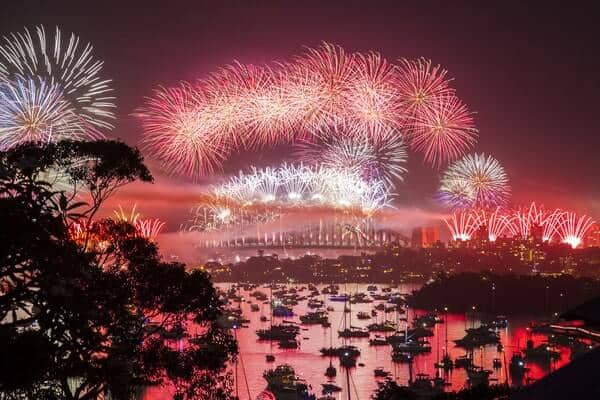
Sydney’s New Year’s Eve celebration is one of the most famous worldwide, attracting visitors from around the globe.
The event is centred around Sydney Harbour, with the iconic Sydney Opera House and Harbour Bridge providing a stunning backdrop for the festivities.
The evening culminates in a spectacular fireworks display, with colourful explosions lighting up the night sky as the clock strikes midnight.
Many vantage points around the harbour offer prime viewing spots, but it’s worth arriving early to secure a good position.
For a truly unforgettable experience, consider booking a place on one of the many harbour cruises, which provide a front-row seat to the action.
Australia Day
Australia Day celebrated on 26th January, is a national holiday that brings people together to celebrate the country’s history, culture, and achievements.
Major cities like Sydney, Melbourne, and Brisbane host large-scale events, including citizenship ceremonies, parades, and fireworks displays.
The day starts in Sydney with the Ferrython, a race of decorated ferries across Sydney Harbour, followed by concerts, markets, and impressive evening fireworks.
In Melbourne, the Australia Day Parade through the city’s streets showcases the diverse communities that make up the nation.
At the same time, Brisbane hosts live music and family-friendly activities along the Brisbane River.
Australian Open
The Australian Open, held in Melbourne every January, is one of the highlights of the global sporting calendar and the first of the four Grand Slam tennis tournaments of the year.
The event attracts the world’s top tennis players and thousands of fans, creating an electric atmosphere inside and outside the courts.
In addition to the thrilling matches, the Australian Open Festival offers a range of entertainment, including live music, food stalls, and interactive activities.
Melbourne Park, the tournament venue, becomes a hub of excitement, with fans enjoying the summer sunshine while watching world-class tennis.
Local Festivals and Cultural Events
Beyond the significant events, Australia’s summer is brimming with local festivals and cultural events that offer a more intimate experience of the country’s diverse culture.
The Adelaide Fringe , held in February and March, is the largest open-access arts festival in the Southern Hemisphere.
The city of Adelaide comes alive with hundreds of performances, from theatre and comedy to music and dance, spread across various venues, including pop-up spaces and outdoor stages.
In February, Perth’s International Arts Festival in Western Australia showcases a mix of theatre, music, film, and visual arts. Events occur in unique settings such as Kings Park and the city’s historic buildings.
Tasmania’s MONA FOMA , hosted by the Museum of Old and New Art (MONA), is another summer highlight. It offers a blend of cutting-edge art, music, and performance in the scenic surroundings of Hobart and Launceston.
For those interested in Australia’s Indigenous culture, the Garma Festival in the Northern Territory , held in August, is a significant cultural event. However, planning is required as it typically sells out well in advance.
This festival provides a rare opportunity to engage with the traditions, art, and knowledge of the Yolngu people. It offers workshops, performances, and discussions in a stunning Arnhem Land setting.
Essential Packing and Safety Tips for an Australian Summer
Packing essentials.
Packing essentials ensures a comfortable and enjoyable experience when planning a summer trip to Australia.
Clothing and Footwear
Packing the proper clothing is crucial for navigating Australia’s diverse summer environments.
Lightweight swimwear , a cover-up or sarong , and flip-flops (known locally as thongs) are essentials for the beaches.
If you plan on hitting the surf or snorkelling, consider bringing a rash vest for extra sun protection.
In cities like Sydney, Melbourne, and Brisbane, casual summer attire is the way to go.
Light cotton dresses , shorts , and t-shirts are perfect for staying cool in the heat.
Don’t forget a pair of comfortable walking shoes , as exploring urban areas often involves a lot of strolling.
A light jacket or sweater is also advisable for cooler evenings, especially in southern regions.
Pack moisture-wicking clothing , a wide-brimmed hat , and sturdy hiking boots or trail shoes for outdoor adventures and national park hikes.
Long sleeves and trousers can also help protect against insects and sun exposure.
Depending on your activities, a lightweight, packable rain jacket might be useful, particularly in tropical or rainforest regions where sudden showers occur.
Sun Protection
Australia’s summer sun can be intense, making sun protection a top priority.
High-SPF sunscreen must be applied regularly, especially if you spend time in the water or sweat (Please buy sunscreen when you’re in Australia as it has better protection and high SPF).
A broad-brimmed hat is essential for keeping the sun off your face, neck, and shoulders, while UV-protection sunglasses will shield your eyes from harsh glare.
Staying hydrated is equally important, particularly during outdoor activities or hot days.
Always carry a reusable water bottle with you, and refill it often to avoid dehydration.
Many public spaces in Australia have water refill stations, making it easy to stay topped up.
Travel Gear
Packing the right travel gear can make your summer trip more comfortable and convenient.
A portable fan can be a lifesaver on hot days, especially if you’re visiting inland or tropical regions.
Insect repellent is another essential, particularly if you’re heading to areas with mosquitoes or other biting insects.
Choose a repellent that contains DEET or another effective ingredient, and consider packing a small bottle of after-bite treatment just in case.
For eco-conscious travellers, opt for a reusable shopping bag for trips to local markets or stores.
If you plan to explore Australia’s famous snorkelling spots, bringing your snorkel gear ensures you’ll have a well-fitting and hygienic set.
Additionally, a dry bag can protect your electronics and valuables from water exposure if your adventures include hiking, camping, or road trips.
For those visiting the Outback or remote areas, it is also advisable to pack a basic first aid kit , a headlamp or flashlight , and a portable phone charger .
Safety Tips
Australia’s summer season is a time of outdoor fun and adventure, but it also comes with some risks that are important to keep in mind.
Sun and Heat Safety
Australia’s summer sun can be intense, and with high temperatures often exceeding 30°C in many regions, it’s crucial to protect yourself from heat-related illnesses like heatstroke.
Avoiding heatstroke starts with staying hydrated—drink plenty of water throughout the day, even if you don’t feel thirsty.
It’s also wise to avoid the day’s peak heat, usually between 11 am and 3 pm. During these hours, seek shade or opt for indoor activities.
Staying cool is easier when you wear light, breathable clothing and a wide-brimmed hat to shield yourself from the sun.
Sunscreen with a high SPF is essential —apply it generously and reapply every two hours, especially after swimming or sweating.
If you spend extended time outdoors, take frequent breaks in the shade or air-conditioned environments to cool down.
Water Safety
Australia’s beaches and waterways are beautiful, but they can also be hazardous if you’re unaware of the potential risks.
Swimming guidelines are essential, especially if you’re unfamiliar with the local conditions. Continuously swim between the red and yellow flags, which indicate areas where lifeguards patrol.
These areas are monitored for safety, and lifeguards can assist if needed. One of the most dangerous beach hazards is rip currents —solid and narrow currents that can quickly pull swimmers out to sea.
If you’re caught in a rip, don’t panic. Don’t try to swim directly back to shore against the current, as this can lead to exhaustion.
Instead, swim parallel to the shore until you’re out of the current, then return to the beach.
When swimming in northern Australia, particularly in tropical regions like Queensland, be aware of the stinger season , which runs from November to May.
Dangerous jellyfish, such as box jellyfish and Irukandji, can be present in these waters.
Always heed local warnings, wear protective stinger suits, and consider swimming in designated stinger nets where available.
Wildlife Precautions
Australia is home to diverse wildlife, some of which can be dangerous if not respected.
Safely observing animals in their natural habitat is a beautiful experience, but it is essential to do so from a distance.
Avoid approaching or feeding wild animals, which can lead to aggressive behaviour.
In more remote areas, be aware of the presence of snakes and spiders . While bites are rare, they can be dangerous, so it’s important to know what to do in case of an encounter.
Wear closed shoes when walking through bushland, and be cautious when reaching into dark areas or under rocks where these creatures may hide. If you’re bitten, seek medical attention immediately.
Crocodiles are another species to be cautious of, particularly in northern Australia.
Crocodiles inhabit freshwater and saltwater areas, including rivers, estuaries, and some beaches.
Always obey warning signs, and never swim or wade in areas where crocodiles are known to live.
When camping near water, set up camp well away from the water’s edge, and never leave food scraps or bait unattended, as these can attract crocodiles.
Planning Your Summer Itinerary
Creating a balanced trip.
When planning a trip to Australia, striking the right balance between city exploration and natural attractions is key to experiencing the country’s total diversity.
By combining iconic spots with off-the-beaten-path destinations, you’ll enjoy a richer and more varied adventure, discovering the unique charm of Australia’s urban landscapes and its breathtaking natural wonders.
Combining City Exploration with Natural Attractions
Australia’s cities are vibrant and full of cultural and historical sites, but they are also gateways to some of the country’s most stunning natural attractions.
Start your trip in cities like Sydney, Melbourne, or Brisbane , where you can immerse yourself in the local culture, explore world-class museums, and enjoy the bustling nightlife.
Sydney, for example, offers the Opera House and Harbour Bridge and easy access to Bondi Beach and the Blue Mountains, perfect for day trips that combine urban exploration with outdoor adventure.
Melbourne’s laneways and cafes can be paired with a scenic drive along the Great Ocean Road , where you’ll encounter the dramatic coastline and the Twelve Apostles.
Similarly, Brisbane’s vibrant city life can be complemented by a trip to the nearby Glass House Mountains or the beaches of the Sunshine Coast .
Balancing city and nature in your itinerary allows you to enjoy the best of both worlds.
Spend your mornings hiking through national parks or relaxing on a pristine beach and your evenings dining in some of the country’s top restaurants or exploring lively arts and entertainment districts.
Including Both Iconic and Off-the-Beaten-Path Destinations
While Australia’s iconic destinations, such as the Great Barrier Reef , Uluru , and Sydney Harbour, are must-sees, adding a few off-the-beaten-path spots to your itinerary will provide a more authentic and less crowded experience.
For example, after visiting the Great Barrier Reef, consider heading to Fitzroy Island or Lady Musgrave Island for a quieter, more intimate encounter with the reef’s beauty.
After exploring Hobart and the famous Freycinet National Park in Tasmania , take a detour to the Tarkine Wilderness area. Ancient rainforests and rugged coastlines offer solitude and stunning scenery.
After soaking up the sun in Margaret River and Rottnest Island in Western Australia , venture to the Pinnacles Desert in Nambung National Park or the remote Bungle Bungles in the Kimberley.
These lesser-known spots provide incredible landscapes with fewer tourists, allowing for a deeper connection with Australia’s natural environment.
Incorporating iconic and off-the-beaten-path destinations ensures your trip is well-rounded and unique.
You’ll capture the quintessential Australian experiences while uncovering hidden gems many travellers miss.
Transportation and Travel Tips
Getting around Australia efficiently and comfortably requires some planning, especially given the country’s vast size and diverse landscapes.
Flying is often the most practical option for long distances, especially between major cities like Sydney, Melbourne, Brisbane, and Perth.
Several domestic airlines, including Qantas, Virgin Australia, and Jetstar, offer frequent flights between major hubs.
Flights are also available to more remote areas, such as Alice Springs, Cairns, and Broome, making it easier to reach far-flung destinations like the Outback or the Great Barrier Reef.
Train travel in Australia offers a scenic and relaxed way to see the country, though it’s generally slower than flying.
The iconic Indian Pacific runs between Sydney and Perth, offering a luxurious journey across the continent.
The Ghan is another famous route, running from Adelaide to Darwin through the heart of the Outback.
While trains aren’t the quickest way to get around, they provide a unique perspective on Australia’s landscapes and are worth considering for the experience.
For budget-conscious travellers, buses are a reliable and cost-effective way to travel between cities and regions.
Companies like Greyhound Australia and Premier Motor Service operate extensive networks that connect major cities, towns, and tourist spots.
Long-distance bus travel can be time-consuming, but it’s economical for those looking to explore more of the country on a tighter budget.
Car Rentals
Renting a car offers the greatest flexibility, allowing you to explore at your own pace and venture off the beaten path.
Australia’s well-maintained road networks make driving convenient for reaching popular and remote destinations.
Whether you’re planning a road trip along the Great Ocean Road, exploring the Red Centre, or navigating the coastal routes of Queensland, a car gives you the freedom to create your itinerary.
Remember that distances between destinations can be long, so planning your route and ensuring your vehicle is in good condition is essential.
💡 Pro-Tip: I highly recommend renting a car from DiscoverCars , which offers the cheapest rates.
Tips for Booking in Advance
✅ Book Flights Early: Domestic flights can fill up quickly, especially during peak travel seasons like summer and Christmas. Booking your flights well in advance ensures you secure a seat but can also help you find better deals.
✅ Plan Your Accommodation: Popular destinations such as Sydney, the Gold Coast, and the Whitsundays can see accommodation prices soar during peak times.
Booking your stay early, especially for high-demand periods, will give you more options and potentially better rates. If you’re travelling during a busy period, consider looking for accommodation in nearby towns or less touristy areas.
✅ Avoid Peak Travel Times: If your schedule allows, try to travel during the shoulder seasons—just before or after the peak summer period.
You’ll find fewer crowds, lower prices, and a more relaxed travel experience. Midweek travel can also be less hectic and cheaper than weekends.
✅ Look for Deals: Look for promotions on flights, accommodation, and activities. Websites like Skyscanner , Kayak , and Booking.com often offer discounts or bundle deals.
Sign up for airline and travel website newsletters to access sales and special offers early. If you have Qantas points or travel rewards, consider using them, as they can save you a significant amount on your trip.
Conclusion: Summer in Australia
Australia in summer offers an incredible mix of vibrant cities, stunning natural landscapes, and countless outdoor adventures, making it an ideal destination for any traveller.
Whether exploring iconic sites like the Great Barrier Reef and Sydney Harbour or venturing off the beaten path into the Outback, planning your trip carefully will help you make the most of your experience.
By preparing for the summer heat, choosing suitable transportation options, and balancing city exploration with natural attractions, you can create a well-rounded itinerary that captures the essence of Australia.
To fully enjoy your Australian summer, it’s essential to plan, pack wisely, and stay flexible in your travel plans. Embrace the unique culture, savour the local cuisine, and dive into the country’s diverse activities.
For more tips and ideas to enhance your trip, check my other posts about Australia and plan your unforgettable summer adventure today.
Meet Kate. She is the founder of one of Australia's most popular and helpful travel planning communities, where she shares reliable information and exclusive discounts. With her passion for exploring and love for travel, Kate enjoys showcasing the best of Australian tourism. Her mission is to make Australia Travel Hub the leading resource for travelling across Australia, making your adventures more affordable and accessible.

Australia Recommends 2024

Travel Inspiration

G'day, the short film

Discover your Australia

Travel videos

Deals and offers

Australian Capital Territory

New South Wales

Northern Territory

South Australia

Western Australia

External Territories

The Whitsundays

Mornington Peninsula

Port Douglas

Ningaloo Reef

Airlie Beach

Kangaroo Island

Rottnest Island

Hamilton Island

Lord Howe Island

Tiwi Islands

Phillip Island

Bruny Island

Margaret River

Barossa Valley

The Grampians

Hunter Valley

Yarra Valley

McLaren Vale

Glass House Mountains

Alice Springs

Uluru and Kata Tjuta

The Kimberley

Flinders Ranges

Kakadu National Park

Eyre Peninsula

Karijini National Park

Great Barrier Reef

Blue Mountains

Daintree Rainforest

Great Ocean Road

Purnululu National Park

Cradle Mountain-Lake St Clair National Park

Litchfield National Park

Aboriginal experiences

Arts and culture

Festivals and events

Food and drink

Adventure and sports

Walks and hikes

Road trips and drives

Beaches and islands

Nature and national parks

Eco-friendly travel

Health and wellness

Family travel

Family destinations

Family road trips

Backpacking

Work and holiday

Beginner's guide

Accessible travel

Planning tips

Trip planner

Australian budget guide

Itinerary planner

Find a travel agent

Find accommodation

Find transport

Visitor information centres
Deals and travel packages

Visa and entry requirements FAQ

COVID-19 travel and entry advice

Customs and biosecurity

Working Holiday Maker visas

Facts about Australia

Experiences that will make you feel like an Aussie

People and culture

Health and safety FAQ

Cities, states & territories

Iconic places and attractions

When is the best time to visit Australia?

Seasonal travel

Events and festivals

School holidays

Public holidays
How to get to Australia's most iconic cities

How long do I need for my trip to Australia?

How to travel around Australia

Guide to driving in Australia

How to hire a car or campervan

How to plan a family road trip

How to plan an outback road trip

Gilberton Outback Retreat, Gilbert River, Queensland © Tourism and Events Queensland
Australia's best outback stations and safaris
- Share Share on Facebook Share on Messenger Share on Twitter Share on WhatsApp Copy Link
Experience the excitement and seclusion of rural Australia with these unforgettable outback station holidays.
By Carly Spek
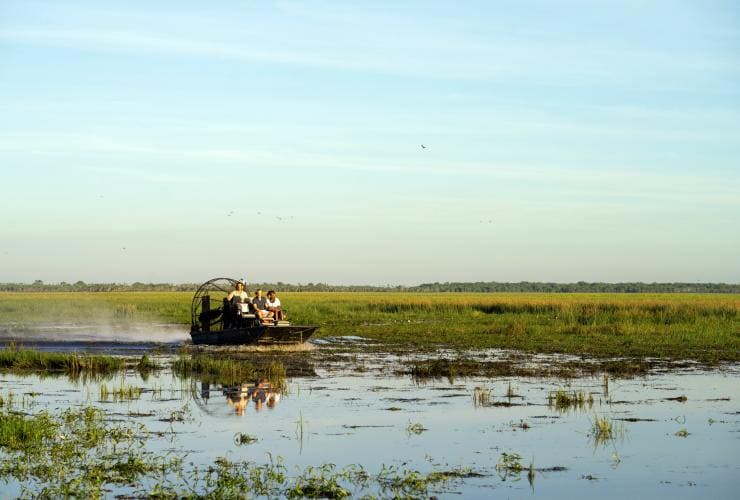
Tucked within 300sq km (116sq mi) of rugged natural beauty on the edge of Kakadu National Park , a stay at Bamurru Plains is nothing short of spectacular. The key attraction here is the airboat safari, which zips across the Mary River floodplains. Spot saltwater crocodiles, wild brumbies (horses) and buffalo before watching native birds take flight from The Hide viewing platform. Each luxurious lodge is curated to complement the history and environment of the area, paying homage to both Aboriginal and pastoral history.

Kings Creek Station offers a true Aussie outback experience, with beautifully rustic accommodation set on a working cattle farm 300km (186mi) from Alice Springs . Spend your days wandering the station's vast surrounds and wading in the welcome cool waters of the pool. Join a cultural tour to learn about the practices and cultures of the local Luritja and Pertame peoples, or take to the skies on a scenic helicopter flight over the magnificent Central Ranges. Choose from glamping, blissfully simple bush tents, or laid-back campgrounds.

A six-hour drive from Townsville , Gilberton Outback Retreat is set in a truly unique location, boasting beautiful Aboriginal rock art, an historic gold mining town and a thriving nature reserve. Once you’ve explored the treasures at your doorstep, get hands on at the working cattle station, try your luck at fishing or unwind among the wildlife and scenery of the Gilberton Nature Reserve. In the comfort of your farm-chic retreat, enjoy hearty home cooked meals and panoramic views overlooking Gilbert River from your private deck.

Resting at the foot of picturesque Mount Mulligan, this all-inclusive luxury stay provides the perfect balance of adventure and relaxation. Embark on incredible hikes, guided tours and thrilling ATV experiences, spotting wildlife and learning about the history of the region along the way. The main pavilion and sunset bar are the perfect options for an evening cocktail, and you can swap the walk there for a ride in your private buggy. A chartered helicopter is the best way to travel to and from Mt Mulligan Lodge, with daily departures from Cairns .

Embark on a scenic five-hour road trip from Adelaide to experience ancient landscapes, prolific wildlife, incredible food and supreme comfort at Arkaba Conservancy. With capacity for just 10 guests, this exclusive experience offers intimate wildlife safaris across 60,000 private acres. The conservancy is home to thriving communities of kangaroos, emus and other native wildlife. During your stay, visit sites significant to the local Adnyamathanha people, snap photos on a helicopter flight over Wilpena Pound and indulge in fresh, local food and wine.

It's easy to see why Home Valley Station in Kununurra was chosen as the set for Baz Luhrmann's iconic film ‘Australia’. Owned by the Balanggarra Aboriginal Corporation, the property is quintessential Aussie outback at its best, with natural beauty, rich cultural history and beautiful accommodation. Choose from a host of nature activities during your stay, including walking trails, horse riding, stargazing and sunset tours. The Balanggarra Home Valley Tour will take you past waterfalls, gorges and ancient landforms as you learn about the culture of the area.
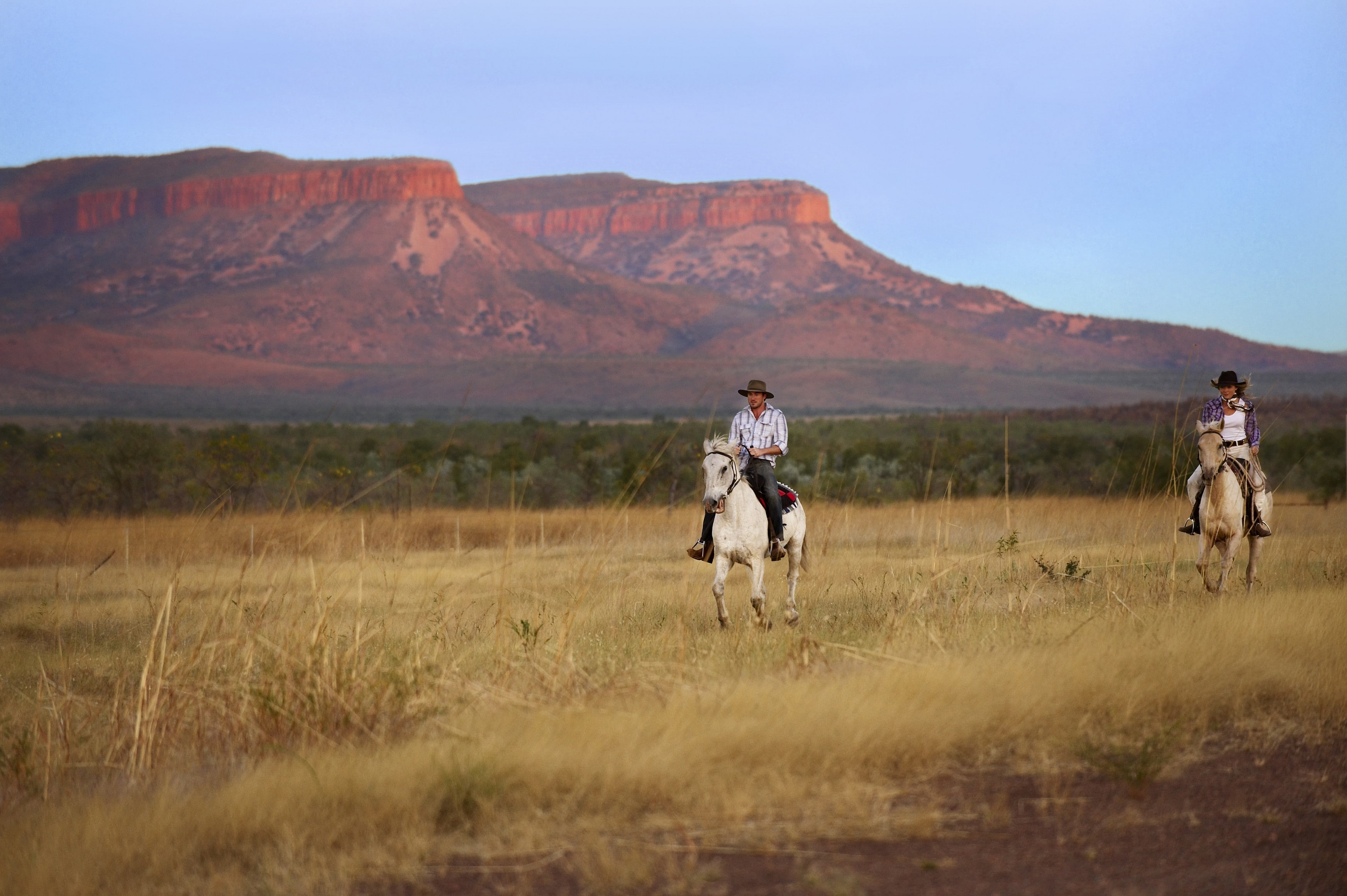
Home Valley Station
https://home-valley.com.au/

Ancient rock art, stunning waterfalls, authentic farm life and modern comfort just under three hours drive from Kununurra – there is no shortage of reasons to visit Bullo River Station. The impressive property is home to 3,000 cattle as well as wild buffalo, wallabies and dingoes. Experience a genuine outback lifestyle by getting involved in daily activities such as lick runs (cattle feeding) and muster training, or explore the landscape at your own pace. Cruise the serenity of Bullo River Gorge, embark on a fishing expedition and peer at the uninterrupted night sky through telescopes.

With rolling hills, towering elms and historic architecture, a visit to Waterloo Station is like stepping into a fairytale. Less than a four-hour drive from Byron Bay , the property has been carefully restored to retain its original homestead charm, offering luxurious lodgings from family affairs to more intimate abodes. Wander the acreage, keeping an eye out for deer and a variety of birdlife, and try your hand at sapphire fossicking, trout fishing or swimming in the creek. In winter, curl up by the fireplace with a book and enjoy the serenity.

A cruisy six-hour drive from Sydney , adventure awaits at Callubri Station. Lean into the simple pleasures of country living from your sun-filled suite before heading out on a tour of the property, spying emus, echidnas and kangaroos in your travels. Meander through the original timber woolshed, watch the action in the shearing shed and visit the residents in the livestock paddocks. Finish your day with a dip in the pool, indulge in a moon-bathing session or enjoy the tranquillity of the river lagoon on a row boat perfectly sized for two.

Exmouth may be most famous for its proximity to the magnificent Ningaloo Reef , but it is also home to rich and adventurous outback landscapes. One of the lesser-known treasures of this region is Bullara Station, a working cattle station sharing country fun in a truly dreamy location. Settle into a cottage, safari tent or campsite before diving in amongst the action. Watch the yearly mustering, taste fresh damper, get chatting around the fire or indulge in an outdoor shower beneath fragrant gums. Be sure to pull up a chair to meet some new mates over BYO (bring-your-own) happy hour.
More articles like this

We use cookies on this site to enhance your user experience. Find out more . By clicking any link on this page you are giving your consent for us to set cookies.
Acknowledgement of Country

We acknowledge the Traditional Aboriginal and Torres Strait Islander Owners of the land, sea and waters of the Australian continent, and recognise their custodianship of culture and Country for over 60,000 years.
- International (English)
- New Zealand (English)
- Canada (English)
- United Kingdom (English)
- India (English)
- Malaysia (English)
- Singapore (English)
- Indonesia (Bahasa Indonesia)
- Deutschland (Deutsch)
- France (Français)
- Italia (Italiano)
- 中国大陆 (简体中文)
*Product Disclaimer: Tourism Australia is not the owner, operator, advertiser or promoter of the listed products and services. Information on listed products and services, including Covid-safe accreditations, are provided by the third-party operator on their website or as published on Australian Tourism Data Warehouse where applicable. Rates are indicative based on the minimum and maximum available prices of products and services. Please visit the operator’s website for further information. All prices quoted are in Australian dollars (AUD). Tourism Australia makes no representations whatsoever about any other websites which you may access through its websites such as australia.com. Some websites which are linked to the Tourism Australia website are independent from Tourism Australia and are not under the control of Tourism Australia. Tourism Australia does not endorse or accept any responsibility for the use of websites which are owned or operated by third parties and makes no representation or warranty in relation to the standard, class or fitness for purpose of any services, nor does it endorse or in any respect warrant any products or services by virtue of any information, material or content linked from or to this site.
Outback gold rush towns: The fragile legacy of relying on a single industry
By Chris Lewis
Topic: Rural and Remote Communities
In a tiny town of 450 people in the West Australian outback, the last remaining butcher offers a simple explanation for his lifestyle: "I am mad".
"You get up when it's dark, you get home when it's dark," he says.
"I haven't had a holiday, ah, it's … I can't remember when."
Kent Lucy says it's been a struggle to find staff. ( ABC Landline: Chris Lewis )
Mount Magnet's Kent Lucy says he's the last butcher in the whole region "and the best looking one for 500 miles" but his cheery demeanour hides a concern for the region's — and his own — future.
"Trying to get people into … the outback is hard. People don't want to come here, especially the young ones," he says.
Western Australia's Murchison region flourished during the gold rush of the late 1800s and early 1900s.
Towns including Austin, Lennonville, Day Dawn and Big Bell — all about 650 kilometres north-east of modern-day Perth — were bustling with shops, hospitals and cinemas with populations ranging from 500 to 1,000 residents.
WA map from 1916 showing many more towns than a modern day map of today. ( Supplied: Wikimedia Commons and Cue Shire )
But they had one problem.
They relied on a single industry to prop them up — gold.
As gold became harder to find and prices started to fall, these once-thriving towns gradually emptied, becoming ghost towns.
Meanwhile, other gold towns like Meekatharra, Cue, Mount Magnet and Yalgoo have survived, but for how long?
With an ageing population, declining infrastructure and lack of funding, there are fears some towns may go the same way.
Big Bell was thriving. In 1955 the mine finished up and so did the town. ( ABC Landline: Chris Lewis )
Leveraging transport
Mount Magnet has hundreds of mining and haulage trucks running through it, creating a pressure point between large noisy trucks and those wanting a quiet place to live.
Tralee Cable says mining income is being replaced with transport. ( ABC Landline: Chris Lewis )
The Mount Magnet Shire is attempting to diversify by becoming a key transport hub, serving as a crucial junction for north-south and east-west trucking routes.
But shire chief executive Tralee Cable says the town's ageing infrastructure is struggling to cope with increased truck traffic, particularly in areas like accommodation and dining.
"There is much investment needed now for this community to be able to adequately support a heavily road-based transport system," she says.
Ms Cable says the shire is working through significant red tape to open an industrial estate, to allow haulage companies and truck drivers to see Mount Magnet as a viable changeover or rest stop.
"The shire anticipates development of this sort of support industry will bring much needed people back into this community, allowing us to once again thrive and prosper," she says.
Mr Lucy says he's got no plans to stop serving the community as it fights to survive, but his body is "falling apart".
He says finding staff has always been a struggle, despite the perks of the location.
"You've got the best skies at night, you've got the best days during the day and if you like going out in the bush, there's history everywhere," he says.
"It's bloody good fun here."
Enticing people to live in the outback
Eighty kilometres north in Cue, the population has dwindled from 10,000 at its peak in 1,900, to about 120 residents.
Cue Shire is hoping to turn the town's historic bank building into a bakery. ( ABC Landline: Chris Lewis )
Shire president Les Price says shires need to be proactive in encouraging more families to move and live in outback towns.
"We are on a very low population base at the present stage," he says.
"We don't have a lot of those opportunities that a lot of other shire councils have, particularly those in the metropolitan area."
Les Price says councils are left to keep towns going. ( ABC Landline: Chris Lewis )
The shire applied to the Department of Infrastructure's Growing Regions Fund, seeking $2.15 million for a recreational project that would include a minigolf course, go-kart track, playground and yarning circle.
"This is based around trying to create an environment that will be encouraging for families to come and live in the town, to be engaged in the town and have something for their children to be part of," Mr Price says.
Many historic buildings lay quiet and empty in Cue's main street. ( ABC Landline: Chris Lewis )
New residents could help Joyce Ramsay find a buyer for her Cue business, Queen of the Murchison Guest House.
She's selling due to health issues after a knee replacement.
"Because I am not able to maintain the same high standards of cleanliness and busy-ness that I wanted, I think it is time to pass the baton on to someone else," she says.
The shire has recently been notified it has not been successful in its recreational project funding application, but Mr Price says the team will look at other ways to still proceed by either scaling down or building in stages.
Professor Amanda Davies specialises in demography at the University of Western Australia.
She says one of the most significant challenges facing these remote towns is their historical reliance on one single industry and some communities just may not survive.
Professor Amanda Davies says regional towns need investment. ( ABC Landline: Chris Lewis )
"It's very likely that some of the communities across regional Western Australia won't make it," Professor Davies says.
"There needs to be really active planning for the decline of those and a conversation about what's going to be lost in terms of history."
Battling businesses
In Meekatharra, another 115km up the Great Northern Highway, business owner Amy Dickens has stepped away from her popular bakery saying it is too difficult to run on her own.
She says staff are hard to find and the long hours producing and baking goods as well as serving customers had taken a toll.
The building is owned by the Meekatharra Shire, which has been actively looking for new tenants since Ms Dickens left.
"In a small town like Meekatharra, having a bakery definitely makes a difference," she says.
Three hours to the south west, Yalgoo was once home to 7,000 people with seven pubs.
Today, the town's population is around 120 with a further 400 living throughout the shire.
Stan Willock owns the town's last remaining pub, but has had it up for sale for the past three years.
Stan Willock wants to retire after 30 years running the Yalgoo pub. ( ABC Landline: Chris Lewis )
"There's a couple of things that keep towns open," he says — a school and a pub.
"If the school shuts or numbers aren't good and if the pub shuts, I wouldn't hold much hope for the place.
"It's a place to come and meet and tell a few stories. If I close up, I know what will happen to the place. It will die."
The council has resolved to make a provision in its budget to consider making an offer to purchase the Yalgoo pub.
Millions of dollars out, what comes back?
Yalgoo Shire chief executive Ian Holland says an average of 500 trucks, carrying royalty-earning minerals, pass through Yalgoo daily.
Mr Holland says his shire receives less than 10 per cent of its annual funding from the state government.
But the shire regularly steps in to assist with what should be state issues including accommodation for state government employees like teachers, police and nurses.
Ian Holland says outback shires are carrying the load in investment. ( ABC Landline: Chris Lewis )
"When the community has issues with telecommunications, health, utilities, disadvantaged youth and numerous other issues, they do not turn to state government departments," he says.
"Because they feel out of sight and out of mind or aren’t even aware that a particular service is the responsibility of a state government department."
Yalgoo residents say people should experience the outback. ( ABC Landline: Chris Lewis )
Fly-in, fly-out mining has expanded throughout the region but the wealth doesn't always feed back into local towns.
Mr Holland says Yalgoo is fortunate to have two local mines contributing more to the maintenance and capital improvement of the shire than the WA government.
"I do not think it would be a stretch to work out if their mining royalties paid to the state are greater than the state's combined expenditure on police, education and health in the district," he says.
What will outback communities look like in 50 years?
Professor Davies says the key will be in balancing the preservation of history and culture with the need for economic adaptation in a rapidly changing world.
"Right across regional rural landscapes, throughout the developed world, we have similar trends occurring when towns were first established on a single industry, and that industry then shifts and changes," she says.
"These trends are evident across many rural communities, where once-thriving industries, such as mining or agriculture, have either become less labour-intensive or relocated entirely."
The remains of Big Bell church with graffiti. ( ABC Landline: Chris Lewis )
Professor Davies says diversification is crucial.
"If you can have two or three base industries in those inland communities, you then can have the other services and functions that are associated with that, such as education, health care, social services. But you need to have two or three, base underlying industries. And for that, some investment is required."
Professor Davies says the closure of essential services, such as schools and health facilities, is often the death knell for outback towns.
The remains of Big Bell church with the town's pub in the distance. ( ABC Landline: Chris Lewis )

IMAGES
COMMENTS
Across the country, you'll find lush rainforest, spectacular mountain ranges and, of course, the rusty red deserts Australia is famous for. Officially known as rangelands, the outback covers a whopping 81 per cent of the country, with almost every state offering unique outback landscapes and adventures. Experiencing the outback is much easier ...
Travel Guide to the Australian Outback - Travel Outback Australia. Mallee Shakedown - Exploring a Forgotten Outback Road. After a couple of near misses on the internet recently fate stepped in and I was contacted by ExpressVPN alerting me that a new…. 24 Inch Ultima Light Bar Satin Long & Wide Hybrid Beam.
A visit to Ulu r u takes the crown as the most famous experience in the Australian outback. Witnessing the majesty of this culturally significant site alone is a bucket-list tick, but there are also meaningful ways to delve deeper into the beauty and history of the red rock. Listen to the rich history of the local A n angu people on a guided ...
The closest places with facilities are Tennant Creek Caravan Park (100 km north) and Barrow Creek Motel (130 km south). 8. West McDonald Range. Ellery Creek in West McDonald Range. The West McDonald Range is only a short drive from Alice Springs and is a great place to explore.
Stretching from the rugged red earth of Mount Augustus and Kennedy Ranges in the north, to the sweeping snow-white beaches of Esperance and the southern coast, the majestic changing landscapes of Australia's Golden Outback will recharge your spirit and allow you the freedom to embark on unforgettable outback adventures. Esperance's stunning ...
Australia's best outback experiences. Wild nature, ancient culture and a vastness you can't capture in photos - Australia's outback offers a whole different kind of adventure. Find out more. We acknowledge the Traditional Aboriginal and Torres Strait Islander Owners of the land, sea and waters of the Australian continent, and recognise ...
With over 35 years experience in crafting authentic Queensland outback tours& adventures, you're assured of a memorable and highly personalised guided holiday with Outback Aussie Tours. Book Now. Experience the real Australian Outback with our award-winning Outback tours & adventures! Travel Outback Australia with true Outback Queensland locals.
The Australian Outback embodies the essence of all Australia landmarks.It covers roughly 6.5 million square km and has so many attractions for the adventurous traveller. The Outback Destinations are full of gorgeous open spaces, dazzling colours, challenging 4WD locations, rugged mountains, waterfalls, and plenty more.
Getting To The Outback By Bus. If you have time to get to Central Australia, but don't want to drive yourself, book a seat on a Greyhound bus. Busses leave from Darwin and Adelaide to travel to Alice Springs. The ride takes about 20 hours, but the seats are comfortable and there is a bathroom onboard.
Alice Springs. The first stop on the Red Centre Way itinerary is Alice Springs, a place that should be on any Australia bucket list. You can visit the Araluen Arts Centre to look at a collection of Aboriginal art or check out Aboriginal rock art at the Emily and Jessie Gaps Nature Park. Then you can choose to drive around, or simply hike or ...
Australian Outback Tours & Travel; The Australian Outback is steeped in Aboriginal history, the landscape part of the myth and legend known as the Dreaming ... during the tour so as to keep us safe and to ensure a good experience even with the worst fire season known in Australia unfolding throughout the nation in the summer of 2020. Some of ...
Experience the best of Australia's rugged outback and biggest city with this eight-day bucket-list itinerary. The fun starts in cosmopolitan Sydney, where you'll explore iconic sights, including the Opera House and Harbour Bridge, and walk the coastal Bondi to Coogee trail. Then, it's time to fly to the heart of Australia, landing in Alice Springs. You'll take a road trip across the outback ...
You can't visit The Outback without visiting Uluru, an iconic symbol that's been depicted on countless postcards and travel brochures for decades, considered one of the top places to visit in Australia. Lying in the heart of red rock country in the remote Uluru-Kata Tjuṯa National Park, the striking red monolith looms over the landscape at 1,141 feet, forming its centerpiece.
Melissa Australian Outback travel expert at TourRadar. 8-Day Adelaide to Uluru Tour. 3 Day Uluru Kata-Tjuta Kings Canyon (Camping) - from Alice Springs. 8-Day Uluru to Adelaide Tour. Uluru & Kings Canyon Adventure. 3 Day Uluru Red Centre Kings Canyon (Camping) - from Ayers Rock. Northern Territory Escape with Uluru Tour.
The Nullarbor. The Nullarbor is a true outback adventure, extending across Australia's southern edge from Western Australia to the Eyre Peninsula in South Australia. Wild, windy coastlines and red-sand deserts will show you just how vast Australia's outback really is, and wildlife like kangaroos and emus bring the scrubby plains to life.
The Desert Park is one of the Outback's best tourist attractions. The Desert Park reveals the Outback to you -its Aboriginal culture, its environment (you get to walk through every single desert habitat), its plants and animals. Make it your first stop in Alice Springs. Located 350km from Alice Springs and about 300km from Ayers Rock ...
The awe-inspiring Northern Territory, one of the best places to visit in Australia, is calling out to you! Give our destination experts a call 1-888-359-2877 (Mon-Fri 8:30am -5:00pm Central US) and experience Australia's Outback for yourself. REQUEST YOUR FREE CONSULTATION.
Days 11-14: Alice Springs. After a relatively quick, scenic flight from Darwin to Alice Springs (seriously, snag yourself a window seat for this one), we arrived in the heart of the 'Red Centre' of Australia, and the final destination on my Northern Territory Outback itinerary. Window Seat Views flying over the Red Center.
Marvel at the Bungles Bungles. Created over 20 million years ago, the Bungles Bungles is one of the Outback's most remarkable landmarks. It's also a highly sacred site for the Karjaganujaru and Gija peoples. Wind through 200-metre-tall gorge walls, explore a maze of beehive-shaped rock domes and test out your singing skills in a natural ...
The Outback Way is Australia's Route 66, the great Australian Road Trip… unearth the magic and immerse yourself in a journey like never before. ... Order the essential Outback Way Travel Journal with planning pages and journaling pages so you can keep the Travel Journal as a momento. The 10 sections reflect our APP and provide maps and ...
At About Australia, we specialize in curating bespoke travel experiences that delve into the heart of Australia's awe-inspiring Outback. Our team of travel experts is passionate about designing the perfect itinerary tailored to your preferences, ensuring every detail is meticulously planned. Explore the iconic Red Centre, where ancient rock ...
Buy a GPS with satellite navigation, or hire one from your car rental company. Hiring a satellite phone is a good idea if you are heading off the main road network. Embark on the ultimate adventure through the Australian outback. Hit the road with confidence with these simple tips on how to plan for an outback road trip.
A few of the better-known areas which constitute a part of the Outback are Alice Springs, Kakadu National Park and Ayers Rock in the Northern Territory, Broken Hill in New South Wales, Broome in Western Australia and Flinders Ranges in Queensland which gives you an idea geographically just what is the Australian Outback. At a Glance.
Inland areas can get hot, especially in places like the Outback, where temperatures can soar above 40°C, so planning and preparation are essential. Peak Season vs. Low Season Travel . Summer is the peak travel season in Australia, particularly around Christmas and New Year.
Kings Creek Station offers a true Aussie outback experience, with beautifully rustic accommodation set on a working cattle farm 300km (186mi) from Alice Springs. Spend your days wandering the station's vast surrounds and wading in the welcome cool waters of the pool. Join a cultural tour to learn about the practices and cultures of the local ...
In a tiny town of 450 people in the West Australian outback, the last remaining butcher offers a simple explanation for his lifestyle: "I am mad". "You get up when it's dark, you get home when it ...